The summit push on GII was aborted due to bad conditions, and the expectations for Broad Peak and K2 are equally discouraging.
However, a few stubborn climbers are willing to wait for a possible weather window at the end of July.
No one wants to surrender first
"The expeditions will officially end on August 2, but our teams on K2 and Broad Peak are [already nearly finished], as the situation seems not so good," Lakpa Sherpa of 8K told ExplorersWeb.
Nepal-based blog Everest Chronicle stated that Elite Exped has called off its expedition, and leader Mingma David Sherpa will have to wait another year to break his own record by summiting the mountain for the seventh time. As Lukas Supergan wrote on Saturday, no outfitter wants to be the first to call the expedition off.
"Several Sherpas have sustained climbing-related injuries, but their agencies are not discussing this publicly," the Polish climber added.
K2 climbers need at least acceptable conditions for the Sherpa guides to fix ropes and set higher camps, but the weather is not cooperating. Conditions have been bad all season. Already, one Pakistani climber has died.
Heavy monsoon rains are hitting northern Pakistan, wreaking havoc at several places in Gilgit-Baltistan. As we posted last week, a hanging bridge at Shigar collapsed, cutting off the route back to Skardu. Even if climbers leave, they may have difficulty getting out.
K2
"It's 3 degrees at Base Camp at 8:30 am," no-oxygen Everest summiter Lenka Polackova of Slovakia reported.
She adds that water continues to drip at 6,200m, and she has experienced rockfall even near 7,000, the highest she's reached.
However, most climbers believe that better weather is coming at the end of the month, after the current snowy spell. But will conditions on K2 be stable enough, and will the climbers -- stuck in Base Camp for so long -- be prepared?
Good weather and colder temperatures could stabilize K2. Then, perhaps, some very strong climbers could launch a last-minute summit push if they manage to pitch a couple of tents on Camp 3 and head up right behind the rope fixers. But it's a long way from Camp 3 at 7,000m to the 8,611m summit. Climbers planning to proceed without oxygen have a nearly impossible mission ahead, especially if they are not acclimatized enough.
Gasherbrum II
On Gasherbrum II, Imagine Nepal launched a summit push from Camp 2 on Saturday night, but eventually retreated because of deep snow. They safely returned to Base Camp today, and leader Mingma G bluntly stated: "Gasherbrum II will remain unclimbed in 2025."
Nirmal Purja of Elite Exped is also on Gasherbrum, but the company has not yet spoken of its plans.
Meanwhile, Selena Khawaja of Pakistan, just 16 years old, is aiming to climb Gasherbrums I and II with her father. The young Khawaja has been attempting 8,000'ers -- and raising concerns because of her young age -- since she showed up on Broad Peak in 2021 at age 13.
Last year, the Khawajas attempted Nanga Parbat. This year, before heading for the Gasherbrums, Selena and her father climbed Khosar Gang, a 6,004m peak near Skardu. They arrived at Base Camp on Friday after dealing with tough conditions due to heavy rains during the trek up the Baltoro.
Broad Peak
On Broad Peak, Madison Mountaineering's sole client and its Sherpa team are still in Base Camp waiting for a weather window. They will need better conditions and a more collaborative atmosphere amid growing tensions between climbers and outfitters on the mountain.

"Opening a route to the summit requires crossing deep snow above Camp 3," Lukas Supergan wrote on Saturday. "This could be achieved by a large, combined team from agencies and independent climbers working together, but such cooperation is not there. Leaders keep their plans secret; groups set out despite obviously bad forecasts and return exhausted and resigned. Each agency wants to be the one at the top, but by acting alone, it reduces its chances. Joint action has been replaced by a lack of communication."
Wrote Vibeke Andrea Sefland: "It is getting warmer and it is melting more day by day. On top of this, we have had several days with heavy snowfall up high, and rain below 6,000m, giving us hip-deep snow to break trail through."
The Norwegian climber and her group said they are going to wait a little longer, but the situation is complex. "I will do my best, but in these conditions, the only way to manage is [for] all of us to get together in a good team effort."
Time is running out for climbers on the Karakoram 8,000'ers because of stubbornly bad conditions. Yet a few equally stubborn individuals are fighting to summit before the season ends.
GII push
Summit Karakoram, the local company outfitting 8K Expeditions and Imagine Nepal teams, reports that their climbers on Gasherbrum II have started for the top. "We are planning to reach the summit on July 27, contingent on favorable weather," they noted. Other teams could follow.
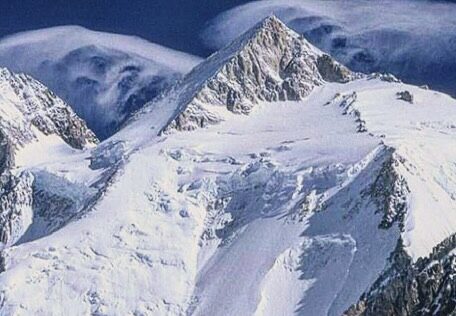
Broad Peak problems
In contrast to K2, where all teams seem to be coordinating their efforts, the situation on Broad Peaks looks chaotic. Climbers have gone up and down at their own pace, sometimes in bad weather or despite contradictory forecasts. Today, nearly everyone is in Base Camp, checking weather forecasts but fully expecting to leave shortly.
But not everyone. Charles Page of Canada went up yesterday to 7,600m -- about the altitude of the Broad Peak col -- before turning around, according to his tracker. In previous reports, Page wrote that his goal was K2.
Litter, and no progress
Yet the weather is not the only source of tension in Base Camp. Vibeke Andrea Sefland of Norway, back from a rotation to the top of the fixed ropes, describes Camp 3 at 7,000m as a "tent graveyard" with large amounts of trash. Climbers every season share similar comments about this spot.
On July 21, after a night in Camp 3, Sefland and other climbers descended back to Base Camp. That day, they crossed paths with another small group on their way to the summit despite bad weather forecasts.
"[On the way down,] we had to wait at least an hour in C1 to let climbers come up due to the risk of kicking rocks at them...We were wondering why they are [on a] summit push. The weather forecast is bad, and there are no fixed ropes and not enough manpower to break trail."
The Norwegian climber also noted how alarmingly fast the snow was melting. They had problems crossing a swollen glacier river and rappelled down "in waterfalls which should have been icefalls."
The management of the ropes is also a source of conflict in Base Camp.

As posted on social media, Karakorum Expeditions is in charge of fixing the ropes on the mountain. Climbers complained to ExplorersWeb about KE's leader Mirza Ali's lack of transparency about how and when the ropes will be fixed to the summit. These climbers say they have offered extra money and to help carry the loads. The uncertainty remains. The frustrated climbers have asked to remain anonymous until the expedition finishes and they are safely out of the country.
Karakorum Expeditions last reported on July 20 about the rope fixing:
Season's end
Whatever teams do, they must do it soon, as the season officially ends at the end of July. The problem in Pakistan is not the pending expiration of permits but the weather.
"Permits usually last for 60 days, so teams could remain for longer in Base Camp if they wished," sources from Pakistan Alpine Club told ExplorersWeb.
However, the weather typically becomes more unstable by the end of July, and the monsoon's influence makes climbing too hazardous in August. That is why high-altitude Karakoram expeditions take place in July.

However, changing weather patterns have not helped. As we reported yesterday, the monsoon has already caused serious flooding in northern Pakistan. It is likely that future expeditions will have to adapt to climate change by starting earlier.
Bad weather has thwarted all attempts to reach the summit of Broad Peak and diminished hopes for K2 climbers, especially since the worst of the storm is yet to come.
Further down the valley, the consequences of the heavy rains are catastrophic. The Baltoro has been isolated since floods swept away a suspension bridge in Shigar.
K2 summits in peril
"A major storm is approaching K2, bringing heavy snow, strong winds, and freezing temperatures," Mingma David Sherpa of Elite Exped wrote today. He and his team remain in Base Camp, ready to ride out the storm and wait for the mountain to improve afterward before making a decision.
If the situation is dire for guided climbers, it is worse for those without oxygen. Santiago Quintero of Ecuador, who was climbing with Sajid Sadpara of Pakistan (also no-O2), has cancelled his attempt. Quintero and Sadpara had done two rotations. Both times, but especially on the latest trip up to Camp 2, they had several close calls with falling rocks.
"The peak cannot be climbed at present, [in these] highly dangerous conditions," Quitero noted. "It's a deadly gamble, and without a proper Camp 3 and a complete acclimatization, it makes no sense to try."
Quitero admitted the only option would be to buy four bottles of O2 and a porter to carry them up, but he does not have that extra $6- $7,000. "In addition, I don't want to risk an accident," he noted.
He managed to return to Skardu, although some trails are blocked or flooded at the moment.
Same on Gasherbrum II, Broad Peak
A small group of climbers summited Gasherbrum I last week, and Nirmal Purja followed with regular client and Qatari royal Asma Al Thani and a strong support team. However, no one has summited GII this season. The mountain has no fixed ropes, and some teams are reportedly giving up.
Charles Dubouloz of France has done two rotations in the Gasherbrums with climbing partner Symon Welfringer. Over the last few days, they have endured everything from scorching heat to near-constant snowfall. Yet he still hopes to launch an alpine-style push on one of the peaks in the region. They have not confirmed their specific plans, but a previous post by Welfringer suggests they could be willing to return to their original goal of the west face of Gasherbrum IV, if conditions improve.
On Broad Peak, bad weather thwarted the few climbers who launched a summit attempt. Madison Mountaineering reported that their small group (a client with two Sherpa guides) and three other similarly sized groups tried to break trail in fresh snow but turned around before reaching the Broad Peak col because of a storm and whiteout conditions.

Altitude thieves
To make things worse, climbers are reporting thefts in the higher camps again this season. Climbers and staff use others' tents -- that's normal and okay as long as they ask permission -- but the camp crashers also reportedly stole gear, fuel, and food.

"Losing even a small item can mean that a year of preparation, thousands of dollars, and a 1.5-month expedition will be wasted because the equipment needed on summit day has disappeared," Lukasz Supergan reported.
He also mentioned a specific case: "Two weeks ago, my friend's crampons disappeared from his tent. It transpired that a Nepalese guide had taken them and used them for 10 days. After a brief investigation, I found them in his agency's tent," Supergan said.
He added that some people who had recently gone up to the summit "despite the obviously bad forecast," used their tents in Camp 3.
Finally, he also reported problems with a different type of thief: Crows pecked holes in one of his tents and ate all the food.
Gilgit-Baltistan disaster area
Unless conditions improve quickly, we might end up seeing a season without summits on K2, Broad Peak, and Gasherbrum II. Conditions are only expected to worsen, and the teams are approaching the end of their planned stays. Both their climbing permits and the period that they have contracted with the agencies will expire soon.
That's frustrating for climbers, but the heavy rains have disrupted daily life for the local communities down the Baltoro.
This year, the monsoon has slipped into normally dry northern Pakistan. Floods and landslides have stranded thousands of locals and travelers in Gilgit-Baltistan. Even the Karakoram Highway is blocked at some points.
The situation is particularly serious in Diamir, near Nanga Parbat. At least six tourists have died in landslides near Babusar Pass, and many others had to be rescued and taken to Chilas, where authorities and local hoteliers are putting them up, Dawn reported.
"Moreover, river erosion caused the collapse of the Hotu suspension bridge in Shigar, cutting off the only access to K2 Base Camp," the paper noted. "A large number of foreign expedition members and trekkers were stranded, while eight villages were also disconnected."
On Tuesday, Al-Jazeera published a tally of 21 people killed by flash floods in northern Pakistan and at least 200 more rescued during this rainy spell.
Dani Arnold, Alexander Huber, and Simon Gietl have opened a difficult, 1,300m route on the east face of Jirishanca, in Peru's Huayhuash range, that may be one of the most significant climbs of 2025. The trio completed the 31-pitch climb in a single, alpine-style push between July 13-15.
Hummingbird's heartbeat
Gietl of Italy, Huber of Germany, and Arnold of Switzerland made two bivouacs on the wall and reached the east summit (6,028m, according to their GPS) at 9:15 am on July 15, the third day of the climb. They explained that climbers no longer attempt Jirishanca's main summit because of very poor snow conditions and high objective risk.
They named their route Kolibri, a translation of Jirishanca into German. Jirishanca means "hummingbird" in the Quechua language. According to author Jeremy Frimer, the name of the peak might refer to the spiky summit, likening it to the beak of a hummingbird. Climbers' heart rates might also mirror a hummingbird's when looking at the vertiginous southeast side of the mountain.
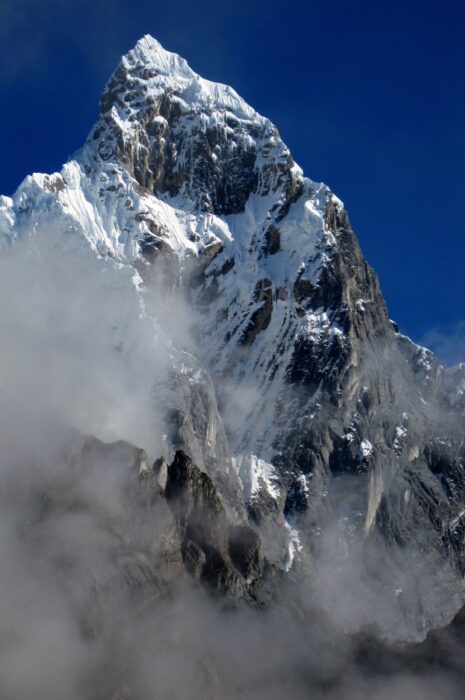
Great conditions
The Huayuash range is special. It is the only limestone range in the world with peaks surpassing 5,000m.
"The quality of the limestone is unique: solid, rough, and grippy," the team said. "We found a beautiful and logical line on the best rock. The conditions on the wall were ideal, and the teamwork was perfect."
Route report
We asked the climbers for details of a climb they described as "steep, technically demanding, and combining alpine seriousness with classic line selection."
Here is a complete report by Simon Gietl, and some notes added by Alex Huber.
The route begins on the lower part of the wall with slabby, sometimes overhanging passages that are often difficult to belay. This is dominated by technically demanding pitches with runouts in places that must be free-climbed up to grade 8 and occasional technical passages up to A2.
The middle section of the new route first follows the striking ice ramp of the Italian route, and then follows a direct line of cracks and intersections in the upper part of the wall, until it reaches the steep east ridge -- and the route of the first ascenders (Egger/Jungmair, 1957).
Serious endeavor
The climbers have estimated the route's difficulty at 8 (UIAA grade), A2. They assess the climb as a serious endeavor that demands high technical standards and alpine experience.
"The route is characterized by clear, elegant lines, excellent rock, and a varied wall structure. There is highly demanding wall climbing in the lower part, followed by classic crack climbing on the upper part of the wall up to the east ridge on snow and ice. Wedges, Friends, and micro-cams are essential."
The team was delighted with the climb. "For us, this line is one of our greatest first ascents, a gift from Mother Nature," Gietl told ExplorersWeb.
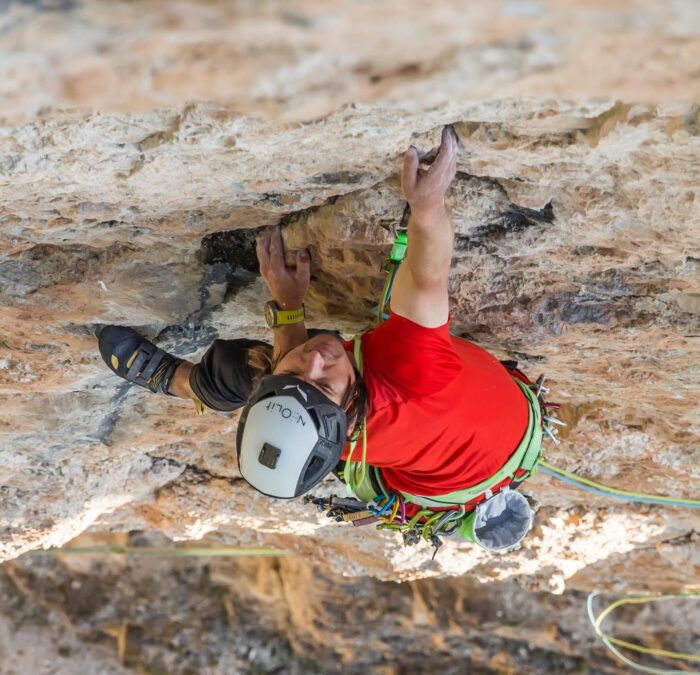
Between historical routes
In 1957, Jirishanca was the last 6,000'er to be summited in the Huayhuash range. Since then, it has attracted some of the best climbers in the world.
"Kolibri runs between the French and Italian routes," the team noted. "In the central section, we decided to follow the Italian route for three pitches (the Italian Ramp) before returning to the direct pillar between the French and the Italian route."
After the second bivouac, on their way to the summit on July 15, Arnold, Gietl, and Huber followed Tony Egger and Siegfried Jungmair's route, which was used during the peak's first ascent.
The 1957 team deemed the southeast face impossible and instead followed the peak's east spur, in heavy expedition style. Their route is now called the Austrian route. Egger died 18 months after climbing Jirishanca, on Patagonia's Cerro Torre.
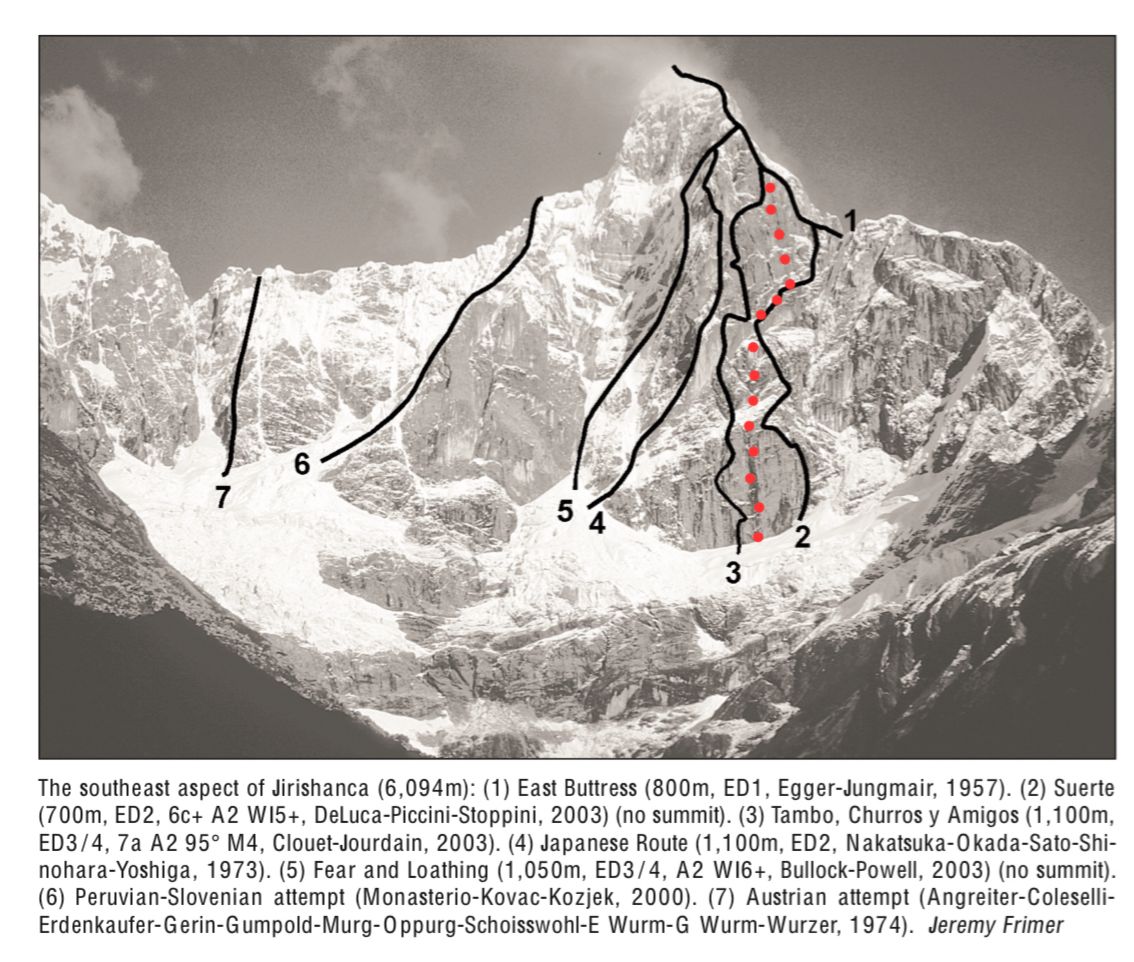
The French Route (actually called Tambo, Churros y Amigos) was the second line opened on Jirishanca from the east. Clouet and Jourdain climbed the peak in 2003 -- not in alpine style but without using bolts, which was quite a feat at the time on such a difficult face -- progressing up the main pillar on the southeast face.
Also in 2003, Italians Stefano DeLuca, Paolo Stoppini, and Alessandro Piccini climbed the Italian Route. They placed nearly 40 bolts on the wall and stopped where their route joined the Egger/Jungmair route, calling the incomplete route Suerte (luck). The complete route was finally free-climbed in 2022 by two Americans: Josh Wharton and Vince Anderson. They made the summit in three days without bolts. You can read their report here.
You can read Frimer's article in the American Alpine Journal about the climbing history of Jirishanca here.
Anxiety gnaws at climbers on K2 and Broad Peak; conditions are still bad, rope-fixing work is seriously delayed, and the season is approaching its end.
This means that, for another year, there will be little or no chance to space out summit pushes. Instead, everyone on the mountain will probably go up at the same time. Fortunately, there are not that many climbers this year.
No-oxygen climbers may need to make some hard choices, particularly if the summit push timing finds them short of acclimatization.
Why the delay?
These days, the normal Abruzzi Spur route on K2 is climbed in commercial style, and Nepalese Sherpas complete the rope-fixing work, hired by international expeditions. The Sherpas are usually supported by Pakistani climbers. This year, bad conditions -- rain, snow, high winds, and rockfall -- have delayed the work.

Mingma David Sherpa, leader of the Elite Exped team, reported that he was stuck in Camp 1 for three days last week. He had stopped there because, contrary to the weather forecasts, there were storms and high winds on the mountain every afternoon. He reached as far as Camp 2 before retreating to Base Camp.
Last weekend, Mingma G and his Imagine Nepal team linked up with Madison Mountaineering's Sherpa staff and managed to get a little higher. "We fixed the rope to 7,200m, crossing the rocky section below Camp 3. Next will be the summit push on K2, depending on weather conditions."
Summit push or return home
The question is whether a summit push is a sensible option for those climbers who need more acclimatization.
"We could discuss why the damned ropes have not been fixed yet, but that is not going to solve the problem," wrote Serge Hardy of France, one of those who planned to climb without oxygen, but using the ropes and trails.
Hardy reported that he has done two trips to 7,000m (probably to the end of the ropes) across the Black Pyramid. "The fact remains that without at least one night at Camp 3 (7,300m) and a descent to recover, it's going to be pretty tough to even consider an ascent without oxygen," Hardy concluded.
Late July push
"Base Camp has split into two: those who leave and those who stay," Hardy said.
Madison Mountaineering reported a warm, sunny day in K2 Base Camp on Tuesday, but clouds are gathering again, and the forecasts show more bad weather coming. Lukasz Supergan (currently on neighboring Broad Peak) recently wrote that the next possible weather window is not expected until July 27-30.
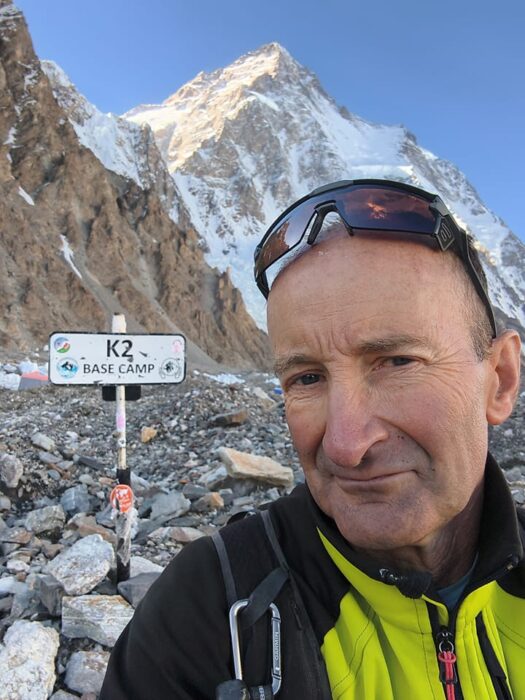
As for Hardy, he's among those ready to stay. "If the prospect of a last-ditch push looms, while treading carefully on loose rocks and putting my brain into 'avalanche detector' mode, I'll give it a try," he said. "It's a question of principles...because that's what we're here for."
We are waiting for news about other K2 climbers planning no-oxygen ascents, such as Israfil Ashurli of Azerbaijan and Csaba Varga of Hungary.
Italians Dario Eynard, David Bacci, Giacomo Meliffi, and Enrico Bittelli are off to open a new route in Canada's Cirque of the Unclimbables. This cluster of remote, vertical granite walls is, in the words of Pat Goodman for the American Alpine Journal, actually very climbable. The walls offer excellent rock, incredible atmosphere, several levels of difficulty, and near-endless potential new lines for those who don't mind a long trip and isolation.
Cirque of the Unclimbables, Canada. Photo: Dario Eynard
An adventurous return
After the climb, the Italians will paddle down the Nahanni River for roughly 500km in packrafts. They are carrying the inflatable boats folded into their backpacks.
This ingenious means of transportation is an increasingly popular choice for exploratory climbing expeditions to remote areas. Packrafts are light, portable, sturdy, easy to navigate, and eco-friendly, as the boats are human-powered.
It is not clear exactly how the climbers will reach the MacKenzie Mountains, roughly 500km west of the city of Yellowknife in Canada's Northwest Territories. Usually, climbing teams charter an aircraft from Whitehorse to Glacier Lake and then hike for around seven hours.
The team during a packraft training session. Photo: Dario Eynard
A pure approach
A 1995 expedition to the area by Stefan Glowacz, Kurt Albert, Gerd Heidorn, and Leo Reitzner inspired the Italian team. The 1995 German expedition had opted for a "purer" approach to the massif, without the use of aircraft. They combined paddling in canoes with hiking sections. Here is a summary of that expedition published by the American Alpine Journal:
"[The team] parked their rental car at Flat Lakes, near the Tungsten Mine in Yukon Territory, then paddled canoes down the Little and South Nahanni rivers to the confluence of Brintnell Creek for approximately 80 miles [129km], before setting off on another 13 miles [21km] of rugged foot travel. Their exit strategy would be to follow the overland path back to the South Nahanni River, where they would paddle another 250 miles [402km] to reach the Liard River. While in the Cirque, they established Fitzcarraldo (V 5.12b) on the north pillar of Mt. Harrison Smith, thus becoming the first group of modern climbers to eschew air support to open a big-wall route in the Cirque of the Unclimbables. Yet their loads included many pounds of bolts -- they placed 50 on the 16-pitch route."
The Madison Mountaineering team has announced a summit push as their team leaves Base Camp on Broad Peak. However, they have not provided even a tentative summit date, given the unclear weather forecasts and delayed rope-fixing work.
This year, Madison Mountaineering is focusing most of its efforts on K2, and has just one client, supported by a Sherpa team, on Broad Peak. Earlier today, the client and their Sherpas departed for Camp 2 and plan to reach Camp 3 tomorrow, weather permitting.
No-O2 climbers
Lukasz Supergan of Poland, climbing without supplementary oxygen, is on the opposite timeline: he reached Camp 3 last weekend and returned to Base Camp yesterday. According to the forecasts he is using, weather conditions will remain bad for the next few days. "There is a possible window from July 27 to July 30," he noted.
Lukasz Supergan on Broad Peak. Photo: Lukasz Supergan
Vibeke Sefland of Norway, also without oxygen, followed a similar itinerary on her second (and final) rotation before the summit push. On Sunday, she reached Camp 2 at 6,100m in "wet, slidy snow." Yesterday, she continued toward Camp 3 and then retreated to Base Camp.
Laura Mares of Romania also spent a night in Camp 2 last weekend, reached Camp 3 the following morning, and returned to Base Camp when bad weather settled on the mountain again.
Teams on Broad Peak and K2 are reporting poor weather, though it is not too cold. Rains are frequent this year at Base Camp.
No ropes on the ridge
It is also worth bearing in mind the state of the ropes. Karakorum Expeditions has a team on the mountain, carrying ropes to fix the final sections, and mending some anchors between Camp 1 and Camp 3 that have become loose over the last two weeks of bad weather.
A rope-fixer with Karakorum Expeditions on Broad Peak. Photo: Karakorum Expeditions
Karakorum Expeditions say they have repaired the route up to Camp 3. At approximately 7,000m, it is usually the uppermost camp set on Broad Peak. They have also stocked bottles of oxygen there.
However, there is still a long way to the summit. The route goes up from Camp 3 to a big col, and then follows a very long ridge across several ups and downs and secondary points, until it reaches the main summit. Commercial teams need most of these final sections to be fixed with ropes. Otherwise, they can get stuck, as happened in 2021 with tragic results.
Karakorum Expeditions also plan to start their summit push this week, after one or two days' rest in Base Camp. With them is Sabrina Filzmoser, supported by Zaman Karim. According to the team's latest update on Sunday, they were in Camp 3.
Denis Urubko of Russia and Maria Cardell of Spain have finally shared details of their new route on Nanga Parbat.
The couple took it easy after climbing from the Diamir side; in a very Urubko-style move, they remained an extra week in Base Camp, enjoying the solitude of the mountain. It was only yesterday, as they returned to Skardu, that they checked their emails and shared details of their line.

Difficult, exposed, lonely
They opened their route between July 6 and July 10. It combined varied terrain, with ice, mixed rock, snow, and a crevassed glacier, Urubko told Mountain.ru. He explained that the route is technically difficult and exposed to avalanches and rockfall in some sections.
In addition, the climbers went up in far from ideal weather conditions, with storms every afternoon and winds as high as 90kmph.
"We didn't use other people's ropes or tracks," Urubko told Mouintain.ru. "There were no breakdowns, injuries, or illnesses."
Indeed, they were the only people on that side of the mountain and, when the climb took place, they were the only people anywhere on the mountain. This season, summits on the normal route (the Kinshoffer) occurred on July 3 and July 4. David Goettler of Germany and French climbers Tiphaine Duperier and Boris Langenstein summited from the Rupal side on June 24.
You can read Urubko and Cardell's full report on Mountain.ru in Russian.
Crossing previous lines
Shortly after Urubko published a topo of the route, some members of the climbing community shared comments on social media pointing to the similarity of the line to previously opened routes. In particular, some pointed out that the route seems to coincide with a line opened in 2009 by Gerfried Goeschl of Austria and Louis Rousseau of Canada.

Urubko did note in his report that their route intersects the Austrian-Canadian route at around 6,600-6,800m. "But [our route] continues along the ridge, while the other team went along the glacier," he explained.
Asked by ExplorersWeb, Cardell confirmed the information from Pakistan: "Our route does not step on the Goeschl/Rousseau route at any section; both lines cross, but then the Austrian-Canadian route continues along the glacier and our line follows the ridge," Cardell said.
Cardell noted that she spoke to Rousseau before the expedition, and the Canadian climber shared information about his 2009 expedition alongside Goeschl (who later perished while attempting winter Gasherbrum I). Therefore, Urubko and Cardell were well aware of the location of the 2009 route.
"For a person not familiar with the terrain, it may look like it is the same line, but the distance between both routes is wide; everything else is speculation," Cardell said.
Many teams have climbed Nanga Parbat from its Diamir side. Crossing and/or following small sections with previous lines doesn't make Urubko and Cardell's feat any less impressive.
Female first
The achievement is especially significant for Maria "Pipi" Cardell. She is a ski patroller by profession and a member of Spain's elite female alpinism team. According to Urubko, Cardell is the first female climber to summit an 8,000'er via a new route opened in alpine style.
Urubko and Cardell took turns to lead during the climb, and in some sections they simul-climbed (progressed roped up at the same time, without belaying one another).
"It is an elegant and logical line, technical to a point that took me to my physical and mental limits," Cardell wrote. "I am not euphoric after the achievement. On the contrary, I feel calm...all the past efforts fit like pieces of a puzzle. Our dream is complete."
A solid pair
Cardell was enthusiastic in her praise for Urubko. "It is surreal to see how confidently he climbs in extremely complex terrain at high altitude," she said. "His intuition is based on wide experience, and his ability to obsessively focus becomes our guarantee of survival. [Added to his] supernatural strength at 8,000m, this makes him unique."

"Denis [Urubko] and I have been climbing together for ten years," Cardell wrote on Instagram. "We have been working and training all this time to get ready and, someday, achieve this dream."
Together, they have opened new routes, alpine style, on Chapayev (in the Tien Shan) and Ushba (in the Caucasus). They attempted a new route on Gasherbrum II in 2019, but Cardell had to drop out after injuring her back. Urubko soloed the route, naming it "Honeymoon" in tribute to Cardell. They also attempted a new route on Gasherbrum I, but eventually climbed via the normal route because of bad conditions.
Through the years, Urubko has been a methodical and very tough coach for iron-willed Cardell. "It has been training and more training...drytooling, climbing, running to exhaustion, learning new techniques and adopting new habits, don't drink, cry often, feeling utterly happy at every little step ahead, hesitating until finally managing to believe in myself and, never, never surrendering," Cardell said.
Forget-me-not
The pair has named the new route Незабудка (Nezabudka), meaning "the unforgettable girl." It is the Russian name of a flower known in English as the forget-me-not or scorpion grass. Under the Latin scientific name Myosotis and with some 60 variants, it is a small mountain plant that grows delicate flowers, generally blue, soon after the snow melts in alpine ecosystems. It is the official flower of Alaska. The relatively low altitude of Nanga Parbat's lower slopes allows grass and flowers to grow in Base Camp, especially during this relatively warm season.
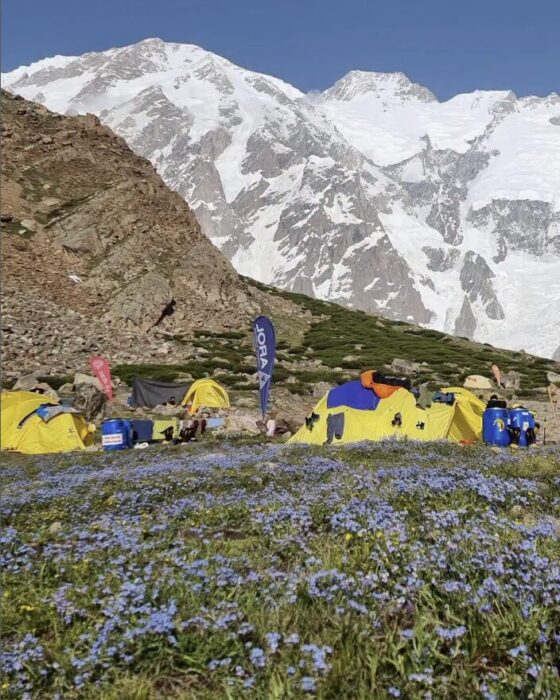
Several teams summited Gasherbrum I on Sunday from 11 am local time. Some climbers reached the top without supplementary oxygen, as this peak has traditionally been climbed, while others used bottled gas.
According to reports, 8K Expeditions placed Pavlo Sydorenko of Ukraine and Magdalena Arcimowicz of Poland on top, supported by Migma Dorchi Sherpa and Pem Lakpa Sherpa. The Nepalese climbers did not use supplementary oxygen.
Seven Summit Treks reported that Marco Confortola of Italy summited without supplementary oxygen, but was supported by Pasang Ngima Sherpa and Lakpa Tashi.
Two climbers outfitted by Active Adventure Holidays summited without supplementary oxygen: Marie Saame of Estonia and Abid Baig from Hunza, Pakistan. Baig summited Nanga Parbat and Broad Peak last year.
Imagine Nepal also reported summits, including Sashko Kedev, who has become the first Macedonian climber to complete the 14x8,000'ers. Wang Zhong of China and Nepalese climbers Dawa Gyalje Sherpa and Ngima Nuru Sherpa also topped out.
Gasherbrum I (8,080m), also known as Hidden Peak, is the first Karakoram 8,000'er summited this year. The teams in place may attempt Gasherbrum II next.
K2's somber face
On K2 and Broad Peak, bad conditions have stopped any progress by the rope-fixing teams. Expedition leaders are starting to show some concern about the lack of remaining time and possible weather windows.
Last Friday, an avalanche hit a team of four climbers who were descending from Camp 2, killing one of them. Rescue teams could not save Iftekhair Hussain Sadpara, an experienced local climber who had previously summited K2 twice, Broad Peak, and Gasherbrum II. He leaves a wife, two daughters, and a son, Ali Saltoro of Alpine Adventure Guides Pakistan told ExplorersWeb.
Trango Towers
Conditions this year may be better at lower altitudes, such as on the rocky spires of the Karakoram. An Indonesian team will try their luck on Trango's Nameless Tower (6,239m). The six-member team, led by Iqbal Kamal Fasya, will climb the Eternal Flame route to celebrate the 80th anniversary of Indonesia's independence. They will reach Base Camp today.

High-altitude worker Iftikhar Hussain of Pakistan lost his life on K2 yesterday in an avalanche that caught a four-member group while they descended from Camp 1 to Base Camp.
The slide took place at around 12:30, local time, on Friday. The avalanche hit Hussain, Dawa Finjo Sherpa and Dawa Geljen Sherpa from Nepal, and high-altitude porter Niaz Ali from Skardu, Dawn reported. They are all members of the Mountain Professionals team.
It is not clear whether the accident involved rockfall, a snow avalanche, or a combination of both.
No other teams affected
A ground rescue team was immediately dispatched from Base Camp to help the climbers. Sadly, there was nothing the rescue team could do to save Hussain's life. The other three team members were able to descend under their own power.
Ryan Waters, CEO of Mountain Professionals, confirmed the news to ExplorersWeb:
Hussain, one of the porters supporting our team, who was contracted through a local partner, tragically lost his life. We are deeply saddened by this loss, and our thoughts are with his family and the local climbing community in Pakistan.
Our international guide and clients were at Base Camp at the time of the incident and are all safe. Some of our support team members were higher on the route. Everyone from our team, including climbing Sherpas, has returned to Base Camp and is accounted for.
As this situation is still developing, we are continuing to gather accurate information from our team. We understand there is wide interest and will be able to share more once we have confirmed details and have connected with all the appropriate parties.
A helicopter will airlift Hussain's remains from Base Camp to his home in Sadpara village.
Climbers going up
Bad weather has kept K2 teams stalled for most of this week, but a slight improvement on Friday and optimistic forecasts encouraged many climbers to go up to Camp 2.
Staff members need to fix ropes and set Camp 3, and climbers without supplemental oxygen, such as Israfil Ashurli of Azerbajan (who, according to his tracker, is at camp 2), Santiago Quintero of Ecuador, Serge Hardy of France, and Csaba Varga of Hungary, need to acclimatize as high as possible if they want a summit chance.
Lakpa Sherpa of 8K Expeditions told ExplorersWeb that his team is moving toward Camp 3.
Thomas Huber, Jon Griffin, and Tad McCrea are back in Pakistan for another summer climb in the impressive Latok massif. This time, they have set their sights on Latok III.
The team started the approach trek to the Choktoi Glacier yesterday, outfitter Shipton Treks & Tours said.
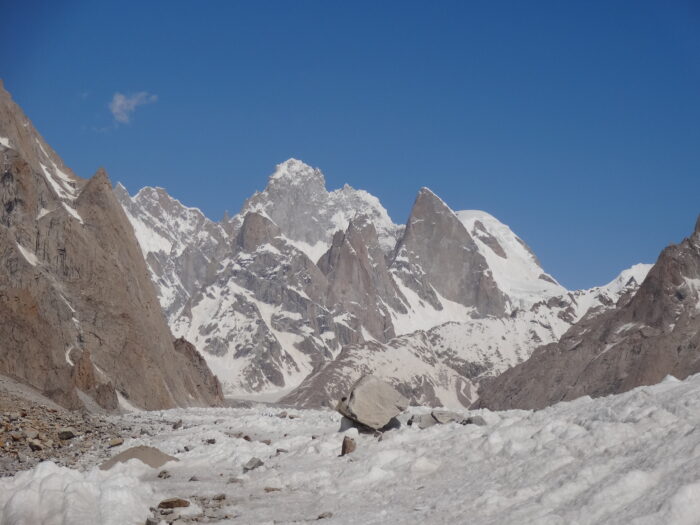
Favorite playground
For Thomas Huber of Germany, the Karakoram's Choktoi Glacier and the ragged spires surrounding it are special. Here, he has achieved some of his most spectacular ascents: Latok IV (6,459m) with his brother Alex in 1999, and Latok II (7,108m) in 1997 with Conrad Anker and Toni Gutsch. Huber also climbed the neighboring Ogre and Ogre III in 2001.
Choktoi is also home to a major unfinished project: linking the north face and north ridge to the summit of Latok I, a line that has never been completely climbed. Huber has attempted it several times, including last year with McCrea and Griffin.
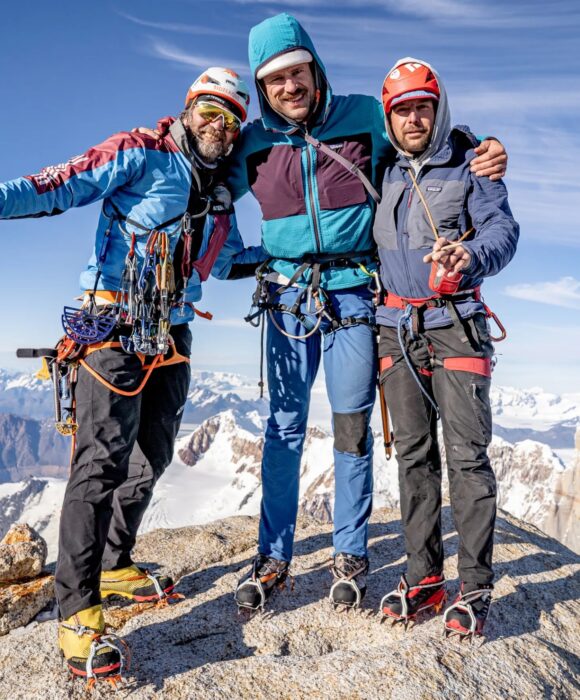
This time, Huber is back with the same partners, but a different goal: the unsummitted southeast pillar of Latok III (6,949m).
The team was awarded a cutting-edge grant to attempt the climb.
The forecast promises better weather, but climbers cannot afford to fully trust predictions that have failed often over the last two weeks. Despite this, climbers are cautiously ascending with summit hopes on Gasherbrum I and Broad Peak.
Fortunately, the skies have cleared enough for rescue services to airlift Waldemar Kowalewski to the hospital after a few agonizing days waiting in Base Camp with a broken leg.
Gasherbrum I
"The Gasherbrum I team climbed to Camp 2 today, planning to go further up and hoping for a summit chance," Sakhawat Hussain of Summit Karakoram said. "The weather seems to be OK between July 19 and July 22, but conditions are proving unpredictable. We can only hope for the best."

Broad Peak
On Broad Peak, everyone is still in Base Camp, but a significant number of climbers will move up tomorrow, toward Camp 2. The plan is to go to Camp 3 if the avalanche risk is acceptable, and then wait there until the weather allows a summit push. As mentioned in previous updates, there are no ropes from Camp 3, so the guides will have to fix the route as they move along the long summit ridge.
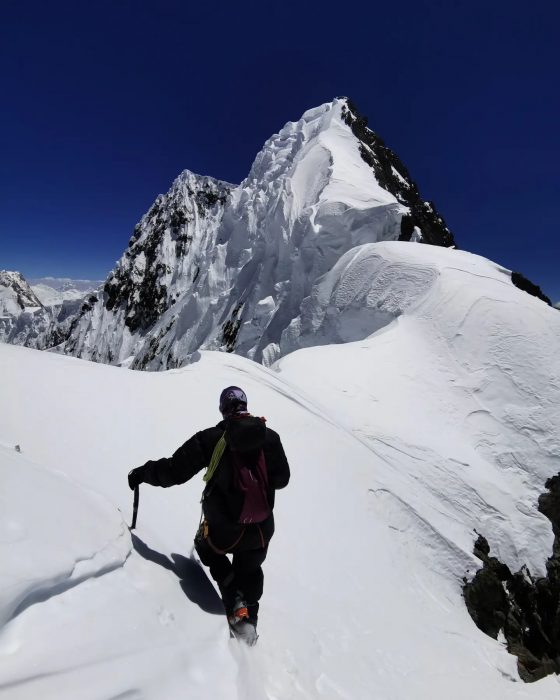
Kowalewski Airlifted
A helicopter has finally airlifted Waldemar Kowalewski to a hospital, one week after he broke his leg in an avalanche. Bad weather kept helicopters grounded until today. Rescue services admitted Kowalewski to the Kuwait Medical Complex (KMC) in Skardu.
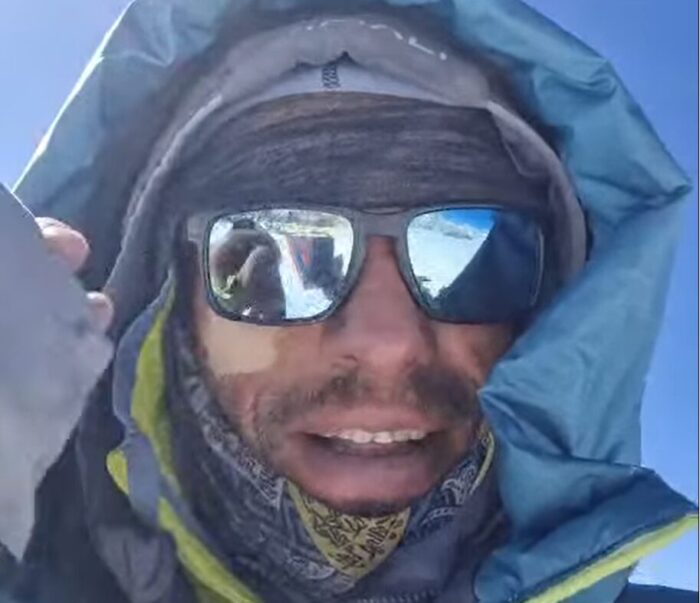
K2
On K2, there is no news of any progress beyond Camp 2. However, Mingma G of Imagine Nepal mentioned his team would try to open the way to Camp 3 this weekend.
Yakshin Gardan Sar
The Italian Alpine Club has published Stefano Ragazzo's expedition report on their Facebook page, where they provide further information about Chris Wright's accident, which put an end to the team's expedition. According to the report, Wright had a foot injury:
During an acclimatization climb at approximately 6,100m, Wright suffered a foot injury that prevented him from continuing. His climbing partners immediately took action to rescue him, rigging approximately 500m of abseils on abalakov ropes to lower him to Camp 1 at 5,500m. There, after approximately 24 hours, a Pakistani Army helicopter was able to evacuate Wright and transport him to Skardu Hospital, where he is currently in a stable condition.
You can read the report in Italian here.
With the rope-fixing work stalled on K2 and Broad Peak, the next summit news might come from the Gasherbrums. Climbers have been in Camp 1, ready to go, all week. Finally, they have a summit plan.
Gasherbrum I weekend summits?
"Forecasts are not optimistic until at least July 19, but the wind is expected to drop to 20-25kmph (which is okay for a summit push) on July 18-19," Sakhawat Hussain, Managing Director of Summit Karakoram, told ExplorersWeb. "Therefore, we have scheduled the summit push on Gasherbrum I for between July 19 and July 20, if everything goes well. Then we will go for Gasherbrum II."
Hussain described weather conditions today as "manageable, but they might change at any moment."
At the beginning of this week, the expedition leaders hoped to attempt one of the Gasherbrums on July 17-18, but the weather halted that plan.
Summit Karakoram, a Pakistani agency, is outfitting a team from Nepal-based company 8K Expeditions, led by Saila Sherpa. However, apparently, all the commercial teams are moving at the same pace. Nirmal Purja is there, aiming to bag his 51st and 52nd 8,000'er summits.
Specific tactics
Both Gasherbrum I and II provide a slightly shorter climb than other 8,000'ers in Pakistan. The key is to take positions on the top of the tricky Gasherbrum glacier, which has become the most exposed section of the climb to both peaks. Warm conditions cause slushy snow with hard ice underneath and many open crevasses. This is why teams leave Base Camp and settle at Camp 1 to wait for the right time to launch summit pushes.
A lack of ropes on the upper sections can be solved with the same tactic used on Nanga Parbat some weeks ago: Sherpa guides will lay ropes as they go, with the commercial climbers following.
French and Italians
There are also some small groups aiming for the summit without Sherpa support. Among them are French climbers Charles Dubouloz and Symon Welfringer, who abandoned their plans to climb the highly difficult West Face of Gasherbrum IV because of a lack of ice on the wall. Mathieu Ruffray has also joined the team as a filmmaker.
"The dryness of these immense fortresses caught us off guard and pushed us to reconsider the location of our base camp for the coming month," Dubouloz reported yesterday.
The team headed for the common Base Camp for Gasherbrum I and Gasherbrum II, but has not made their next goal clear. They have, however, been able to acclimatize by climbing up to 6,414m and spending two nights at 5,700m and then 6,000m. They still need a second rotation before heading for a summit.
There is at least one other French team eyeing an alpine-style ascent, and an Italian expedition whose original goal was also Gasherbrum IV, which they hoped to climb from its north side.
Broad Peak
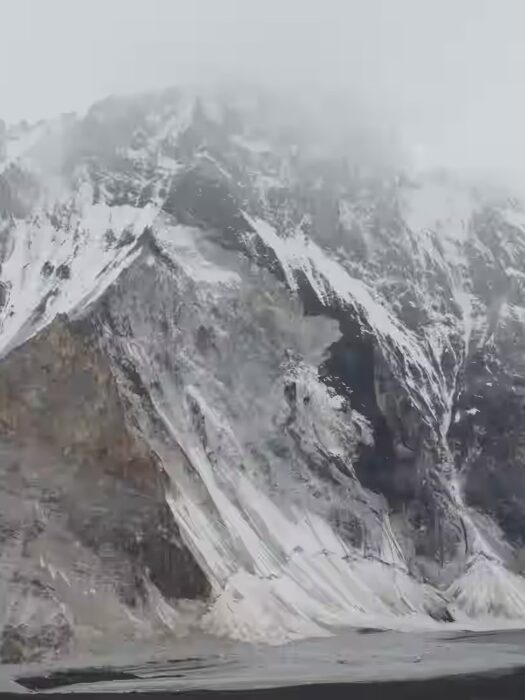
The situation is similar on Broad Peak. An optimistic forecast motivated some climbers to go up at the beginning of this week, but the prediction proved wrong. The weather is still bad, with snowfall on the upper part of the mountain and -- even worse -- rain in Base Camp and on the lower sections.
"Our mountain is melting before our eyes," Lukasz Supergan of Poland wrote.
American-British climber Chris Wright was injured in an accident on Yukshin Gardan Sar (7,530m) after an epic descent. He has been airlifted to a hospital in Skardu, where he is stable and recovering. His climbing partners, Michael Hutchins and Stefano Ragazzo, have called their expedition off.
According to Ragazzo, Wright had an accident at approximately 6,100m, though he has not confirmed the circumstances. Hutchins and Ragazoo were able to lower Wright to Camp 1, where he remained for 24 hours until a Pakistani Army helicopter evacuated him.
Attempt over
From Camp 1, Ragazzo and Hutchins continued down to Base Camp in very difficult conditions because of bad weather and snowfall. Once there, they called off their expedition.
"We're fine, but it was really challenging," Ragazzo said. "The conditions were no longer there to continue."
Bad weather has hampered other aerial evacuations in Pakistan, including the retrieval of Waldemar Kowalewski, injured on Broad Peak last Friday. Conditions in the Shimshal valley, where Yukshin Gardan Sar is located, were perhaps better than at Broad Peak's Base Camp at the head of the Baltoro valley.
We await further updates about the accident and Wright's state.
High difficulty
Awarded a Cutting-Edge Grant by the American Alpine Club, and supported by the Italian Alpine Club and UK Mount Everest Foundation, this was one of the most interesting expeditions this year.
The team had originally planned to climb Rimo III on the Indian side of the Karakoram, but did not receive a climbing permit. They changed goals at the last minute and instead went for an even harder goal: a new route on the previously unclimbed north face of Yukshin Gardan Sar, a monster 3,000m wall.
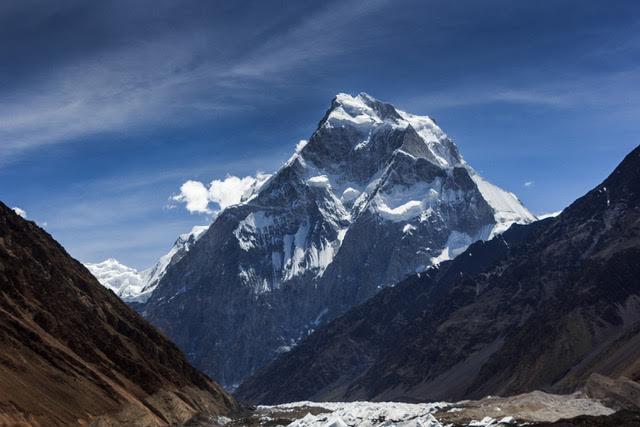
Fixing ropes on K2 is a joint effort by all the teams on the mountain. It is also a fight against the elements; the weather has moved from too hot and dry to too wet and windy.
Migma David Sherpa, 36, hoping to summit K2 for the seventh time, described the situation for ExplorersWeb. The Nepalese climber is back at Base Camp after a trip to Camp 1 leading an Elite Exped team.
"Due to unfavorable weather conditions and continuous rockfall, the rope could not be fixed above Camp 2," he said. "Although the fixing team from Garrett Madison and other teams attempted to reach Camp 3, they were unable to open the route beyond Camp 2."
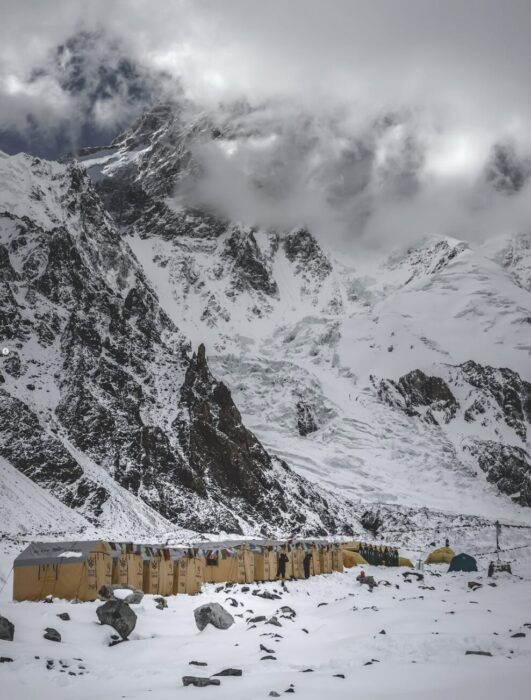
Nuptse expert Dawa Tenji Sherpa, working with Madison Mountaineering, was among those in Camp 2 last Monday. He confirmed that the wind was very strong and forced his team to retreat (as relayed by Jay Whiting, Tenji's partner on Nuptse this past Spring).
High winds in Camp 2
Before the weather worsened, Mingma David's team had made good progress on the rope-fixing work.
"Vinayak Malla, Nima Sherpa, and Phuri Kitar had fixed the route up to Camp 1," Mingma David said. "Above Camp 1, another team from Seven Summit Treks fixed one anchor just below Camp 2. Later, Nima and Phuri Kitar continued and fixed the route to Camp 2."
Unfortunately, progress is now stalled until the weather improves.
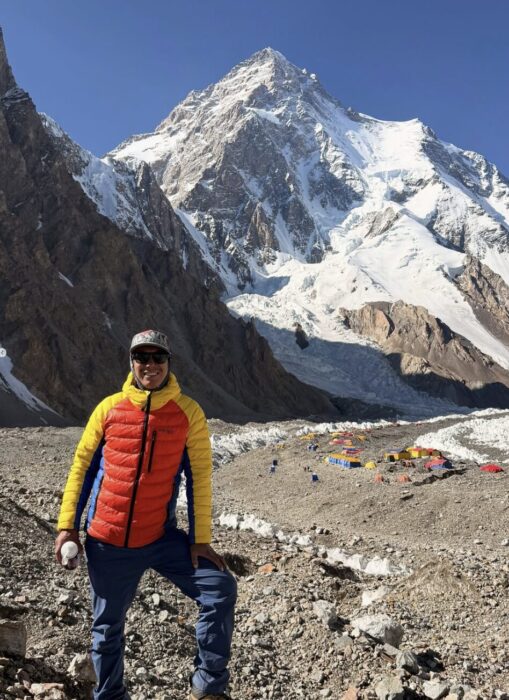
Waiting for the sun
"The weather is forecast to improve from July 18, and with a collaborative effort from all teams, we will progress fast," Mingma David said.
The situation is not yet a problem for the great majority of climbers in Base Camp, who use supplemental oxygen and personal guides. In the last two years, K2 summits occurred during a single weather window at the end of July, and summit rates were still very high.
The downside of having a single, massive push on K2 is the impossibility of avoiding traffic jams on the higher sections, especially during the dangerous traverse under the Big Serac and the Bottleneck at around 8,400m. When the time comes, expedition leaders need to be extremely cautious with conditions on that section.
Harder for no-O2 climbers
For climbers going with supplemental oxygen, it is another story. "The lack of ropes above Camp 2 may pose a challenge for climbers attempting to summit without supplemental oxygen, given the limited time remaining," Mingma David said.
Indeed, climbers without oxygen need to do more rotations and reach well above 7,000m before launching a final summit push. It all depends on conditions on the mountain after the first summit wave. In 2024, the weather remained good for long enough to permit several no-O2 climbers to top out in the three days after the first summit wave.
Some of them, such as Liv Sansoz and Seb Roche of France (who also performed a tandem paragliding flight from the summit), used a smart strategy; they acclimatized, not on K2, but on the more straightforward Broad Peak.
Ropes on Broad Peak
On Broad Peak, the ropes are ready up to Camp 3. Some climbers attempted to go up earlier this week but were pushed back by a blizzard. Like everyone else in Base Camp, they are getting ready to go up again as soon as the weather improves.
Those on oxygen could attempt the summit directly from Camp 3, but they need a team to fix the ropes. Sakhawat Hussain, Managing Director of Summit Karakoram, told ExplorersWeb that his team counts on experienced Pakistani and Nepalese climbers willing to fix the ropes are they go. He also expects strong climbers in other teams to collaborate with the efforts.
Climbers without oxygen may use the next rotation to complete their acclimatization, and then decide if they will go again to the summit of Broad Peak or move on to K2.
The current spell of bad weather is halting everyone on the Karakorum 8,000'ers. The helicopter meant to airlift Polish climber Waldemar Kowalewski, injured in an avalanche last Friday, remains grounded.
"The weather forecast is not clear for the next two to three days," charter airline company Askari Aviation told Kowalewski's outfitter, Lela Peak Expedition. "The injured climber should start going down from Base Camp on a horse or mule."
A tough decision
Kowalewski has a broken leg, which requires urgent treatment. Waiting for an airlift is bad, but a trip on the back of a mule down the very rough Baltoro, over glacial and rocky terrain, could be even worse.
A regular on 8,000'ers, Kowalewski was injured when he broke a slab of unstable snow as he descended to Base Camp after enduring two days in a snowstorm at Camp 3. Climbing partner Jarek Lukaszewski and Pakistani climber Hassan helped him to a tent at 6,500m.
An aerial pick-up was never an option, so outfitter Lela Peak Expedition hired a Sherpa team for a ground rescue mission. They climbed to the injured climber on Sunday and brought him down to Base Camp on a stretcher. Since then, he has waited for aerial evacuation, but bad weather has grounded the helicopters.
German climber David Goettler had unfinished business with the Rupal side of Nanga Parbat: "I needed to prove I'm able to claim an 8,000’er in the style I like and off the normal route."
Back in Europe after climbing the Schell route and paragliding from the summit, Goettler is over the moon. He's not only ecstatic about the achievement, but also because he finally succeeded on a personal bet that has molded his high-altitude climbing career.
"After all these attempts and years I put into this project, it paid off and I am very happy," Goettler said. "I have fulfilled this dream, and flying down, it's kind of the cherry on the top, even if it was not right from the summit."
Prize for persistence
In some cases, when a climber achieves a project attempted and planned for years, they feel a kind of emptiness. Goettler, on the contrary, has found that it has motivated him for future climbs.
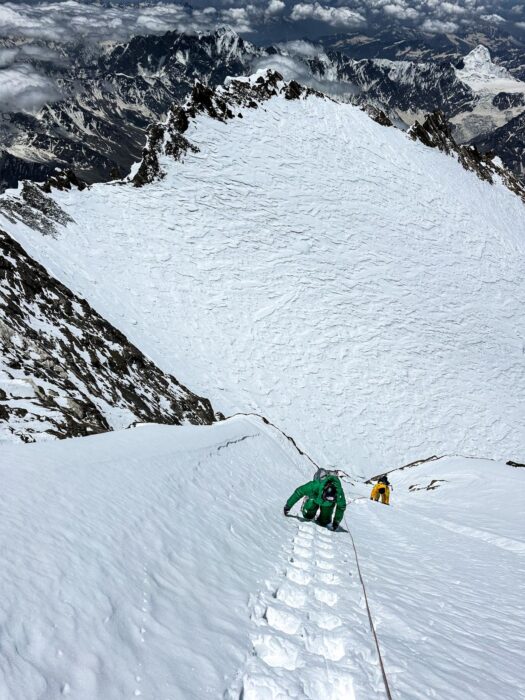
"The recent success has increased my motivation to chase similar projects because I have climbed Nanga Parbat in exactly the style I wanted. I have learned that it sometimes takes a lot of attempts, but in the end, with persistence and patience, it pays off."
This is an important issue for Goettler, who follows strict safety standards on his climbs. His goal is to complete a climb and descend safely, without "having to get epic," as he terms it.
"Through the years and the attempts, I turned around so many times because some small things didn't fit right or it was not perfect. Of course, I questioned myself. Perhaps I was not pushing hard enough? But in the end, I have proven that I can achieve my goals in what I consider the right way," Goettler explained.
Safe, not boring
Goettler concedes that his focus on safety "might look boring for audiences and the media, because I avoid drama. I am aware others push these limits far beyond [what I choose to do] and play with fire. But each climber has to decide this for themselves."
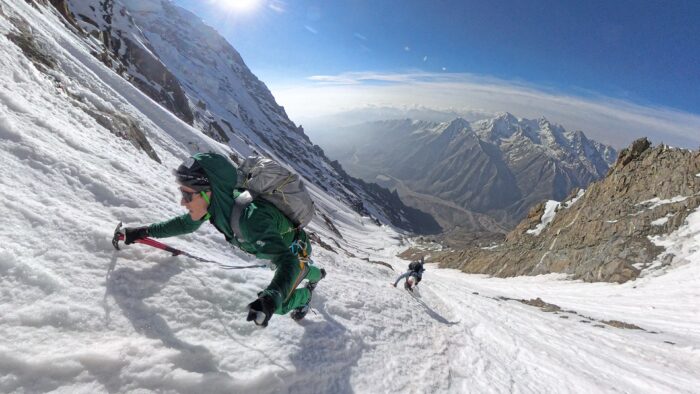
"Of course, bad luck is always possible, and you can always end up in a difficult situation without forcing it. However, if you push the limits again and again and again, you may need to start questioning your approach to mountaineering," Goettler told us.
On every attempt, Goetller studied his mistakes and tried to fix them for the next round. So, what changed on this attempt? What was the final finetuning that led to success instead of retreat? Was it just luck?
More than luck
"I believe it's not only luck, although we were indeed lucky with the weather window and with the conditions. The mountain was very dry this year, which made the going up to 6,000m quite complex, especially for Boris and Tiphaine [climbing partners Boris Langenstein and Tiphaine Duperier of France] who wanted to ski down from the top," Goettler said. "However, from 6,000m up, conditions were way better."
Goettler explained that, although the climbers had to break trail all the time, the snow was not as deep as in wetter years. As seen in videos from the mountain, the climbers wore small snowshoes, which made progress easier on the snowy patches.
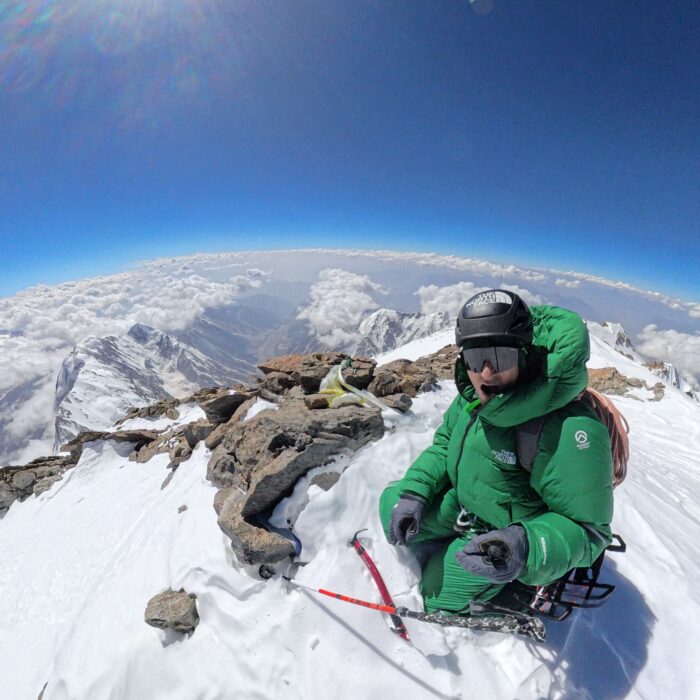
The team enjoyed an extraordinary weather window. "For three days we had little wind and no precipitation," Goettler recalls. "However, from my experience climbing in Pakistan since 2004, I had learned that temperatures are rising in recent years, so we knew we would need to make the attempt early in the season. We still almost got there too late!"
Fine-tuned tactics
Reflecting on the increasing temperatures, Goettler believes expeditions in the Karakoram may consider an earlier start, even if that means overlapping with the Spring season in Nepal.
Goettler also made a key tactical adjustment for this final attempt.
"The summit day from the last bivy at 7,400m is extremely long, and the last time I underestimated it. On the maps, the terrain looks so vertical that you think it cannot be too long, but it is! It’s a long way to the top, especially because of the traverse of the Diamir side," Goettler said.
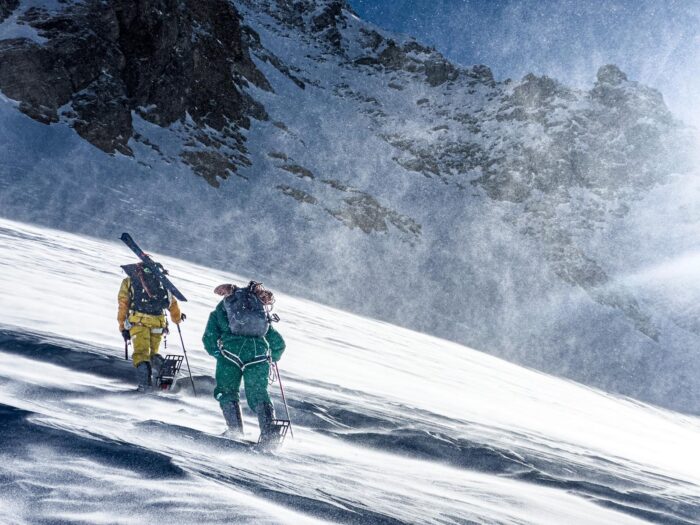
"Therefore, this time we took a tent, a stove, and a sleeping pad with us for the summit day. That way, we could always stop, pitch the tent, get shelter from the wind, and have a rest, no matter the altitude. Either on descent or during the ascent, if the weather turned for the worse, the safety items gave us confidence to tackle a longer summit day."
They reached the summit shortly after 3 pm local time, which is late on an 8,000'er. But they had perfect weather, so an evening descent was not concerning.
"However, it was just a little bit too much wind to feel comfortable taking off and paragliding directly from the summit," Goettler noted.
The descent
With too much wind to take off from the summit, Goettler started down with Langenstein and Duperier. The two French climbers put on their skis at the top and started down the summit ridge to the south summit of Nanga Parbat; Goettler followed on foot. The skiing was slow at that altitude, so he didn’t get left behind.
"At around 6:30 pm, we reached 7,700m. Here, the ridge opens up and the terrain falls away in a huge, steep snow field," Goettler said. "It was still a bit gusty, but I felt confident to take off."
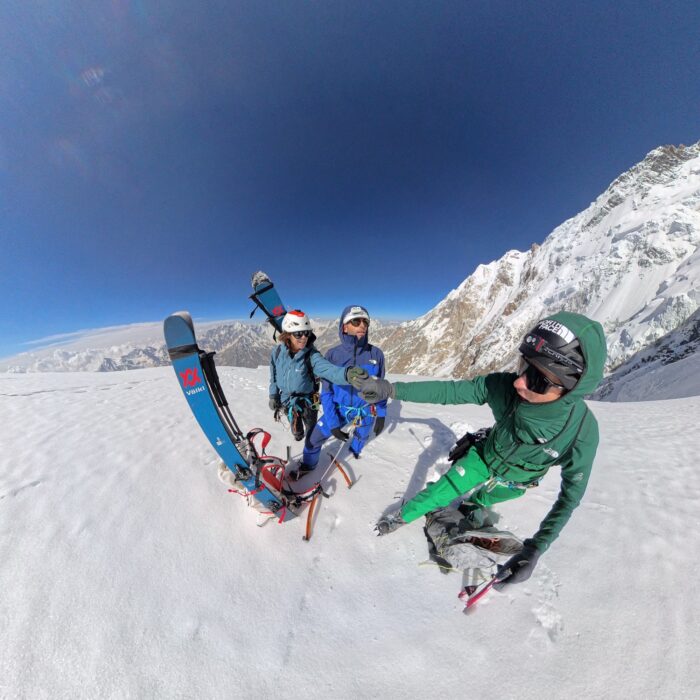
The following 30 minutes will always remain in Goettler’s memory as one of the most amazing, surreal moments of his life.
"I took off, first flying toward the flank of the mountain, along the traverse of the Diamir side and right over the Mazeno Col back to the Rupal face, where I dropped down and landed right beside our Base Camp. It was one of my best and craziest moments in the mountains so far."
Thirty minutes vs. three days
Goettler's arrival shocked the Base Camp cook, who didn’t expect anyone for dinner so soon after hearing the summit news. He ran out of the tent when he heard Goettler calling.
Going down took much longer for Langenstein and Duperier. "The traverse is no more than 50 vertical meters, but it’s all ups and downs, which can take an extremely long time when you’re on skis," Goettler said. "They used the tent, improvising a bivy for the night. The following day, they continued to the place of our last proper camp, at 7,400m, right at the access point to the Rupal side, and they spent another night there."
The descent down the Rupal Face was so rough that the French climbers still needed another stop. They halted on the ridge at 6,000m because the lower part of the mountain was so prone to rockfall that it could only be downclimbed when frozen, between midnight and 6 am.
Their long descent provided Goetller with a new experience: waiting in base camp for partners on the mountain. "It was quite intense," he said. "We could only communicate over the radio when they were on the Rupal Face. While they were on the other side, only SMS over InReach worked, and there was so little we could say. It was unnerving not knowing where they were and how they felt."
The art of flying
Indeed, flying down proved an amazing way to descend from a high-altitude summit. It is safer, faster, and spectacular. Benjamin Vedrines and other French climbers experienced it on K2 last year, where it also worked wonderfully.
"I'm sure we will see it more and more, but it will not become the norm," Goettler said. “Most days, flying from a summit or a high point is not possible. Even with modern, more accurate forecasts, you need to be really lucky with conditions, and then high-altitude paragliding requires extra skills. Often, I carry my wing up and I can't fly."
Goettler recalls that he took his wing to Nanga Parbat last year when he attempted the climb with Vedrines, but he was unable to fly from any higher than 5,500m because of high winds. Equally, he brought the wing up Baruntse in spring, but he had to return on foot in foggy weather.
"Gliding makes life so easy when it works. You fly with zero worries about rockfall, avalanches, exhaustion, or anything. In 30 minutes, you're back down to safety."
Team workflow
Goettler has attempted Nanga Parbat on five occasions with different climbing partners. He has climbed with Herve Barmasse, Mike Arnold, and Benjamin Vedrines. Last year, he met Langenstein and Duperier on Nanga Parbat. They shared the same goal, so they quickly made plans to join forces in 2025.
"It was one of the best teams I have ever been on, even though our characters are rather different. I worked really well, it's so good to have a group where you spend no energy managing the team dynamics," Goettler said.
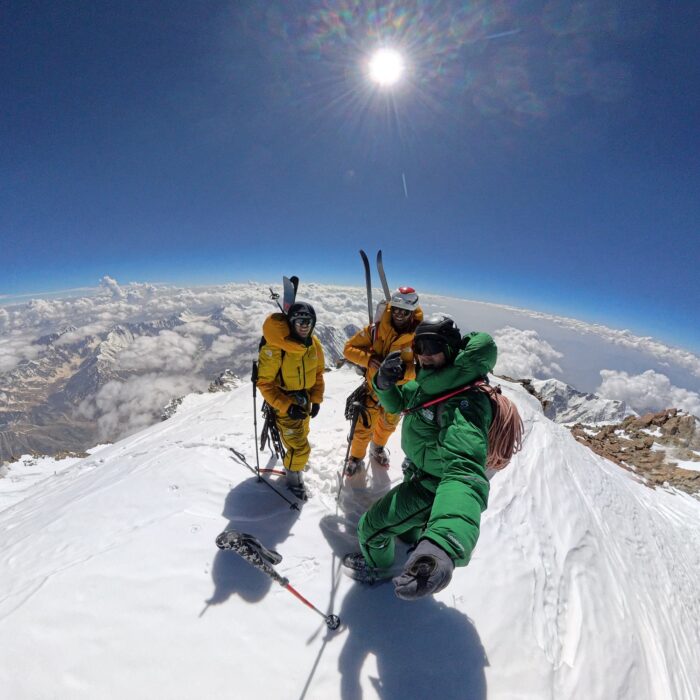
The climb
The climb was described by Goettler in a series of clips that he posted on social media. Here's a summary and the footage:
Day 1: Latabo Base Camp to Camp 1 (6,000m)
Goettler notes that the team had made a previous climb to this point to check conditions. They left a small gear deposit.
"For the ultra purists, our ascent wouldn't be 'alpine style,' but I’m still happy to call our climb alpine style because there wasn’t a single meter of fixed rope, no set camps, and no external help."
The team climbed with a 50m rope, some pitons and cams, one tent, and food and gas for five days.
Day 2: The ridge section and snow fields between 6,000m and 6,800m
"The route goes along a sharp ridge, then you have to cross big, wide open snowfields," Goettler described.
This is the section where the climbers enjoyed better conditions than the previous year, with not so much snow. Still, they used small snowshoes for some parts.
Day 3: To the third bivouac at 7,400m
For Goettler, this section is key to predicting whether the climb will be successful. Luckily, the forecasts were accurate, and the winds dropped.
Day 4, part 1: The traverse, 7,400m to 7,800m
Goettler turned around on this section on two previous occasions. They made much faster progress this time.
"The conditions on the summit ridge were exceptional, as was the weather, but the traverse itself has endless ups and downs, which makes for an exhausting return," he noted. "We swapped leads whenever someone needed a break, and with this teamwork, we maintained a slow but consistent pace to the Merkel Notch, just below the final unknown section of the route."
Day 4, part 2: From 7,800m to the summit
Once in unknown terrain, after the Merkel notch (a small col), they climbed a technical rocky section and crossed a snow field that took them to the south summit and then the main summit of Nanga Parbat.
"[The rock section] wasn’t super hard, but difficult enough to get the 50m rope and camalots out, which, at close to 8,000m, is spicy enough," Goettler recalled. "When we finally stood on the summit of Nanga Parbat, 14 hours after leaving our last camp, each of us knew that without the others we wouldn’t have made it. A feeling and a moment so powerful I won’t ever forget."
Earlier this season, Zdenek Hak and Radoslav Groh made the first ascent of the southeast face of 6,300m Hunza Peak in the Karakoram. The Czechs' new route rises 2,300m from base to summit and reaches 90º of steepness. They proposed a grade of 5+UIAA, M6+, WI5 for their new line, which they called Eid al Adha.
The climbers posted some photos and a couple of sentences right after the expedition, but here is a complete report of how the pair reached what they called one of the most beautiful summits they’ve ever stepped on.
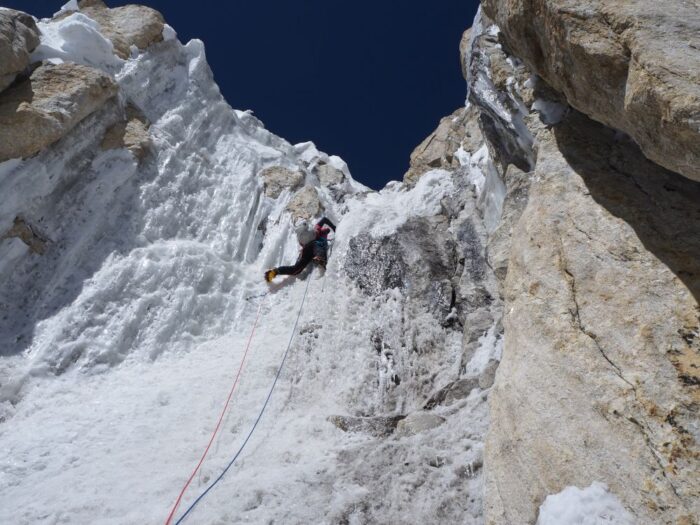
Promoted to main goal
This is not Hak and Groh's first rodeo; the pair are regulars on our best expeditions of the year list. They had first set their sights on Hunza Peak in 2024 as acclimatization for an even more ambitious project -- the first ascent of 7,453m Muchu Chhish, then the highest unclimbed peak in Pakistan. Their successful climb was ExplorersWeb's top expedition of 2024.
"Unfortunately, we had to cancel the attempt [on Hunza Peak] due to my illness and focus solely on the main target of that season, Muchu Chhish," Hak told us. "Nevertheless, we left at the bottom of the southeast face of Hunza Peak not only our equipment but also our dreams, desires, and commitment."
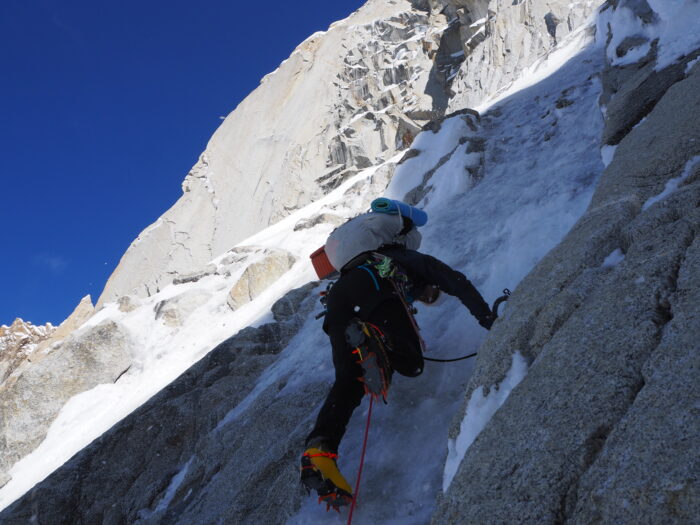
When Jaroslav Bansky, the third man on the Muchu Chhish team, dropped out of projects for 2025, "Radoslav Groh and I agreed not to attempt any extremely high mountain and to return to Hunza Peak instead," said Hak.
The duo arrived in Pakistan on May 20. They knew they wanted to try the unclimbed south face and had also seen a possible route to the summit.
"The only goal this time was to acclimatize well and wait for favorable conditions and weather," the climbers said.
The right conditions
The right conditions came on June 6. Hak and Groh set off toward the face, with 3,000 vertical meters ahead of them to the summit. Of this, 2,300m required technical climbing.
However, even the approaches to the climbing sections were not easy. Nearly one meter of fresh snow had recently fallen.
"It was quite tough to fight our way through," they admitted. "Also, in between the gullies, there were also rock sections of 5+."

The climbers pitched their tent for the first night on the glacier at 4,500m.
"The next day, we just managed another 600 vertical meters. Already at 10 am, avalanches were falling all around us," they explained. "It was so dangerous we had to set a second bivouac right then."
The third day, Hak and Groh climbed 800 vertical meters of steep snowy or mixed terrain to 5,900m.
"We worked hard to dig a small platform for our tent," they said.
On the following morning, they launched their summit push:
The summit day

On June 9, we left the tent and all the equipment at our last bivouac so we could go light. The first M6 pitch warmed us up, and we continued through a firn couloir with 20m of perpendicular ice. Once we got over it, we climbed tediously up to the top serac...There was no way further, so we rappeled leftward into the central couloir and then we climbed back up, until a shoulder right below the summit.
From there, we just had to overcome a 50m high ice/snow tower with a ‘mushroom’ on top just like a summit in Patagonia. It was beautiful and spectacular climbing with a lot of exposure! One of the most beautiful I have ever experienced. There was not enough place for both of us on the summit ridge so we had to take turns. We even dug a hole in the snow and looked through to the other side. Amazing experience! I have not been on such an extraordinary summit before.

They descended by rappelling down the same route they had climbed, resting for the night in Camp 3. They made it back to Base Camp on June 10.
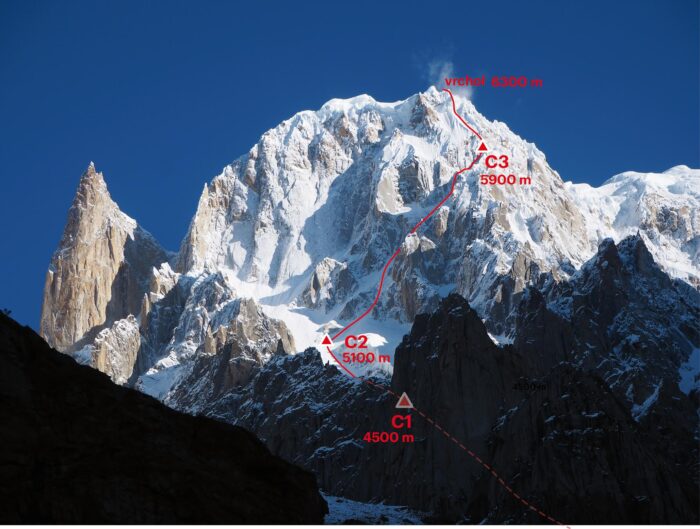
Hunza Peak lies at the head of the Hunza Valley, in the Batura Muztagh range. Several alpine-style teams visited the area earlier this season, with some success. The American expedition on neighboring Ultar Sar, for example, bagged the first ascent of the southeast pillar.
Pecking order
In several of the pictures shared by the team, Groh's helmet is seen severely damaged.
"Nothing serious," Hak explained. Apparently, it was not from a falling rock or a chunk of ice. For some reason, the local birds enjoyed pecking at the helmet when they found it in a gear cache.

Waldemar Kowalewski's ordeal on Broad Peak is almost but not quite over. The Polish climber, who broke his leg in an avalanche on Friday, was supposed to fly by helicopter to a hospital in Skardu today. But bad weather has grounded the flight until tomorrow.
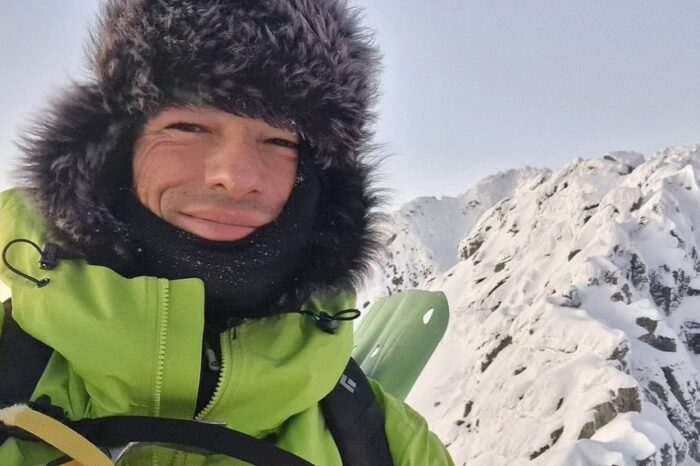
An avalanche hit Kowalewski, 45, as he was descending from Camp 3 in risky conditions. His partners helped him down to a tent at 6,500m, from which a Sherpa rescue team brought him down to Advanced Base Camp. Local climbers then helped him the rest of the way down.
Sherpa rescuers
The Sherpa rescuers were Dawa Sangay Sherpa, Pasang Tenje Sherpa, and Mingtemba Sherpa. All three work for Seven Summit Treks, assisting climbers and fixing ropes on K2. However, bad conditions on the mountain during the second half of last week forced the teams to halt the rope fixing. Everybody was waiting in Base Camp, and so were available. Israfil Ashurli of Azerbaijan coordinated the rescue.

The three set off from Broad Peak's Base Camp on Saturday night and reached Kowalewski Sunday morning. By evening, they had passed Camp 1 and continued down until they met a second local team dispatched from Base Camp to relieve them. Kowalewski arrived back in Base Camp that night, weak but conscious.
Rescuers have brought Waldemar Kowalewski back to Broad Peak's Base Camp two days after the Polish climber broke his leg in an avalanche at 6,500m. The strong Sherpa team climbed from Base Camp to the stranded climber and back to Advanced Base Camp in less than 24 hours.
A second team of Pakistani climbers left Base Camp in the afternoon to take over from the exhausted Nepalese on the last leg, according to Anwar Syed of Lela Peak Expedition, the company managing the rescue.
Kowalewski is conscious but extremely tired and weak, the outfitter told ExplorersWeb.
From Base Camp, Kowalewski will be airlifted to a hospital in Skardu tomorrow, said a spokesperson for Askari Aviation.
Hopefully, tomorrow we will have more details about Kowalewski's condition and the names of the rescuers.

A team of three Sherpas has reached Waldemar Kowalewski of Poland, stranded at 6,500m with a broken leg.
The Nepalese rescue team hopes to reach Camp 1 later today and Base Camp tomorrow, Anwar Syed from outfitter Lela Peak Expedition told ExplorersWeb. However, rescuers will have to deal with difficult conditions during their descent, including crossing avalanche-prone areas.
Kowalewski has waited in a tent -- supported by his climbing partner Jarek (Jaroslaw) Lukaszewski -- since an avalanche hit him on Thursday. Kowalewski had ascended to Camp 3 with at least two other climbers on an acclimatization round despite forecasts warning of incoming bad weather.
Polish climber Lukasz Supergan, reporting from Base Camp, says that the group spent three nights in Camp 3 in stormy conditions before finally starting to descend on Thursday. It was during this descent, as they entered a section of fresh, unstable snow, that the climbers broke a snow slab and triggered the avalanche.

The Nepalese climbers, whose names have not been shared, were previously working on neighboring K2. They had remained in Base Camp because of the bad weather hitting the Karakoram. Kowalewski's outfitter, Lela Peak Expedition, hired the Nepalese climbers after failing to find anyone in Broad Peak's Base Camp willing to perform a rescue on foot in the risky conditions.
Evacuation, insurance, and liability
The Pakistani Army told outfitter Lela Peak Expedition that an aerial pick-up via a long-line operation was not an option. The military pilots will evacuate Kowalewski, but only from Base Camp.
Kowalewski has an insurance policy with Global Rescue that will cover the helicopter costs, but not the ground rescue team. That means that the Polish climber and his home team will have to foot the bill for the Nepalese rescuers.
Outfitter Lela Peak has hired three Nepalese Sherpas to rescue Waldemar Kowalewski. The Polish climber is still stranded in a tent at 6,500m on Broad Peak after breaking his leg in an avalanche. The Sherpas left at around 11 pm Pakistan time.
Kowalewski's accident occurred when he and two other climbers tried to descend to Base Camp after a snow storm trapped them in Camp 3 for two days. They released a snow slab; the other two escaped but Kowalewski was injured.
The two climbers, identified only as Jarek and Hassan, helped him a little way down and pitched a tent for him at 6,500m. Jarek -- apparently a Polish friend of Kowalewski's -- is looking after him. They have sleeping bags and fuel for cooking.
For many hours, his situation did not improve. Snow continued to fall today, making the area even more avalanche prone. Lukasz Supergan and other climbers in Base Camp saw several slides today.
Helicopters are grounded due to the bad weather. Even if it improves, they have warned they will not fly any higher than 5,000m, roughly the altitude of Base Camp. Other Pakistani outfitters explained to ExplorersWeb that this is as high as their rescue helicopters typically go.

Took risks
Supergan noted that Kowalewski took significant risks by going up to Camp 3 when forecasts warned of bad weather ahead. Several other climbers on the mountain, Supergan included, did rotations to Camps 1 and 2, but returned to Base Camp earlier this week.
"Kowalewski was descending in terrain highly prone to avalanches, and that was the cause of the accident," he said.
Kowalewski's outfitter, Lela Peak Expeditions, had a hard time finding a local team to go up on foot, but eventually hired three Sherpas. They left Base Camp at night, when the cold makes both the snow and the bare rocky sections less unstable.
Naila Kiani is on her way to becoming the first Pakistani woman to complete the 14x8,000'ers, but her impact goes beyond summits. Kiani is driving change in her country's mountaineering scene, speaking up for those without a voice and making more than a few enemies along the way.
During her 14x8,000m quest, Kiani has been a reliable, outspoken witness in the usually secretive commercial climbing industry. She was the one who denounced how climber Ali Akbar Sakhi of Afghanistan was abandoned close to Camp 3 on K2, and faced threats when she accused Sakhi's outfitter of negligence.
Kiani also reported what happened on Shisha Pangma in 2023, when a race to become the first American woman to finish the 8,000m list ended with both women's deaths, alongside their Sherpas. After porter Ali Muhammad Hassan died at K2's Bottleneck, and a hundred climbers passed him on their way to the summit, Kiani coordinated a team of local climbers to return his body in the highest retrieval operation ever performed on K2. She has also led cleaning campaigns on the mountain.
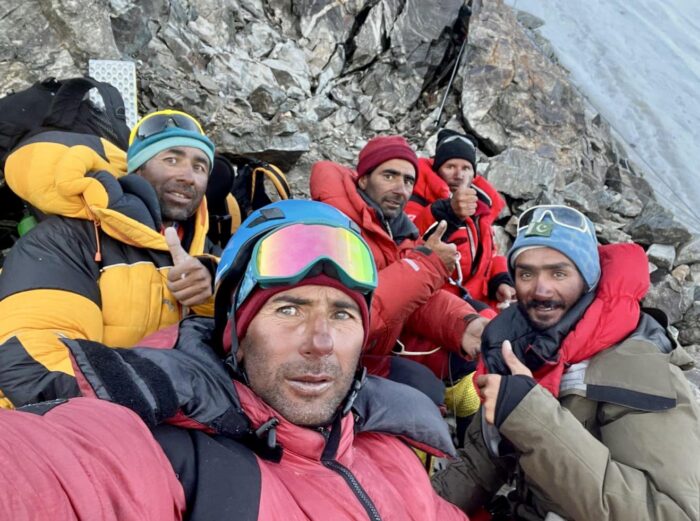
This year, Kiani has spoken out on behalf of a group of local porters whose outfitter had not paid them. She knew the porters were too vulnerable to protest by themselves and that the loss of income might mean misery and hunger for their families.
Changes in aerial rescues
In the last few weeks, Kiani also made two promising announcements: the establishment of a mobile medical dispensary in the Karakoram and a change in helicopter protocols for mountain rescues in Pakistan. Until now, army pilots have managed helicopter rescues, flying in two helicopter patrols that charged $26,000 per flight -- the most expensive fee in the world.
"Last year, I spoke out against the extremely high prices that sick and injured climbers were being charged for helicopter evacuations," Kiani said. "Many told me to stay quiet, and that no one would listen."
Instead, she wrote letters and contacted high-ranking army officials directly. Kiani provided lists of prices comparing aerial rescue services and their costs in several mountain ranges around the world.
"I clearly explained that climbers evacuated in Pakistan were paying way, way too much," Kiani told ExplorersWeb.
To the surprise of the skeptics, the military listened. The new president of the Alpine Club of Pakistan (and Army General), Irfan Arshad, supported Kiani in this quest. The protocols have now changed, and, if applied, the impact will be huge.
Rescues 60% cheaper
Now, the helicopters don't need to fly in pairs.
"Only one helicopter is being sent for rescues, bringing the cost down to under $9,900 on average, nearly one-third of what climbers were paying before," Naila explained.
The change will also double the rescue capacity of the Pakistani air force, as each helicopter may attend to a different rescue at the same time.
Kiani has also insisted on a stricter account of the rescue charges, as the previous cost (calculated per hour of flight time) was sometimes inaccurate.
Finally, Kiani hopes the new protocols will prioritize serious medical cases without insurance companies agreeing to foot the bill first. This would greatly benefit many local porters, who either lack insurance or have limited coverage.
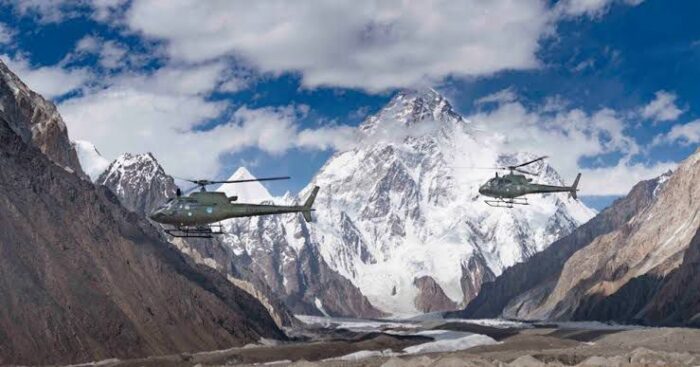
Kiani is hopeful costs will decrease immediately, but she also foresees further improvements. She told Explorersweb that the situation will improve when Pakistan allows private helicopter companies to operate rescues (as they can in Nepal), which Kiani is confident will happen in the future. In her opinion, private companies will lower costs and may be more flexible regarding altitude and weather conditions for rescues.
These improvements may seem logical, but in a country like Pakistan, where the army is incredibly powerful and rarely influenced by external forces, what Kiani has achieved is more extraordinary than any of her climbs.
Dispensaries in the Karakoram
Kiani has also lobbied for (and helped finance) the installation of two paramedical dispensaries along the Baltoro during the summer season. One is already operating at Concordia, one day from K2 Base Camp, and another is ready to start operating in Urdukas, as soon as the assigned nurse gets there.
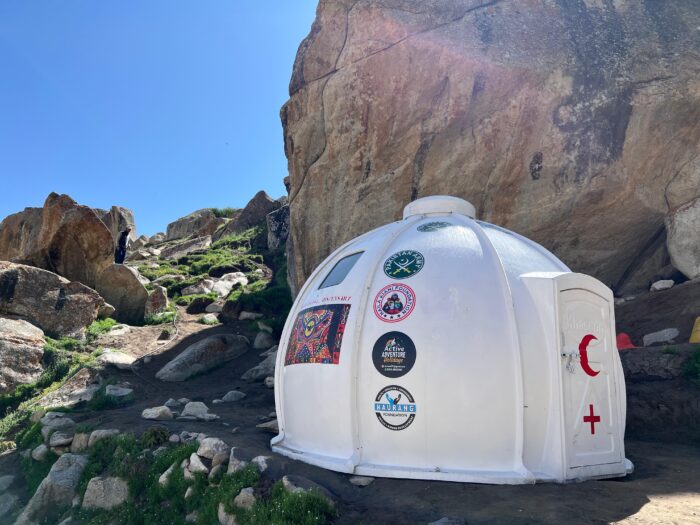
"They will treat everybody for free: trekkers, climbers, and locals working in the area," Kiani said. "Finally, there is a semi-permanent facility to provide sanitary care during the Baltoro trek: igloos prepared to endure harsh weather."
The lack of facilities was a serious problem, particularly for local porters who had nothing to treat their injuries and disinfect wounds. With no help, even small health issues rapidly developed into serious medical conditions.
"We don't have a doctor yet, but the nurse managing each dispensary can treat a wide range of issues," Kiani said.
Kiani will pay the nurse's salary while Pakistan's Alpine Club will cover the rest.
Not just words, actions
These changes come after years of very little progress to improve the welfare of climbers and, most of all, local communities working in the climbing industry.
"I am not the only one who speaks up," Kiani said. "Other climbers also make their voices heard, but it is one thing to speak about something we think is wrong, and another to take action to change it. I strongly believe that if you want things to change, you need to take action."
Kiani's campaign for change has made enemies, but it has also received important support, such as from the Alpine Club of Pakistan and Green Tourism, a private institution that works closely with the country's government. "Without their help, I couldn’t have achieved what I did this year," Kiani explained.
Yet speaking up takes a toll, especially in the close-knit Pakistani climbing community. When Kiani pointed a finger at the negligence of some local operators, she faced harsh criticism and accusations of jealousy or courting controversy.
But Kiani insists that these negative aspects impact the entire Pakistani tourism industry.
"I can't help thinking that Pakistan has such huge potential for mountain tourism, and that mountain tourism can make a life-changing impact on local communities."

In addition to her determination, Kiani has something else in her favor: She is well-educated, with experience making a case, with plenty of proof and documentation, to draw the attention of senior officials. She is a Dubai-based engineer who has worked as a banker, although she quit her full-time job to pursue climbing in 2023.
Breaking social boundaries through climbing
Kiani summited Kangchenjunga, her 12th 8,000'er, last spring. While she has not confirmed her plans for fall, she intends to climb Shisha Pangma and Dhaulagiri to complete the 14x8,000m challenge.
"I get some criticism because I use oxygen and Sherpa support, but climbing has given me a voice and I’m using that voice to try to make a difference," Kiani told ExplorersWeb.
Kiani has become an influential figure for young Pakistani women.
"Gender equality is a real issue. Women here sometimes don’t have confidence and self-belief, so I wanted to inspire Pakistani women," she explained. "If I can do things that are not associated with Pakistani women, and if I can speak up about things that others won’t even dare, then hopefully others can do the same."
Pakistan ranked last (148th out of 148 countries) in the World Economic Forum's Global Gender Gap Index in 2025, with a score of 56.7%. Dawn.com cited data from the Human Rights Commission of Pakistan (HRCP) showing that in 2024, "honor" killings continued to be a serious issue across Pakistan. That year, 346 people (nearly all women) were victims of these so-called honor crimes.
Denis Urubko and Maria Cardell have opened a new route on the Diamir Face of Nanga Parbat. The couple reached the summit yesterday, outfitter Active Adventure Holiday told ExplorersWeb.
Imram Ali Khan of AAH confirmed that Urubko, 52, and his partner Maria Cardell, 50, climbed the new route in alpine style and safely returned to Base Camp. We are waiting for details.
The last person to open a new alpine-style route on an 8,000m peak was Urubko himself. The powerful Russian soloed Gasherbrum II via a new line from Camp 1 in 2019. He called that line Honeymoon as a tribute to Cardell. She had intended to climb the route as well, but a back injury forced her to wait in Base Camp.
Triumphant return
In 2022, Urubko's career suffered a severe blow. While attempting to climb Gasherbrum I in winter via another new route, he fell into a crevasse and was severely frostbitten. It has taken him two years to recover. This summer's expedition to Nanga Parbat marks his triumphant return to high altitude.
The husband-wife team climbed alpine style, acclimatizing on lesser peaks near Skardu. While the summits were all below 6,000m, they managed long day climbs with a significant altitude gain each day, sleeping low after each climb. Then they moved to Nanga Parbat and waited for the right moment.
The climbers started their summit attempt last Saturday and estimated that they would spend five days on the Diamir Face.
Denis Urubko has summited all 8,000m peaks without supplementary oxygen or Sherpa support. He also has two winter first ascents, on Makalu (with Simone Moro) and Gasherbrum II (with Moro and Cory Richards).
Urubko has opened new routes on Manaslu, Broad Peak, Gasherbrum II (solo), and on the highly difficult south side of Cho Oyu. He has also made a name for himself — and friends around the world — for the many rescues he has performed in the Himalaya.
One of them made him an international hero and earned him France’s Legion of Honor. In 2018, he and Adam Bielecki of Poland abandoned their own attempt on Winter K2 and hurried to Nanga Parbat to attempt the incredibly difficult rescue of Tomasz Mackiewicz and Elisabeth Revol. They couldn’t reach Mackiewicz but saved Revol’s life.
After weeks of drought, the first snowfall in the Karakoram has triggered an accident on Broad Peak. Earlier today, a slide hit Waldemar Kowalewski of Poland between Camps 2 and Camp 3, and he is waiting for rescue.
Fellow Pole Lukasz Supergan broke the news this morning from Base Camp. Supergan returned from Camp 2 on Monday, with the mountain in extremely dry conditions. Since then, snow has fallen for two days and covered the upper half of Broad Peak.
"We were sitting outside our tents at Base Camp when we spotted an avalanche descending [from] 6,600-6,800m, between Camp 2 and Camp 3. At first, we dismissed it as a curiosity until we saw the silhouette of a person in the avalanche," Supergan reported.
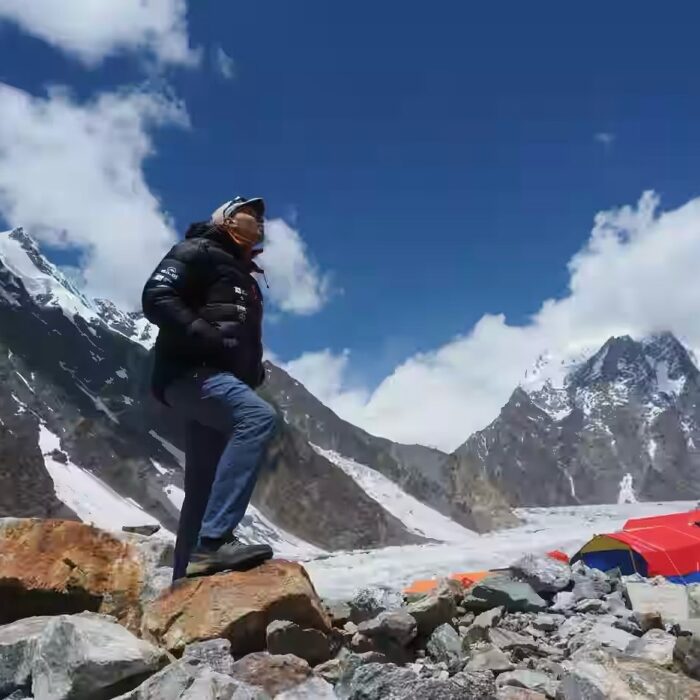
From Base Camp, climbers saw three people in the slide path, but two of them quickly moved away while the other one remained in the same place. Shortly afterward, they received word that Waldemar Kowalewski had a broken leg above Camp 2.
According to Supergan, the liaison officer in Base Camp has contacted the rescue services of the Pakistani army. However, it is unclear if the helicopters will be able to fly, since a storm front is approaching.
Climber safe for now
In a later update, Supergan wrote that Kowaleski has been helped down to a tent at 6,500m, about 330m above Camp 2.
"Two friends, Jarek and Hassan [surnames unknown], are with him," he wrote. "Jarek is looking after Kowalewski, while Hassan has descended to Camp 2 to get some gas."
A team of several people, including a doctor, is leaving Base Camp tonight. As Supergan explained, the lower slopes of Broad Peak are still dry and prone to rockfall, so rescuers will have to wait for the cooler night to go up.
Supergan also showed concern about avalanche risk for the rescuers above Camp 2. "The line where the snow slab broke can be clearly seen from Base Camp," Supergan wrote.
Apparently, the accident took place when the climbers were coming down from Camp 3, which is usually pitched at around 7,000m. The three climbers had spent three nights at that altitude. The avalanche triggered as soon as they entered a snowfield slightly below.
Waldemar Kowalewski is a regular on the 8,000m scene. Last winter, he summited Ama Dablam and then spent the spring cycling and trekking in Nepal. Before heading to Pakistan, he was on Denali. According to his Instagram, Kowalewski intended to climb Broad Peak this summer and then head to Cho Oyu in the fall.
Too dry to climb has become a theme among climbers in the Karakoram this summer. The latest casualty: Charles Dubouloz and Symon Welfringer's attempt on Gasherbrum IV's Shining Wall -- so-called because the golden light of sunset reflects off the West Face.
The French pair had hoped to complete Jordi Corominas's attempted 2006 line. In addition to its sustained difficulty, Gasherbrum IV is an almost-8,000'er, so altitude adds to the challenge. On these high peaks, the rock is usually fragile, so climbers need enough ice, which is more stable, to progress over mixed terrain. Unfortunately, usable ice has been scarce this season.
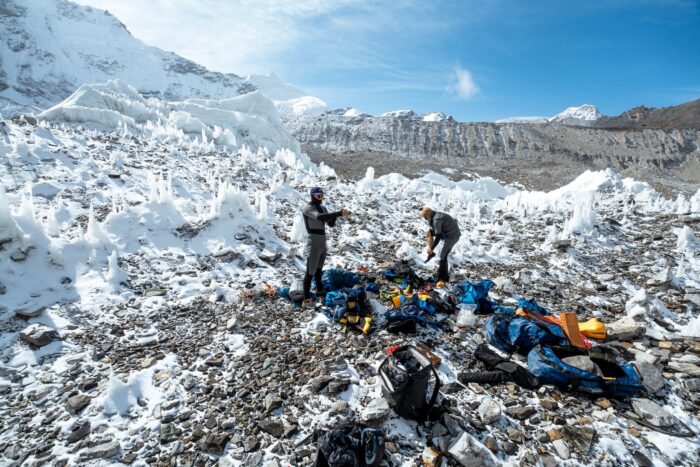
Gasherbrum II instead
So the two climbers are heading instead to 8,035m Gasherbrum II, where they will climb the normal route.
"[It's] not quite what Symon and I had in mind, but it’s the right move," Dubouloz admitted on social media.
At least, GII is far from crowded this year. Karakoram Tours Pakistan reported just 32 climbers on the mountain, aiming for GI, GII, or both. There is also a team from Nepal-based 8K Expeditions, led by Saila Mingma and outfitted by Summit Karakoram.
So far, the ropes have been fixed up to Camp 2.
No first ascent
The dry conditions have also spoiled the attempt of a Madison Mountaineering group to make a first ascent of a smaller peak near K2 while acclimatizing for the big mountain. Garrett Madison developed that strategy three years ago with a fit group of Ama Dablam clients. Instead of acclimatizing on an oft-climbed peak, clients had the added excitement of doing a first ascent in the Khumbu as prep for Ama Dablam.
This time, the team hoped to reach an untouched summit one day from Base Camp, while acclimatizing for K2. After climbing most of the night, the climbers reached the summit ridge at dawn but had to turn back when confronted with gendarmes of unstable rock.
The group did not mention the altitude or location of their chosen peak, other than noting that it was across the Godwin Austen Glacier from K2 and Broad Peak's Base Camps.
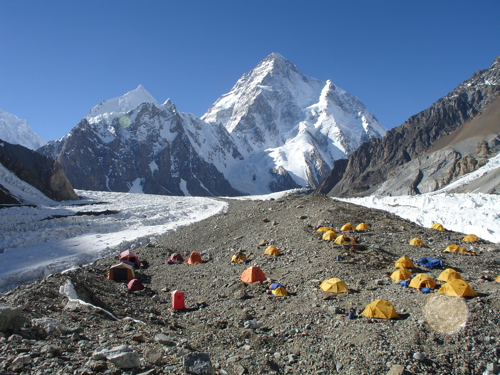
Waiting for Urubko
We are still waiting for news from Denis Urubko and Maria Cardell. The husband-and-wife pair set off last Friday for an alpine-style attempt at a new route on the Diamir face of Nanga Parbat. They estimated five days on the face, so they should be returning to flat ground at any time.
Two of the season's most interesting expeditions are acclimatizing near their 7,000m objectives in Pakistan, Gasherbrum IV and Yukshin Gardan Sar.
Meanwhile, Takayasu Semba of Japan, together with Nepalese climbers Pemba Geljen Sherpa, Ngima Nurbu Sherpa, and Mingma Nuru Sherpa, have summited an unclimbed 5,860m peak near Kanday village, in the picturesque Anaq (sometimes spelled Anaqar) Valley.
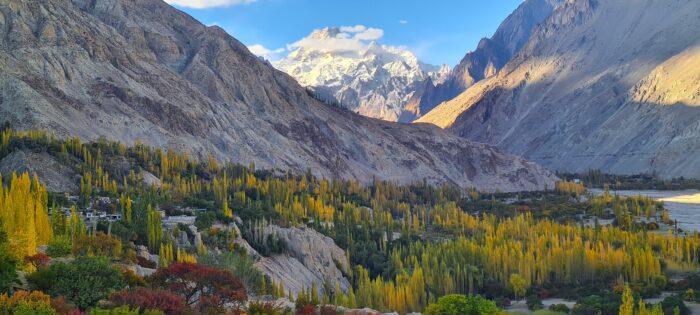
After a first failed attempt last year, Takayasu Semba returned with a strong Sherpa team. This time, they succeeded, topping out on July 4 at 12:30 pm Pakistan time, according to their outfitter, Karakoram Tours Pakistan.
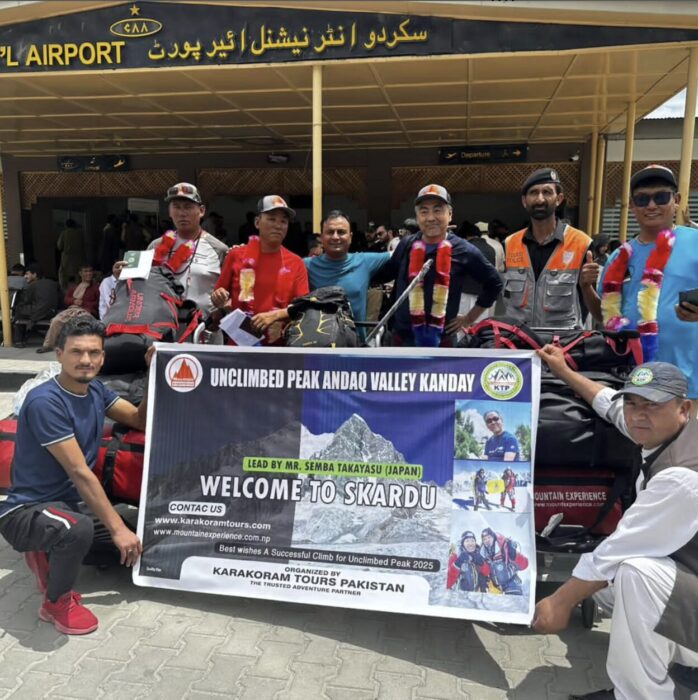
We have no information about the difficulty of the route, but the outfitter has posted a topo of the mountain, which they identify as Mt. Fono/Semba Peak, apparently including the Japanese leader's surname, which is highly unusual in the 21st century.
Nowadays in Pakistan, climbers may only name peaks with no local name -- some isolated peaks are simply identified with a number -- and only after permission from local authorities. The outfitter did write that the peak had no name.
In recent years, climbers have chosen names in the local language, after discussing it with the villagers who live in the area.


Interestingly, Kanday is the site of a charity founded by Sergi Mingote, who perished on Winter K2.
Yukshin Gardan Sar
Stefano Ragazzo of Italy has reached the Shimshal area, where he will attempt the first ascent of the 3,000m northeast face of Yukshin Gardan Sar (7,530m) with Michael Hutchins (U.S.) and Chris Wright (U.S./UK). On Monday, the team set up base camp on the glacier's moraine at 3,950m. They then started acclimatizing immediately, spending two nights at 5,100m.
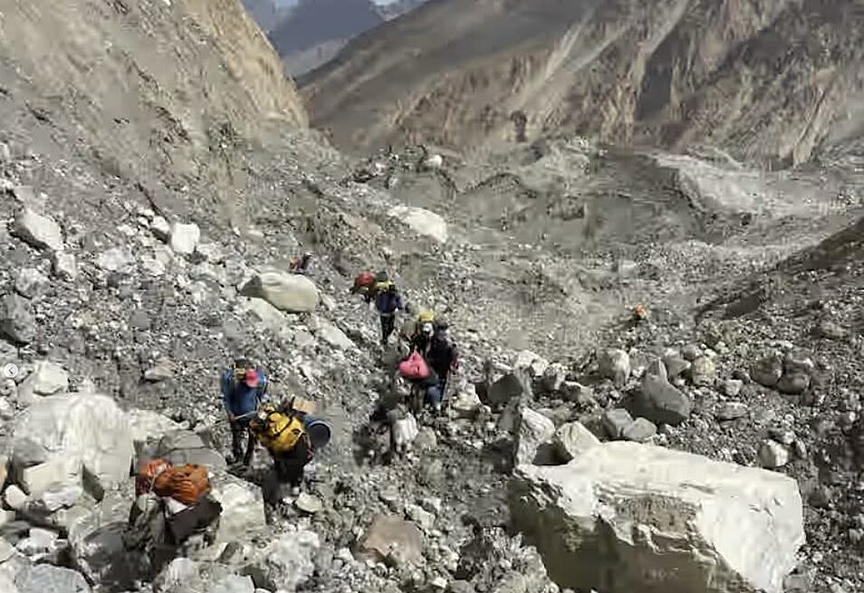
Gasherbrum IV
Charles Dubouloz and Symon Welfringer of France have also reached Base Camp at the base of Gasherbrum IV. They have leveled the ground on the moraine and pitched their tents on one side of the Baltoro Glacier, before the usual base camp of Gasherbrums I and II. Meanwhile, on GI and GII, Sherpa rope fixers have reportedly reached Camp 2.
Dubouloz and Welfringer will try to finish the route attempted by Jordi Corominas on Gasherbrum IV's famous West Face, known as the Shining Wall.

A second team will also arrive shortly at Gasherbrum IV. Italians Federico Secchi, Leonardo Gheza, and Gabriele Carrara will attempt the first repetition of the Bonatti-Mauri route up the Northeast Face, the route used on the first ascent of Gasherbrum IV in 1958.
Despite initial concerns about a potentially empty mountain because of the earlier India-Pakistan conflict, Nanga Parbat had at least some climbers on the normal Kinshofer route. They enjoyed a mountain without crowds, a Base Camp full of flowers, and very mild weather. But these same high temperatures also created difficult conditions that eventually proved lethal for one woman.
Klara Kolouchova of the Czech Republic fell to her death while descending at night. Two local climbers also needed help to make it down safely.
As the climbers return to Islamabad in Pakistan's scorching heat, here is a summary of the season's summits, rescues, injuries, and losses.
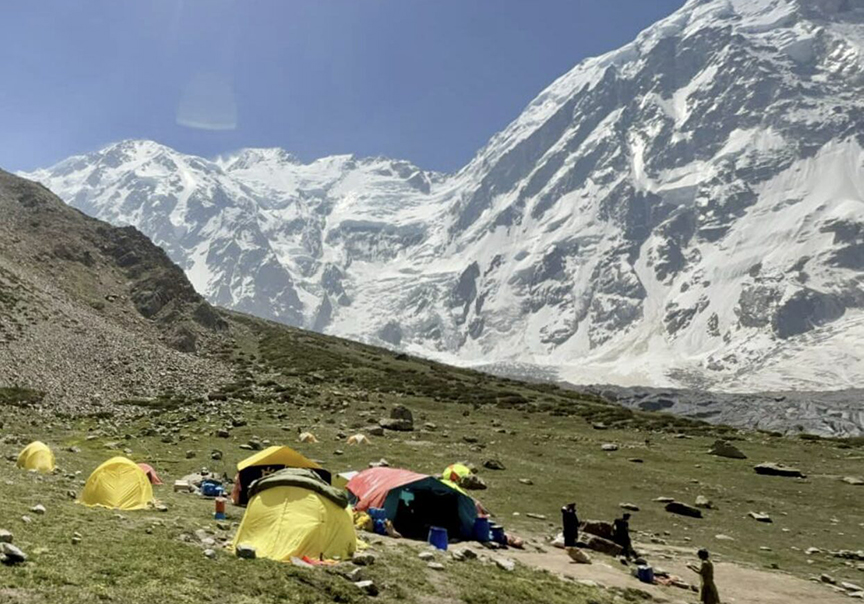
First summits and frostbite
Most climbers were with Seven Summit Treks, whose Sherpa guides immediately set about fixing the ropes. However, there was at least another small group, operated by Blue Sky Treks & Tours, at a different Base Camp.
With the rope fixing done only to above Camp 3, as most climbers rested in Base Camp after their acclimatization rounds to Camps 2 and 3, Marek Novotny and Ondra Hlasny of the Czech Republic set off for the summit ahead of the rest. They were the first to reach the top this season but suffered frostbite for their boldness.
"They spent too long in a bivouac, and one of them didn't take off his boots for days," Horia Colibasanu told ExplorersWeb. This climber frostbit several toes, while his partner suffered minor injuries.
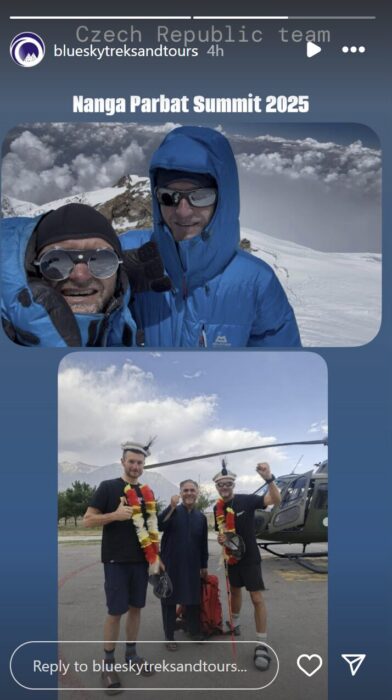
Single massive summit push
Virtually everyone else in Base Camp launched their summit push last weekend. But they climbed in different styles, at different paces, with different skills.
This year, the hardest section lay between Base Camp and Camp 3 because of long sections of unstable rock, frequent rockfall, and old black ice where even the front points of crampons hardly bit in.
July 3
The first group summited on July 3, with their Sherpas fixing the ropes as they went. It was mild but windy. Dorota Rasisnzka-Samocko said the wind reached up to 60kph. It was also a very long day, as the climbers on oxygen began from Camp 3. Seven Summit Treks reported four international climbers and four guides from Nepal and Pakistan.
Others, like Horia Colibasanu (without oxygen or Sherpa support) and Allie Pepper of Australia, with Mikel Sherpa and Pasang Sherpa, invested an extra day and pitched a Camp 4 at around 7,000m to ensure a shorter, safer summit day. They reached the top the following morning.
July 4
On the second day, three climbers summited without bottled oxygen: Horia Colibasanu of Romania, on his 11th 8,000'er, and two Pakistani climbers: Sohail Sakhi from Hunza and Ashraf Sadpara, from the village of that name.
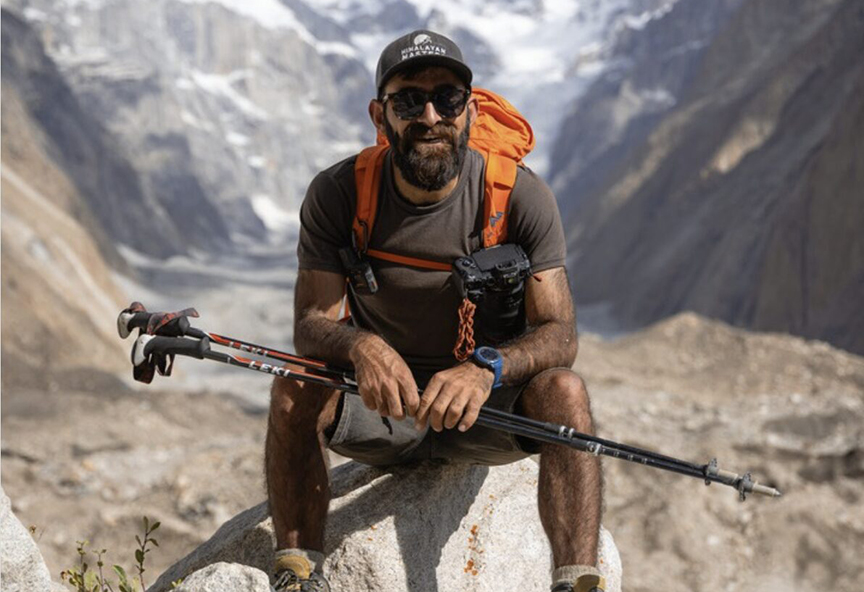
Accidents and rescues
Tragedy struck during the night of July 3. Klara Kolouchova of the Czech Republic felt too tired and decided to abort her summit push at Camp 3. Instead of spending the night there, she asked her Sherpa to go down to Base Camp right away, in the dark. Her fall took place slightly above the Kinshoffer wall, between Camps 2 and 3. The Sherpa couldn't see exactly what happened or where Kolouchova fell. Other climbers noted that there are several crevasses in the area.
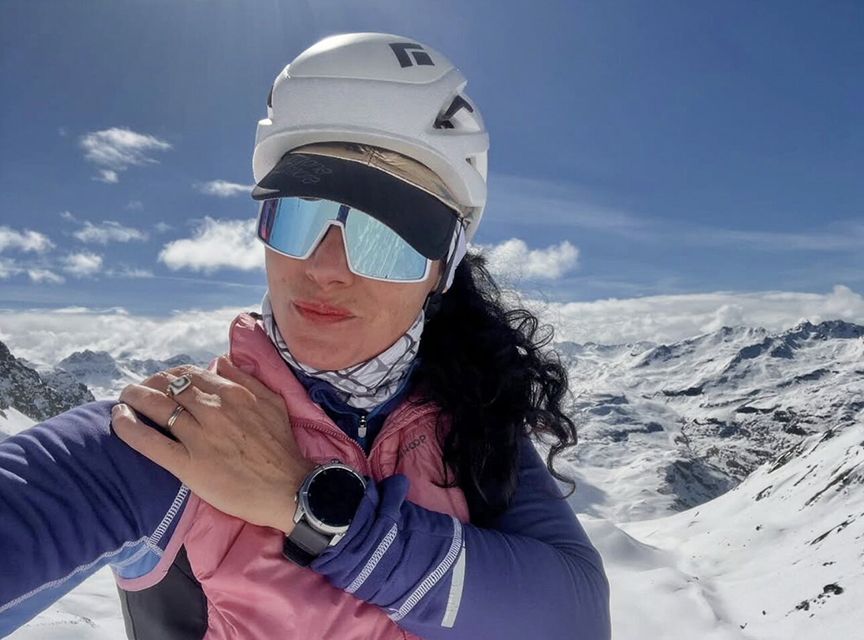
On July 6, helicopter pilots scouted the Kinshofer route and the surrounding area but couldn't find the fallen climber.
While descending from the summit, Colibasanu described how he found Saad Mohammed stuck on a ledge, in the middle of the Kinshofer wall. He had not properly secured his rappelling device and had lost it. Colibasanu showed him how to rappel with a Munter hitch knot and a carabiner.
After an hour, he checked that Mohammed was doing well and continued down. Later, Colibasanu learnt that two high-altitude porters had left Base Camp to assist Mohammed down. His climbing partner, Tasheen, also needed some help on his own descent.
Asma Al Thani, climbing with Elite Exped, slipped and fell during the descent and needed stitches at Base Camp, but the Qatari princess -- who has been climbing with Elite Exped for several years -- was otherwise okay.
Climbers were supposed to be welcome to climb Tirich Mir for free on the anniversary of its first ascent, but a police officer thought otherwise and turned away a Slovenian team last week.
The expedition team was led by well-known alpinist and university professor Irena Mrak. The climbers had just reached Shugerbaysum Camp in the Tirich Valley and were setting up camp when a lone policeman showed up, Chitral Today reported.
Safety concerns
The policeman told the climbers that he was following orders and said that safety concerns required the team to leave the area.
"He [said] that if any untoward incident happened with the team, the police would be held responsible," Chitral Today wrote.
The local government of Khyber Pakhtunkhwa, the region of Pakistan that hosts that part of the Hindu Kush, had previously announced that climbing permits in that region would be free in 2025 and 2026, to celebrate the 75th anniversary of the first ascent of Tirich Mir by a Norwegian-British team. Tirich Mir permits were also free last year, but the measure now extends to the entire Pakistani Hindu Kush, which contains many mountains above 7,000m. At that time, there had been no mention of any safety issues.
Operators in despair
The news is another blow to local outfitters, who are already dealing with a slow season.
"We urge the authorities to create a clear policy for adventure tourism in the Hindu Kush region, support local initiatives, and help build a positive image of Chitral as a safe and welcoming destination for explorers and mountaineers," said Ali Saltoro of Alpine Adventure Guides. "If it happened again, then no tourists can visit the Hindu Kush region in the future."

Now what?
The expedition was called off, and the climbers were left pondering their options. At first, they considered a peak in the Karakoram, within Gilgit-Baltistan, but in the end, the team opted to stay in the Hindu Kush and attempt 7,492m Noshaq on the Afghanistan border, the second-highest peak in the area.
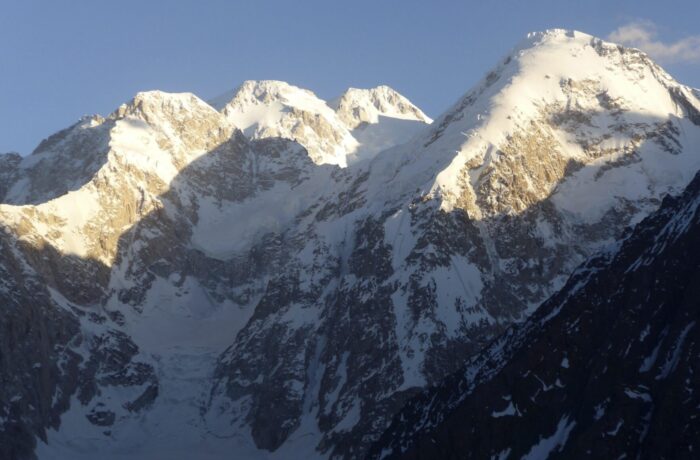
Climbers on K2, Broad Peak, and Nanga Parbat agree the main danger this year is the lack of snow and the constant rockfall, caused by extremely dry and warm weather.
Down in the valley, even mountain villages are approaching record temperatures of nearly 50º.

Raining stones on K2
Serge Hardy of France reports that one of the many rocks falling on the route hit a Nepalese staff member in the leg. Camp 1 and the route to Camp 2 are almost completely on rock and experiencing significant rockfall.
Hardy planned to head to Camp 2 today.
On Broad Peak, climbers are acclimatizing by going up to Camp 2, which is also surprisingly dry.
"When your goal is an 8,000'er, you probably expect snowstorms, freezing temperatures, and avalanches," reported Lukasz Supergan of Poland. "Since I arrived, hardly any snow has fallen. This means that parts of the route I would normally take through snow are now rocky and unstable. Climbing there is unpleasant and risky, as kilos of stones keep falling from underfoot."
When not on rock, the climbers must progress on brittle ice where, according to Supergan, it is not possible to dig steps. Climbers have to use their crampons' front points, which gets tiring.
To illustrate, Supergan posted a photo of Camp 2:
From summit to oven
Horia Colibasanu returned from the summit of Nanga Parbat looking forward to comfort and rest in Chilas village. Instead, he landed in what he described as an oven: a room with no air conditioning in 46ºC (115˚F) temperatures, although Horia said it felt like over 50º indoors. However, outdoors was not much better, due to the scorching wind. Chilas is at 1,250m above sea level.
"The wall was hot, and I couldn't touch the bathroom counter with my wet palms...I took a shower with cold water from the mountain, it came out hot, and I instantly felt nauseous."
Colibasanu has been climbing in Pakistan for years and says he had not experienced such heat since 1997, when he also suffered 47.7°C in July. In fact, July 17, 1997, registered the highest temperatures ever recorded in Gilgit Baltistan, until now. This record was broken on Saturday, one day before Colibasanu reached town.

Three Chileans have opened a 400m new route on Urus, a 5,000m peak in Peru.
Vicente Urzua, Maximiliano Arias, and Eduardo Tapia are regulars on the Patagonian big walls during the austral summer. When winter settles in, they travel north to climb in the tropical climate of the Peruvian Andes.
The new route goes to the west summit of 5,450m Urus in the Cordillera Blanca range. Urzua reported on social media that they climbed via the southwest face in two attempts. First, they dealt with a pitch on mixed terrain and good rock. Later, they advanced up the face by connecting sections of snow and ice to the summit ridge. From there, they continued on mixed terrain to the top.
The resulting 400m route is up to 85º and has a degree of difficulty of M6/WI3, according to the climbers. Named Vuelta Austral ("Austral Tour"), the line runs left of Mi Carnal, another new route of similar difficulty, recently opened on Urus West by Alexander Gruber and Inaki Herrasti of Mexico.
Tomorrow, Denis Urubko and his wife, Maria Cardell, will set off from Base Camp via a new route on the Diamir Face toward the summit of Nanga Parbat.
"The route is calling," Urubko told Mountain.ru. The Russian climber said that he and Cardell expect to spend four or five nights on the face during their pure alpine-style push.
Climbers elsewhere on Nanga Parbat and on other Karakoram 8,000'ers report very dry conditions and frequent rockfall. On the other hand, the weather has remained stable and warm.
Yesterday, some climbers reached the summit of Nanga Parbat while Klara Kolouchova of the Czech Republic lost her life in a fall.
Today, one of the Nepalese outfitters on the mountain has reported on the summits and given an official version of Kolouchova's accident.
Recent summiters included Nepalese Dawa Sherpa, Pasang Dukpa Sherpa, Lakpa Temba Sherpa, with Ali Hassan of Pakistan, who supported the climbers and fixed the ropes to the top as they went.
The international climbers were Dorota Rasinska-Samocko of Poland, Paula Strengell of Finland, Jorge Egocheaga of Spain and Rana Hassan of Pakistan. Unfortunately, Seven Summit Treks has not said whether the climbers used supplementary oxygen. Egocheaga has never used it, and Rana Hassan also wanted to climb without it.
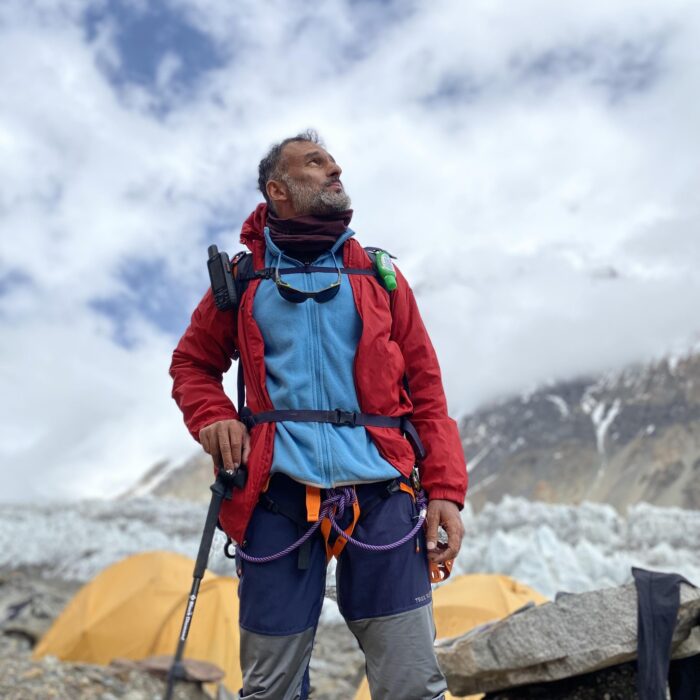
July 4 summits
Horia Colibasanu summited Nanga Parbat at 7 am after a "long, hard night" from Camp 4. Colibasanu climbed on his own, with no oxygen or support beyond Base Camp. This is his 11th 8,000m peak, all in the same style.
It took Colibasanu nine hours to reach the top without oxygen from his Camp 4 at 7,100m.
Seven Summit Treks confirmed that Allie Pepper of Australia, with Mikel (Mingtemba) Sherpa and Dawa Sherpa have also reached the top.
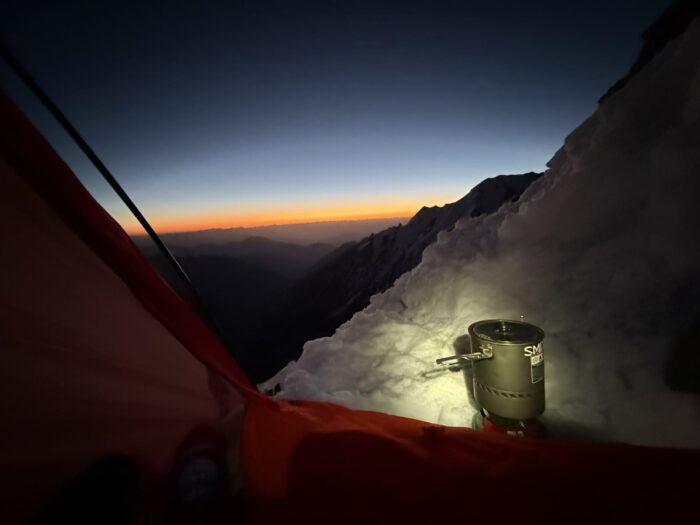
Locals on top
In addition to staff working on the mountain, several Pakistani climbers have succeeded on Nanga Parbat.
Sohail Sakhi from Aliabad, Hunza, summited today on his own without oxygen or Sherpa support at 11 am. Sakhi previously summited K2 and both Gasherbrums. Shezad Karim, on O2, summited at 1 pm.
Ashraf Sadpara also summited and has now climbed all of Pakistan's 8,000'ers. He has also climbed K2 three times. Sadpara is the son of Ali Raza, a well-loved figure in Pakistani mountaineering, who dedicated years to mentoring young local climbers.
Saad Mohammed was supposed to be in the summit group this week, but things have not gone well for him. As he wrote on X, he needed two bivouacs to reach Camp 2 on Wednesday. He has remained there until today, suffering from fatigue and dehydration. Today, he is on the move to Camp 3.
Kolouchova's accident details
Seven Summit Treks has also provided some details on the fall that took the life of Klara Koluchova. They explained that the Czech climber fell above Camp 2 while she was descending. At the time, her supporting Sherpa, Taraman Tamang, was with her.
"She slipped on a rocky section of the mountain," 7ST wrote.
The agency also denies preliminary reports of an oxygen bottle explosion being involved in the accident. They offered a somewhat strange explanation: "The loud sound heard was caused by an oxygen bottle striking a rock during the fall, which created a noise resembling an explosion."
They added: "We kindly ask everyone to help disseminate accurate information and to respect the sensitivity of this tragic situation." Yet they avoid speaking of Kolouchova as deceased, merely identifying her as "missing," which also creates confusion.
Media around the world have reported on her death, which the Pakistani authorities have confirmed. The Czech media also revealed that Kolouchova's husband was a member of the expedition but didn't intend to climb beyond Base Camp.
The Pakistan army has deployed a helicopter to search for and retrieve Kolouchova's body from the mountain.
On the lower slopes of Nanga Parbat, well below those going for the summit, Czech climber Klara Kolouchova has died in an accident. The fatal circumstances remain murky.
The online media in Pakistan have posted different explanations. Early reports spoke of the explosion of an oxygen bottle. However, a later story in The Pamir Times suggests that Kolouchova fell somewhere between Camp 1 and Camp 2 at around 4 am this morning.
Climbing partners' report
“Her teammates later confirmed her death after reaching Base Camp, though the body remains at the fall site," Diamir's Additional Deputy Commissioner (ADC) Nizamuddin told The Pamir Times.
According to reports, Kolouchova was on Nanga Parbat with her husband and five other climbing partners. They had reached Base Camp on June 17. It is not clear whether they formed an independent group or were part of a larger team.
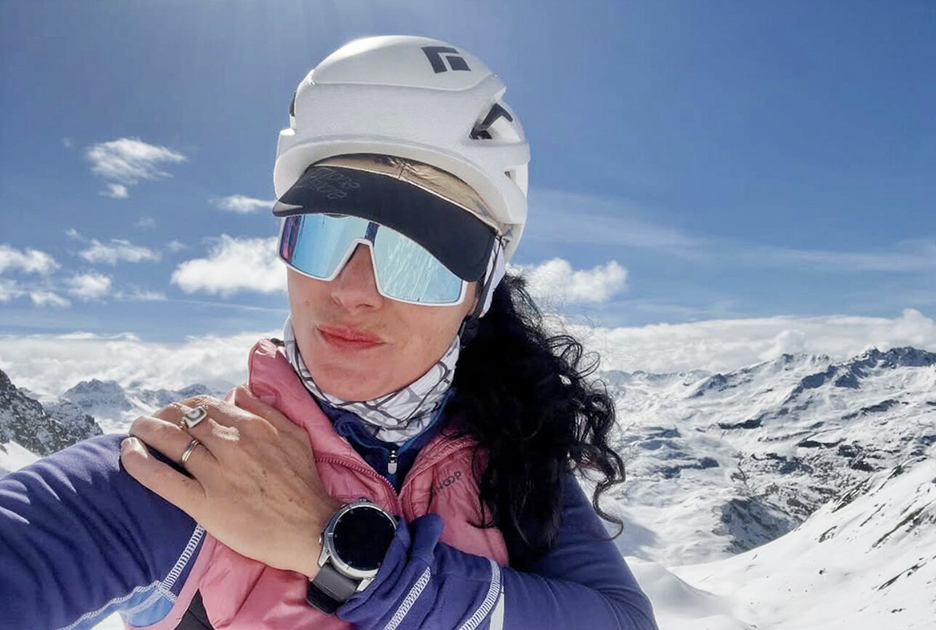
Tough conditions
Climbers on the mountain have reported tough conditions on the mountain this year because of high temperatures. There is little snow until Camp 3, and climbers have to thread past rocky sections and elsewhere, use the front points of their crampons on bare ice. There have also been several rockfalls.
Kolouchova was a cautious climber who was ready to turn around if conditions were too risky. That is what happened on her first attempt on Nanga Parbat last year. She aborted her attempt shortly after the Kinshofer wall because of weather and snow conditions.
Karrar Haidri, Secretary of Pakistan Alpine Club, confirmed her death and noted that an army helicopter will fly tomorrow morning to locate and retrieve her body.
Kolouchova, 46, was the first Czech female climber to summit the world's three highest peaks (Everest, K2, and Kangchenjunga). She had previously climbed Cho Oyu and, in 2024, added Annapurna to her successful 8,000m list. This past spring, she attempted Dhaulagiri. She was a mother of two.
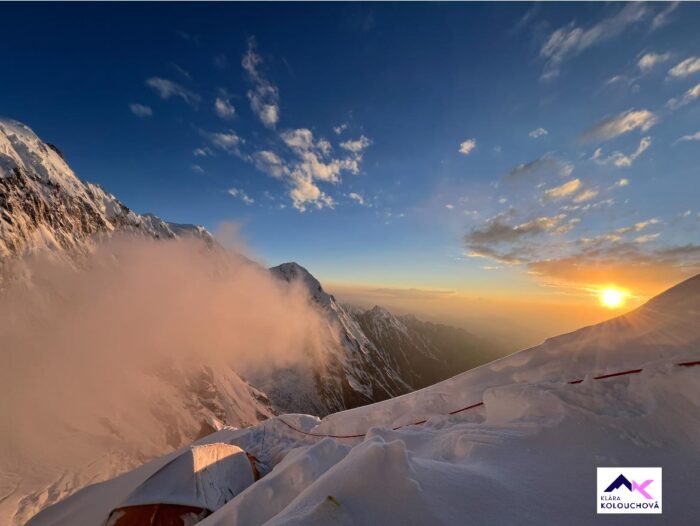
Waiting for news about summits
Meanwhile, news is expected from the climbers who are high up on the mountain. Horia Colibasanu of Romania -- climbing independently without oxygen -- and Allie Pepper of Australia -- climbing with Mikel Sherpa -- will leave for the summit tonight.
Tashfeen of Pakistan, also without oxygen, is heading to Camp 4. Dorota Rasinska-Samocko of Poland returned to Camp 3 after summiting earlier today. There is very little information from the mountain, where there is no internet or cell connection.
A six-year-old boy summited 5,642m Mount Elbrus last week to the delight of his family, which hurried to claim the age record -- to the dismay of most of the climbing community.
Teghbir Singh from Ropar, India, reached the top of the highest peak in Europe on June 28, according to The Tribune of northern India.
Young Teghbir received an official certificate from the Mountaineering, Rock Climbing, and Sports Tourism Federation of Kabardino, Russia. It stated that he is the "youngest summiter on Mount Elbrus at the age of 6 years, 9 months and 4 days." The Tribune posted a summit picture of a not-so-happy-looking kid wrapped in mountain clothes too big for him.
It took Teghbir eight days to reach the top with his father, Sukhinderdeep Singh. His mother, Manpreet Kaur, a gynecologist, seemed proud. She told NewsonAir that her son had followed a special diet and had the support of a trainer.
To climb Elbrus, all you need is to pay a fee to enter Priyelbrusie National Park and a $25 climbing permit from one of the rangers' offices, according to Elbrus Travels.
Not the first
Teghbir Singh was not the first Indian kid to summit Elbrus. He actually broke a previous mark set by another Indian child, Wagah Kushagra, who summited last year at age seven.
While not common, some families push the age limits in taking their kids to higher places and then claiming world records. In 2021, international climbers expressed concern about a 12-year-old girl, Selena Khawaja of Pakistan. She had been left alone with two porters to climb Broad Peak after her father was evacuated due to illness. Three years later, in 2024, Khawaja attempted Nanga Parbat, this time with her father.
Nepal only allows those 16 years and older to climb its 8,000m peaks. It is not clear whether that age limit applies to lesser peaks, but some outfitters will not accept clients below that age on any climb.
Everest Base Camp
Trekking is a different story. Some parents take their kids to Everest Base Camp. Outfitters say that is an option as long as the trek from Lukla is extended to 10-11 days instead of the usual 6-8. This is to ensure the kids are fit and healthy and enjoy the hike. Local outfitters tend to agree that the trek to Everest Base Camp is doable for kids seven or older, so that they are mature enough to tell their parents if they feel sick.
Aerial rescue services are good in Nepal, but even helicopters may be grounded in bad weather, and Acute Mountain Sickness is a serious condition, especially in a young child. Parents who take their kids to the mountains may get some headlines in the local press, but also face strong criticism when things go south. Such is the case of Rakcent Wong, 35, and Carol Tan, 36, a Singapore couple who were traveling the world with their four-year-old boy, Atlas Wong. They tried to reach Everest Base Camp last year but never made it because Atlas was evacuated with AMS.
Kids as young as two years old have been with their families to Everest Base Camp at 5,300m. Carter Dallas of the UK reached it in January 2024, shortly before turning three. In March 2024, Siddhi Mishra of India was there at 2 years, 11 months, which got her into India's Book of Records. This spring, an Australian toddler "beat" them all:
A group of climbers has summited Nanga Parbat, according to the tracker of one of them.
Several climbers set off from Camp 3 (6,700-6,900m) yesterday for a long summit day. According to Allie Pepper of Australia (who will try to reach the top tomorrow), rope fixers marched at the front, preparing the route as they climbed. Neither Seven Summit Treks nor other outfitters has reported on their teams' progress, but individual climbers have texted their home teams via satellite. There is no Wi-Fi connection at Nanga Parbat Base Camp.
Steady progress
Dorota Rasinska-Samocko of Poland messaged her home team at 4:30 am local time, noting that her group had just crossed the high plateau before the summit pyramid. She estimated it would take them another four to five hours to top out. Her tracker subsequently verified her estimates. The signal shows steady progress, and she reached the top at 11:00 am Pakistan time. At the moment of posting this story, she is proceeding down at a good pace and nearing Camp 3.
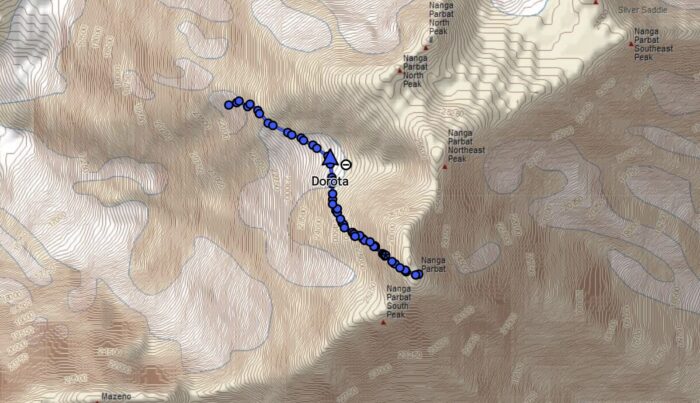
This is Rasinska-Samocko's second time on the summit of Nanga Parbat. She completed the 14x8,000'ers last year, becoming the first Polish woman to finish the challenge, after two busy years. She summited Nanga Parbat and six other 8,000m peaks in 2022. At the time, she was part of the group outfitted by Seven Summit Treks that maintained an intense 14x8,000m climbing schedule. It culminated in her summit of Shisha Pangma in the fall of 2024.
Not the first summits
The commercial climbers were not the first on top this time. Marek Novotny and Ondra Hlasny of the Czech Republic went ahead of the rest and summited last week on the normal route, without the fixed ropes. And on June 24, David Goettler of Germany, plus Tiphaine Duperier and Boris Langenstein of France, summited via the difficult Schell route from the Rupal side of the mountain. The French climbers then made a complete descent on skis, and Goettler paraglided back to Base Camp.
We are still waiting for news from Denis Urubko and Maria Cardell, who planned to climb a new route alpine style on the Diamir Face of the mountain.
Climbers on Nanga Parbat reached Camp 3 today, despite tough conditions from the lack of snow. Still, that was the easy part. Now they need to decide whether to face uncertain forecasts and an extremely long summit day in order to follow the Sherpa rope fixers, or to wait another day.
The winds are strong, but they are not cold. Several climbers have commented on how warm it is at altitude.
Windy Camp 3
Horia Colibasanu is still in Camp 3. He was planning to move his camp higher today, but changed his mind and stayed at 6,650m for a second night.
"The wind is starting to blow...It would be too risky to head up at night, without oxygen, in these conditions," he said.
Instead, he will set off at 8 am, carrying his tent and supplies. He still intends to set up a fourth camp.
Allie Pepper and Mikel Sherpa are also in Camp 3, with the Australian climber admittedly exhausted after climbing long sections on rock and bare ice, front-pointing on her crampons. "[That] destroyed my feet and legs," she said. "There were falling rocks too, which was terrifying."
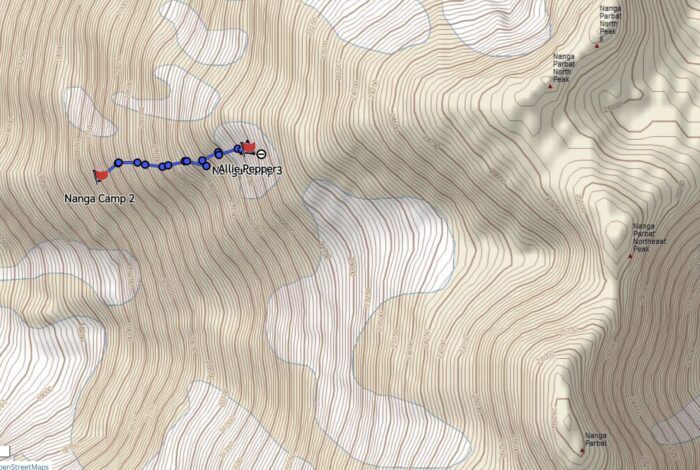
Pepper and Mikel Sherpa have their Camp 3 tent at 6,800m, a little higher than Colibasanu. Still, it is a long way to the top, so they, too, plan to move to Camp 4. However, not everyone is following the same strategy.
Rope fixers, others go tonight
As we have mentioned recently, outfitters are providing little or no information about progress on the mountain. We don't know, for example, if the ropes are fixed beyond Camp 3 or if there are tents at the altitude of Camp 4. Most climbers are communicating with home via their InReach devices, but not every home team shares that news on social media. However, Pepper's does, and she has reported that a group of climbers is leaving tonight and will go all the way to the summit behind the rope fixers.
These climbers are relying on supplemental oxygen and the strength of their guides to endure the long hours ahead. The summit is nearly 1,300 vertical meters above and also a long way horizontally.
Yet, the hardest part will be the descent. The tired summit climbers will probably need to rest and rehydrate at Camp 4, if tents and supplies are properly in place.
Dorota Razinska-Samocko of Poland is also in Camp 3 and confirms the difficult conditions getting there and pitching a tent.
"It took us [two hours] to make the platform," she texted. She and the group she is with intend to go for the summit tonight.
It's always exciting to get the first reports from K2. Despite commercialization, the allure of Savage Mountain has remained. But news is hard to come by this year.
French loner in Camp 1
As on other Pakistan 8,000'ers, the first reports this season have come from independent climbers. Serge Hardy of France is climbing on his own and has already been to Camp 1. The mountain is empty, but it was still hard for him to find a spot at Camp 1 (6,060m) for his tent.
"It took me three hours to build this pathetic terrace," he admitted. "There is a battle of sorts to get a decent spot to pitch tents at Camp 1, which is not exactly flat and exposed to falling rocks."
He says that "the big Nepalese agencies, the ones with wealthy clients," have snapped up all the available room. In the end, Hardy pitched his tent in a rather uncomfortable location on tilted scree.
The 8K Expeditions team reached Base Camp on June 27 and should have fixed at least part of the route by now. The Elite Exped and 14 Peaks teams are on their way to Base Camp.

Hardy, 58, is a climber and a local politician from Brest, in northern France. He summited Gasherbrum II in 2021. It is not yet confirmed whether he will climb with someone else or use supplementary oxygen.
'No one reports anything'
"Nobody reports anything, but the big Nepalese agencies are already fixing the route and waiting for their clients to arrive," the Alpymon blog confirmed. It describes 2025 as "the silent season." Everyone trying to follow the events on Pakistan's 8,000'ers has noted the lack of even basic details about the teams' progress.
Hopefully, as the mountain gets busier, some teams will be more prone to share news. U.S.-based Mountain Professionals is expected to arrive in Base Camp today. Recently, they took advantage of the Wi-Fi antenna installed at Concordia to send some photos:
Some climbers are currently acclimatizing on Broad Peak, before heading to the harder, higher K2.
Climbers are currently approaching the end of the packed trail on Nanga Parbat. The ropes are not yet fixed to the summit.
Horia Colibasau of Romania is resting today at "his" Camp 3, which is at just 6,650m. That's still far from the summit in both in altitude and distance, as seen in our Featured Image above.
"I'm thinking of taking my tent and climbing a little higher, to make it easier for me to go down and come back," he said.
This way, Colibasanu will launch his final summit push at night between Thursday and Friday.
Exhaustion vs shortage of supplies
In recent years, climbers have faced exhaustion and frostbite on Nanga Parbat due to the extremely long summit day from Camp 3. The 2023 season was particularly dramatic. Pawel Kopec of Poland died of exhaustion barely 200m from the tents. Azif Bhatti of Pakistan had to be helped down by Israfil Ashurli of Azerbaijan, who sacrificed his own summit bid.
On the other hand, spending one more day at altitude might leave Colibasanu short of supplies.
"I'm preparing some soup and a hot tea, then I'll start calculating gas and food, to decide whether to stay a day in Camp 4 (7,100m) or go straight to the summit," he told his home team.
Pepper in Camp 2
Allie Pepper of Australia and partner Mikel Sherpa are in Camp 2, according to Pepper's tracker. Their plan is to summit on Friday.
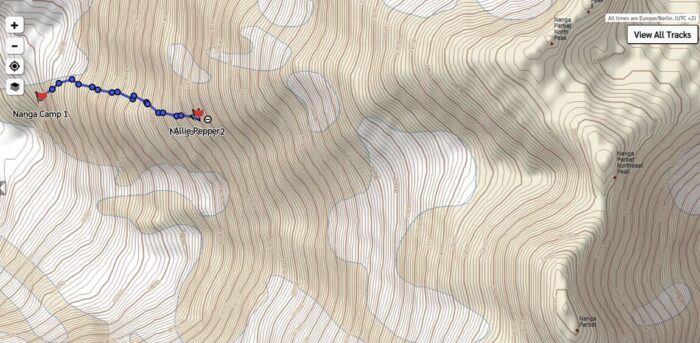
On June 24, Tiphaine du Perier and Boris Langenstein of France climbed the Schell route of Nanga Parbat. They then skied down the Rupal Face, which rises 4,600m from Base Camp to the summit.
This is the first ski descent of the Rupal Face and the first ski descent of 8,126m Nanga Parbat from the summit.
David Goettler summited with them and paraglided from 7,500m down to Base Camp.
Right strategy
This year, the team chose the right strategy: They acclimatized in Nepal in late May, then climbed Baruntse in early June. Then they flew to Pakistan and went right to Nanga Parbat. With the mountain in a dry condition and with rising temperatures, they prepared for a fast summit push, they told Montagnes magazine.
The trio set off from Base Camp on June 21 and climbed one camp a day until the summit morning, in perfect conditions.
Goettler and his companions chose the Schell route. Instead of heading directly up the Rupal Face, it traverses that side of the mountain to gain a ridge, and then from Camp 3, it switches to the Diamir side of the mountain.
That crossing was also the crux of the ski descent. The skiers described the descent from the summit as okay, but the traverse to the Diamir side on skis included an unpleasant mixed section with a lot of bare rocks, and a 30m rappel back to the Rupal side.
Success at last
As for Goettler, he has finally finished a project that has taken him five attempts, including two in winter. The German climber first descended a section on foot, then paraglided from approximately 7,500m at 6 pm in good conditions. He landed at Base Camp 30 minutes later.

Duperier and Langenstein had skied down Nanga Parbat's normal, Kinshofer route on the Diamir side in 2019, but that was not a complete descent. On that occasion, Duperier stopped before the summit, and although Langenstein reached the top, he had to descend some 50 vertical meters on foot until he found conditions suitable for skiing. Duperier waited for him and joined him on the way down.
There is news from both sides of Nanga Parbat: Czech climbers Marek Novotny and Ondra Hlasny have bagged the first summits from the normal route on the Diamir side, while David Goettler has finally -- after five attempts! -- triumphed from the Rupal side. He partnered with French skiers Tiphaine Duperier and Boris Langenstein.
At Base Camp on the Diamir side, most climbers have started a massive summit push. However, the route is not yet completely fixed, and conditions are deteriorating fast.
Diamir side
Sa'ad Mohamed of Pakistan confirmed that two Czech climbers, whom he identifies only as Marek and Ondra, summited at noon on June 26. We would welcome the help of the community to find their complete names. The expedition outfitter, Blue Sky Treks and Tours, posted the following story on Instagram:

Sa'ad Mohamed, climbing without oxygen, set off from Base Camp yesterday, accompanied by a partner identified as Tashfeen. They reached Base Camp at 4:40 pm and reported difficult conditions.
"The route up to Camp 1 has considerably deteriorated," Mohammad noted, referring to the effects of the intense heat.
Route in poor state
Meanwhile, Doroka Razinska-Samocko of Poland reached Camp 2 at 4 am today.
"We are climbing at night to avoid falling rocks and avalanches," she reported. "Everything is melting and sliding down. The Kinshofer Wall was difficult in these conditions."
Razinska-Samocko said she had climbed with Pasang Sherpa to Camp 2 but will proceed to Camp 3 tomorrow on her own. She will then go to Camp 4 the following day.
"It won't be easy -- we will need to fix ropes," she noted.
Horia Colibasanu of Romania is also in Camp 2, preparing to head for Camp 3. He mentioned that a rock fell on a tent near his. Luckily, no one was injured.
Ali Pepper of Australia, climbing with Mikel Sherpa and intending to summit without oxygen, also reported that the glacier sections are quickly melting under the witheringly hot temperatures. They planned to leave Base Camp today, 24 hours later than most climbers, hoping the route would still be safe.
Rupal Face
David Goettler confirmed on Instagram that he summited Nanga Parbat and posted what looked like a summit photo of him and French skiers Boring Langenstein and Typhaine Duperier. Unfortunately, the German shared no details about the route or the style in which they did it. They planned for an alpine-style push up the Rupal Face and said that if conditions permitted, the French climbers would ski down and Goettler would paraglide.
We know at least that Duperier and Langenstein had their skis with them:
Duperier and Langenstein climbed and skied Nanga Parbat via the normal route in 2019. They wanted to repeat the feat down the huge Rupal Face. We will have to wait to see if they succeeded.
Goettler, 43, was attempting Nanga Parbat for the third summer in a row and his fifth time overall, always in alpine style.
Over 450 permits
Pakistani media have reported that as of last week, Gilgil-Baltistan authorities have approved 469 mountaineering permits. That's likely almost the total for the season, since in Pakistan, everyone applies for permits in advance.
"The Department received 555 applications for mountaineering permits in 2025, surpassing last year's total of 423," The News said.
So far, the overall number of climbers on Pakistan's 8,000m peaks seems rather small this season. However, climbers coming to K2 and Broad Peak will soon add to the action, as big teams such as 14 Peaks Expeditions are starting their approach trek this week.
Alpine-style teams
A significant number of alpine-style teams have headed to the country's lower but technical peaks. Some started their projects very early in the season and are already done. The overall rise in temperatures and its impact on conditions have already reshaped the plans of some climbers, such as those on Ultar Sar, Hunza Peak, and Spantik.
Others will wait for what they hope will be better conditions in late summer or early fall. Last year, for example, Adam Bielecki of Poland and Louis Rousseau of Canada attempted some first ascents in the Hunza region in October but had mixed luck.
As usual, climbers are advancing on Broad Peak before anyone tackles K2. But conditions during a particularly hot and dry season are making the going hazardous.
Lukasz Supergan of Poland has been up to 6,000m, above Camp 1, on a first acclimatization round. He reports how high temperatures are negatively affecting the route.
"[Above Camp 1,] we climbed a steep slope between brittle rocks in the middle of the night. High temperatures mean that we are not climbing in comfortable snow but on ramps covered in ice, on which there is a thin layer of 'sugar,' in which crampons have little grip."
The dry terrain also features unstable rock between Base Camp and Camp 1.
"I was standing at the base of the wall when a rock the size of a large microwave hit my friend who was descending with me," Supergan wrote. That made him decide to climb during the night and avoid the warmest hours of the day.
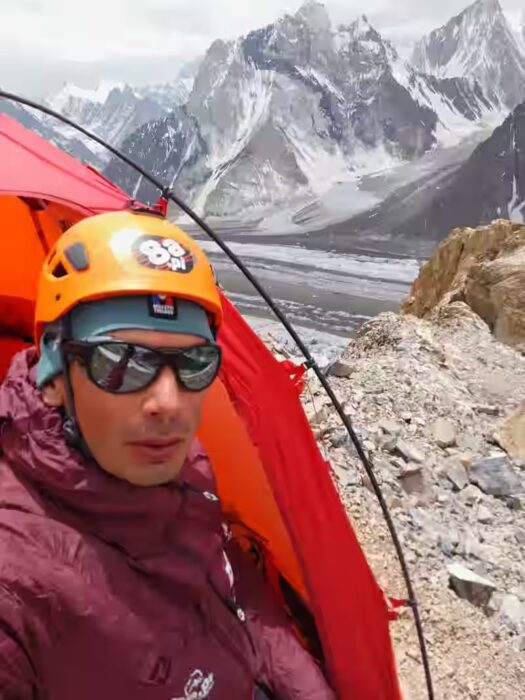
Supergan, who climbs without oxygen or a personal guide, attempted Gasherbrum II last year but had to turn around, again due to bad conditions from high temperatures.
This year, he is climbing with Seven Summit Treks in a team of 12 climbers, including some independents like himself. A guided group and the rope fixers are ahead of them. Supergan carries his own gear but has used the fixed ropes on the most difficult sections. Overall, there is a relatively low number of visitors in Pakistan this season.
Why Broad Peak first
Broad Peak offers a convenient, safe way for climbers to acclimatize (and to bag a summit if they have signed onto a K2-Broad Peak double-header). The logistics on Broad Peak are simpler, as the normal route requires only three altitude camps, while 8,611m K2 typically needs four. The normal route on 8,051m Broad Peak is a shorter, more straightforward climb from Base Camp to the start of the summit ridge.
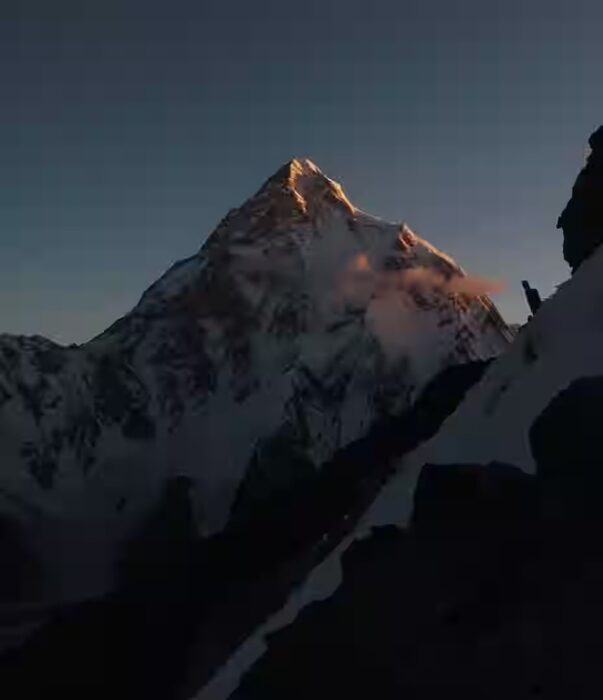
Typically, porters fix until Camp 3 (about 7,100m) and eventually to the col that marks the start of the ridge at 7,600m. That allows complete acclimatization, usually done without supplementary oxygen, on mostly easy terrain.
Once acclimatized, climbers can either summit Broad Peak -- often right behind the rope-fixers -- or turn to K2 if conditions are good and the route is prepared. K2 is a harder mountain, with no easy sections. As on Everest, where climbers try to cross the Khumbu Icefall as few times as possible, climbers with a permit for Broad Peak try to do all their acclimatizing there, and then head to do K2 in a single summit push. They usually use bottled oxygen on K2 from Camps 2 or 3.
Unfortunately, conditions on Broad Peak this year are not ideal, with broken glaciers at the base and dry sections prone to rockfall between Camp 1 and Camp 2.
This topsy-turvy season, we have more information from alpine-style teams -- usually a reticent bunch -- than from the 8,000m commercial teams. Possible summits may have occurred on Nanga Parbat, but nothing is confirmed. Hopefully, the flow of news will increase soon, as some K2 and Broad Peak teams have just arrived in Base Camp.
K2
The first big groups have just arrived at K2 Base Camp. That is, if any group can be considered big this summer, when the Karakoram 8,000'ers are unusually quiet because of the India-Pakistan conflict this spring.
Summit Karakoram reports that its first group in Base Camp includes only 12 climbers: a small group from Nepal-based outfitter 8K and a small team from the UK's Impact Ascents -- two climbers, two high-altitude porters from Pakistan, and one Base Camp crew member.
Among the new arrivals is Vibeke Andrea Sefland of Norway, who is aiming for her 9th 8,000m peak. She has posted a nice description of the approach trek on social media, below, and will use a tracker during the expedition so that everyone can follow her progress.
Teams from Seven Summit Treks, Madison Mountaineering, and EliteExped should also be coming, but have not yet arrived. Mingma David Sherpa, hoping to reach the top of K2 for a record 7th time, will lead the EliteExped group.
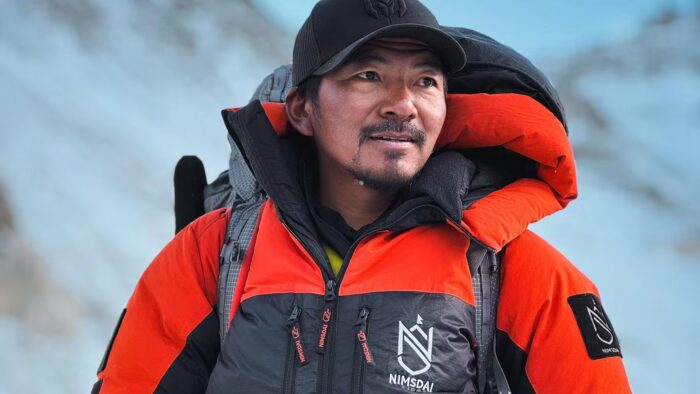
Nanga Parbat
Nowadays on the 8,000m peaks, climbers typically progress at the pace of the rope fixers. However, independent climbers may hurry ahead of them to summit before the crowds.
Yesterday, Pakistani climber Saad Mohammed wrote on X that two unidentified Czech climbers may have reached the summit. The information has not been confirmed. Today, clouds cover the upper sections of the mountain. Mohammed noted that the weather has been cloudy over the last two days, with rain in Base Camp.
At last word, the high-altitude staff have fixed ropes above Camp 2 but have not yet reached the summit. A significant percentage of those attempting Nanga Parbat this summer intend to climb without supplementary oxygen. Most of them have already been to Camp 2, then retreated to Base Camp to rest and wait for better weather.
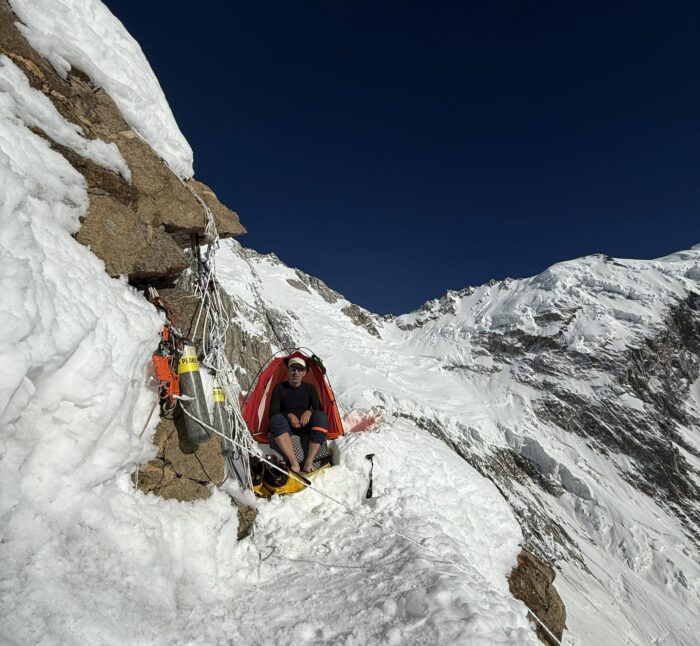
Benjamin Vedrines will again attempt to open a route on the north face of Jannu East with Nicolas Jean. The magnitude of the challenge is so huge that the peak they have chosen for their preparatory climb is -- K2.
Considering the relentless pace that Vedrines and Jean have kept over the last few weeks -- most recently, they climbed and skied the four faces of Mont Blanc -- we wondered if the French stars were planning something big in the Himalaya. Indeed, they were. The formidable north face of 7,710m Jannu East remains unclimbed despite many attempts, including theirs last year.
"This peak fascinates us. It’s beautiful, remote, tough to climb," Vedrines wrote on social media about Jannu East.

Fell under the spell
The two climbers -- Jean is 27 and Vedrines turned 32 two days ago -- tackled the challenge last fall, together with good friend and fellow member of the new generation of top French alpinists, Leo Billon. From the first, they fell under the spell of the legendary north face of Jannu East, one of the biggest and most difficult in the Himalaya. Their goal was to open a new route, not to the main summit, but to the 7,468m eastern point of the Jannu massif, which remains unclimbed.
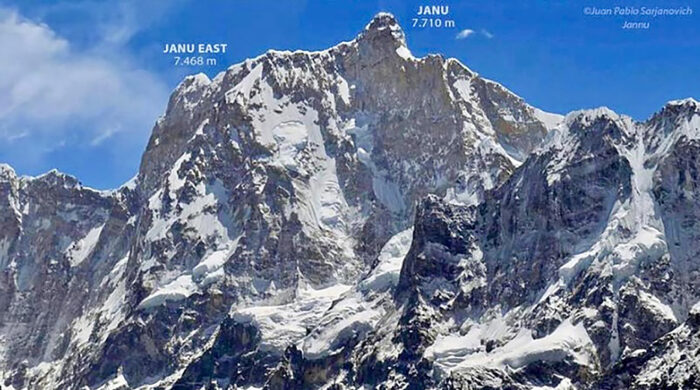
The trio climbed fast until 7,600m. There, Billon suddenly showed symptoms of cerebral edema. Vedrines, who had experienced the affliction himself on K2 two years earlier, immediately aborted the attempt. The three friends had previously decided that if one of them turned around, all would. (Check their expedition summary in the video below:)
"We promised we would return for a last attempt in September 2025," Vedrines said. Which brings us to their current expedition.
Their training peak
"For training, I’ll use K2," Vedrines said. Assigning the second-highest peak on Earth as a preparatory climb may sound crazy, but Vedrines did the same last year, with impressive results. He climbed K2 independently and without supplementary oxygen in a Fastest Known Time of 11 hours from Base Camp to summit. He then paraglided down from the top. After he landed, he still had time to return to Camp 2 to pick up his tent and to help another climber in distress.
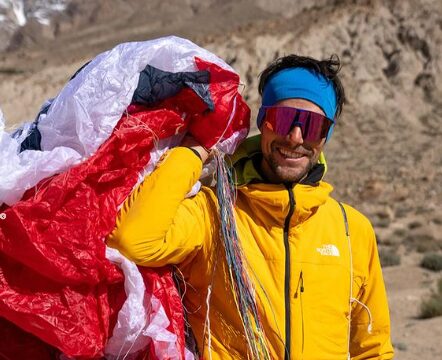
A third member?
Such a big face is usually tackled in teams of three. So will a third member join them? Leo Billon is himself frantically active in the Alps, but so far, there is no mention of him coming.
However, Vedrines did invite someone else: American Sam Hennessey, who politely declined, Hennessey told ExplorersWeb.
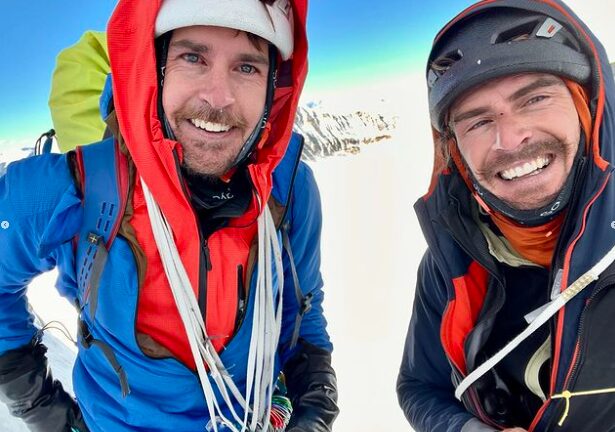
Hennessey had attempted to open a new route up the north face of Jannu East for the last three years. He was there last fall with regular climbing partner Mike Gardner when the French team showed up in Base Camp with the same plan. The two teams were following different lines when tragedy struck. Mike Gardner fell to his death from the bivouac where the two climbers were resting.
"As of now, I don’t have plans to return to Jannu...for a variety of reasons," said Hennessey, currently guiding in the Alps after a stint of climbing in Alaska. Hennessey rejects any suggestion that he is competing with Vedrines' team for this first ascent.
"[The French team] has every right to do so, of course, [but] having some sort of competition around alpinism is contrary to all the reasons why I find it appealing," Hennessey said.
Chris Wright, Michael Hutchins, and Stefano Ragazzo are leaving tomorrow for one of the most exciting expeditions of the year: an attempt on an unclimbed monster wall 3,000m high in an isolated region of the Karakoram. They will climb in alpine style and have very little information about what they will find.
Only last week, the team still thought they were going to India as planned.
"I was talking with Chris [Wright] yesterday and we realized that we will finally relax when we find ourselves flying to Pakistan," Stefano Ragazzo told ExplorersWeb from Chamonix, where he (and Wright) work as guides. "The hardest part of the expedition will be done, and everything else will be doing what we like."
Tomorrow, Wright (UK/U.S.) and Ragazzo (Italy) board a plane to Istanbul, where they will meet Michael Hutchins of the U.S. and fly together to Islamabad.
The three men received a $6,000 Cutting Edge Grant from the American Alpine Club for an expedition to the southwest face of Rimo III. They also received support from the Italian Alpine Club and the Mount Everest Foundation.
They applied for climbing permits in January, well ahead of time, but the border conflict between India and Pakistan sank their original plan.
"We had been waiting in vain for a green light from the Indian authorities for months," Ragazzo explained. "As the weeks went by, we started looking for a plan B, while keeping the original goal as our first option, until we simply couldn't wait anymore. We changed our goals and plane tickets on Monday."

The goal
They are now heading to the north face of Yukshin Gardan Sar (7,530m). This unclimbed face is twice as large as the one on Rimo III.
"The peak has three previous ascents, up the easiest ridge, but there are no attempts on any other side of the peak," explained Ragazzo. "Our plan is to climb a new line up the north face and the north ridge. We estimate we will need five or six days on the wall to reach the summit, and two more for the descent, climbing in alpine style."
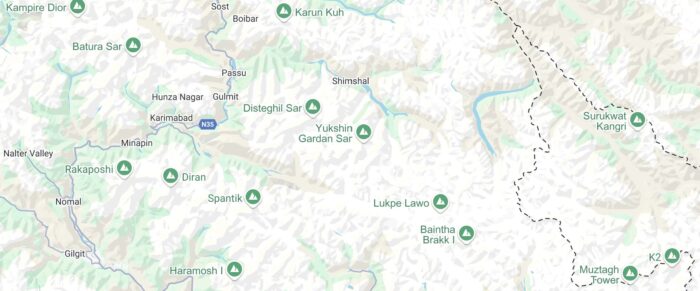
He admitted that they have very little information about the face and the area, except for some pictures shot by a science expedition in 2015. Called the Karakoram Anomaly Project, it studied why glacial lakes sometimes burst catastrophically and how to prevent this.
The climbers also consulted mountain geography expert Rodolphe Popier. He replied with a picture and a note that read: "Monster NE Face, over 3,000 vertical meters!"
"We need to get there and start climbing to properly assess the conditions and ponder our options, because no one has been on the line we want to climb," said Ragazzo.
The team will acclimatize elsewhere on the peak, which may help them evaluate from a distance the conditions on the face.
Exploration mode
The entire expedition has a strong exploratory component. They will have to set base camp pretty low down, at around 3,600m on a moraine, and the proper climb starts at around 4,400m and eight kilometers away from base camp, said Ragazzo.
"It is a huge climb, so we need to study it well and acclimatize as close to it as possible," he said.
Ragazzo explained that the lower part of the face will probably not be so difficult, and the crux will be in the middle of the headwall, on mixed terrain.
"We might acclimatize on the lower part of the mountain and then leave the headwall for the definitive push," he added.
Asked why they aren't acclimatizing on a secondary peak nearby, to keep to the strictest conditions of alpine style, Ragazzo noted there were no interesting peaks between their base camp and the foot of Yukshin Gardan Sar. He also said they had no time to consider a lesser peak, given their already hectic last-minute change of plan.
First-time team
The three members of the expedition have not yet climbed together, but Chris Wright is the joint connecting the other two.
"Chris and I regularly climb together...[in] Chamonix," said Ragazzo, "and he knows Michael from an expedition to India they did last year." He is referring to an attempt on Chiling II in Zanskar.

Yet Ragazzo is confident they will make a good team because each has different skills and excels in something.
Stefano Ragazzo recently rope-soloed Eternal Flame on Nameless Tower in Pakistan and completed the Nose on El Capitan in the same style. Wright received the Piolet d’Or in 2020 for his team’s ascent of Link Sar, and Hutchins has climbed six of the seven major peaks in the Fitz Roy massif.
"This kind of expedition involves a lot of mental strain, caused by the unknown terrain, the altitude, and the conditions," explained Ragazzo. "What I have experienced on previous expeditions will help for sure."
Ragazzo pointed out that the financial support through grants has really helped their preparation. "[It] allows us to devote more time to specific training and a bit less work as guides," he said. "Of course, guiding and specific training are complementary, but combining the two of them can be exhausting."
Climbing history of Yukshin Gardan Sar
Yukshin Gardar Sar lies in the Shimshal Valley of Pakistan's Karakoram. Its altitude varies with the source but ranges from 7,460m to 7,600m. Its most widely accepted altitude is 7,530m.
As Ragazzo pointed out, it has been climbed three times, all via the south ridge. An Austrian-Pakistani team led by Rudolf Wurzer made the first ascent on June 26, 1984. They approached from the Yazghil Glacier, camping on the west side, and climbed the south ridge in classic Himalayan style, setting camps along the route, according to their report in the American Alpine Journal (AAJ).
That first ascent was a race between them and a Japanese team from Tokyo University led by Kenshiro Otaki. The Japanese tried to find a line up the north face and failed.
"After a month’s effort, we gave up because of vertical and brittle rock," member Akira Suzuki reported in the AAJ.
In the end, they switched to the south ridge. When they summited, they found the flags left by the previous team. However, the Japanese climbed the ridge in alpine style.
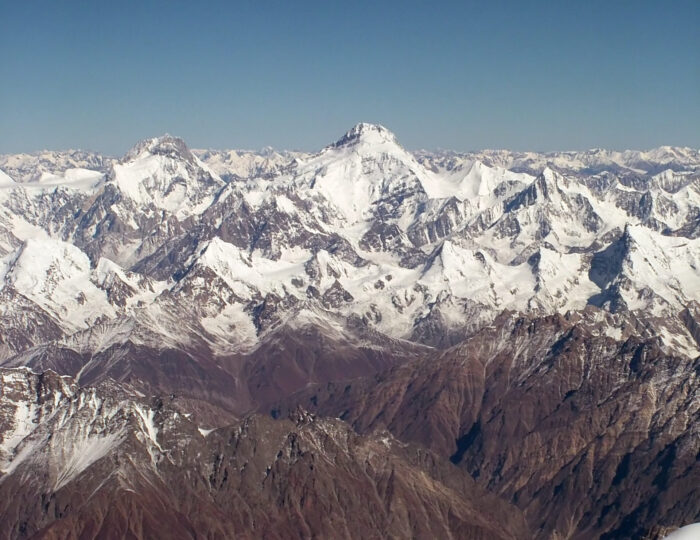
According to the British Alpine Club's Himalayan Index, Alejandro Arranz, Inaki Aldaya, Alfredo Zabalza, and Tomas Miguel of Spain made the third and latest ascent in 1986. Their descent was dramatic. They struggled down for two days in bad weather, and all suffered frostbite.
Earlier tensions between India and Pakistan continue to reverberate in parts of the Karakoram and have forced some climbers to change goals. While some teams dropped out at the last minute, others switched peaks when closed zones thwarted permit applications.
Piolet d'Or winner Elias Millerioux of France went to Pakistan three weeks ago, but when we asked him about his plans, he replied, "It's complicated."
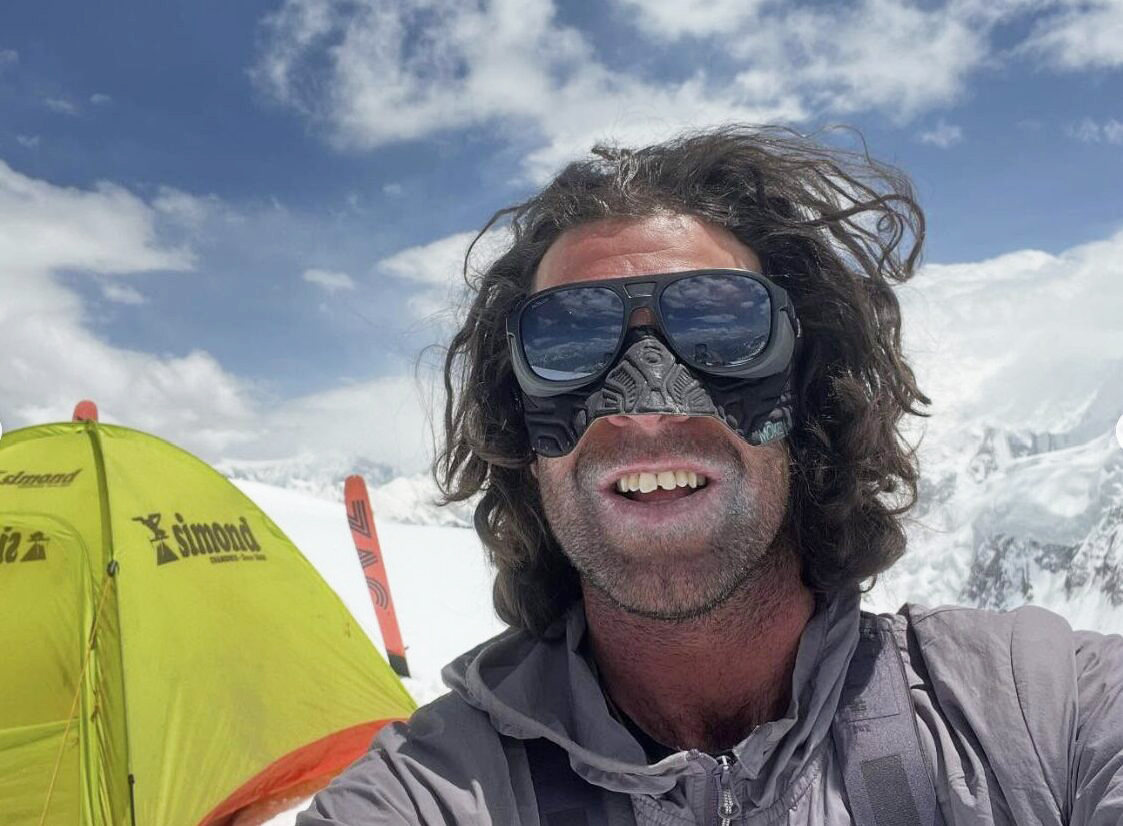
It turns out that Millerioux's partners dropped out just days before leaving, leaving the French climber at loose ends. He wandered alone up the Momhil Glacier, scouting peaks for future endeavors. He also spent some days teaching climbing to locals in Karimabad. Finally, Medhi Vidault and another unidentified partner came from France to join him in climbing and skiing some Karakoram 6,000'ers.
"We have no clear expectations but are just letting things flow," he wrote on social media. "Some expeditions are all about the unexpected."
On Monday, the team climbed 6,171m Ambareen Sar, which they dubbed "a little summit" compared to the 7,000m giants around it. Yet the peak has only been climbed twice before: by Austrians Robert Gruber, Kurt Lapuch, and Christine Schmid in 1987 and by Felix Berg and David Langanke of Germany in 2020.
India's permits restricted
In the Indian Himalaya, many mountain areas are closed, forcing teams to find alternative destinations. Last month, Vitaliy Musiyenko and Sean McLane of the U.S. were already in India when escalating tensions with Pakistan denied them a permit to climb Kishtwar Shivling. Instead, they picked an alternative on the go -- Chaukhamba I, which lay in an area they knew nothing about. Their expedition costs doubled, and the climbers found the mountains in this new area were in highly dangerous conditions.

"[There were] active seracs over avalanche-prone slopes, serious icefalls to cross, and wet slides that start soon after the sun's rays touched the slopes," Musiyenko reported.
They made two attempts on Chaukhamba. On the first try, high winds forced them to retreat. On the second, scorching heat made the route unclimbable.
"The ice we intended to climb was a mix of fractured ice, running waterfalls, and frequent rockfall/wet slides," Musiyenko noted. He also had a close call when he almost fell into a crevasse, which affected him.
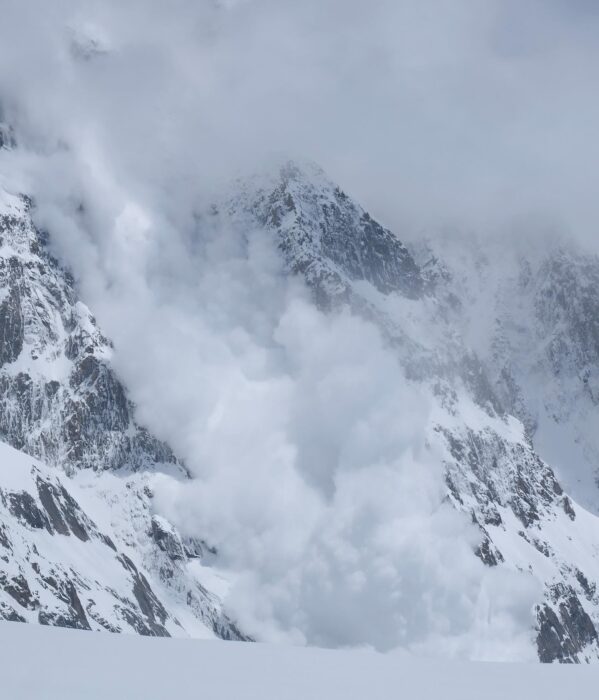
"It was difficult to bail...because the story we wanted out of this trip was one of overcoming adversity," Musoyenko wrote back at home. "However, you can’t push it too far; life is more important."
No more Rimo III
Musiyenko and McLane are not the only recipients of an American Alpine Club Cutting Edge grant who were forced to change plans. Michael Hutchins, Stefano Ragazzo and Piolet d’Or winner Chris Wright tried in vain to obtain permits for the 1,600m southwest face of Rimo III. The peak lies in the easternmost part of the Karakoram, within India. Fortunately, the climbers found a new goal, which they will tell us about in an exclusive interview later this week.
Some stick to plans
Not all alpine-style teams had to change plans. Some have already succeeded on their original goals, like the teams on Ultar Sar and Spantik. Others are currently climbing, like Urubko and Goettler's teams on Nanga Parbat. Still others are on their way to their destinations, such as the separate French and Italian teams targeting Gasherbrum IV.
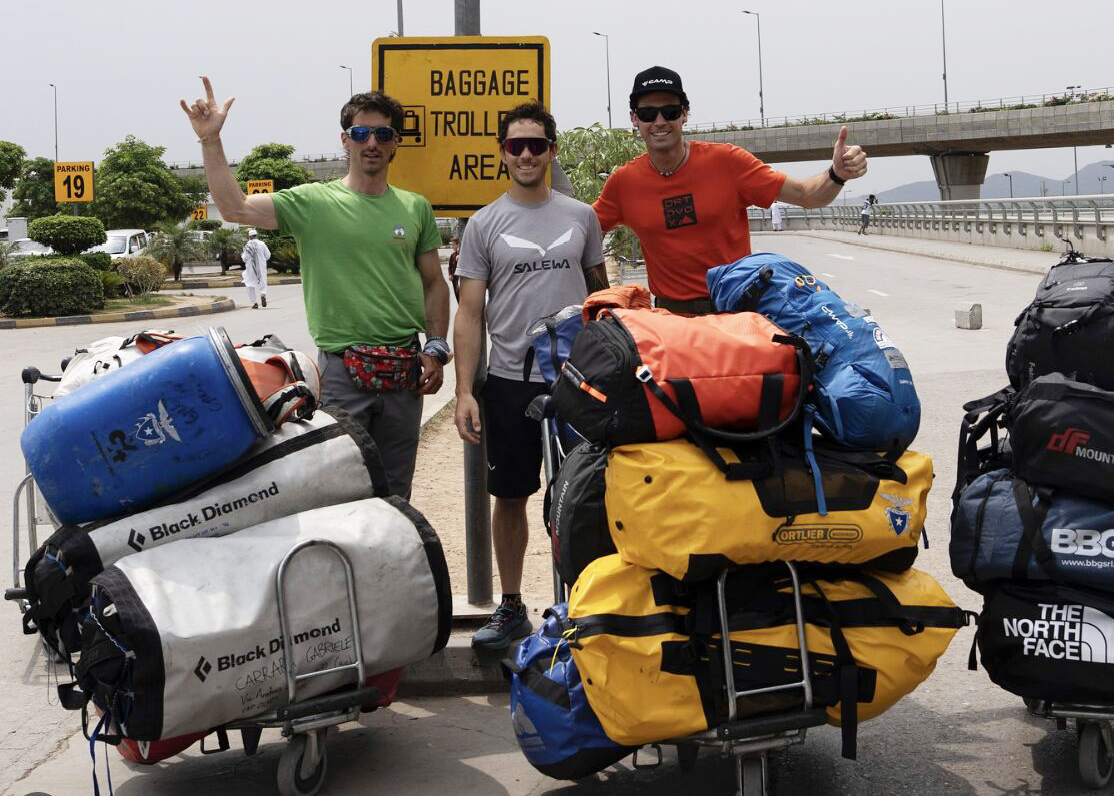
Climbers are making the best of the Alps during these longest days of the year: Leo Billon has opened a new and difficult route on the Aiguille du Plan, and Vivian Bruchez has finished his 15-year project to ski down all 84 of the 4,000m peaks in the Alpine Arch.
Long days, long climbs
June is an interesting month in the European Alps: long days and -- usually -- moderate temperatures are ideal for long rock routes. Meanwhile, diehard skiers still find enough snow on the glaciers and higher summits for some extreme descents. Often, these include rocky ridge climbs and long treks down to the valleys with the skis strapped to their packs.
Recently, the unstoppable Leo Billon has opened another new route in the Mont Blanc massif, this time with Enzo Oddo, a comrade from the French High-Mountain Military Group. The pair climbed a 700m route on the West Face of the Aiguille du Plan, above Chamonix. The new line follows the face's central spur, close to the Bonington/Tejada-Flores route from 1965. Billon and Oddo named the route OSS ne répond plus and suggest an overall difficulty of 7a+.
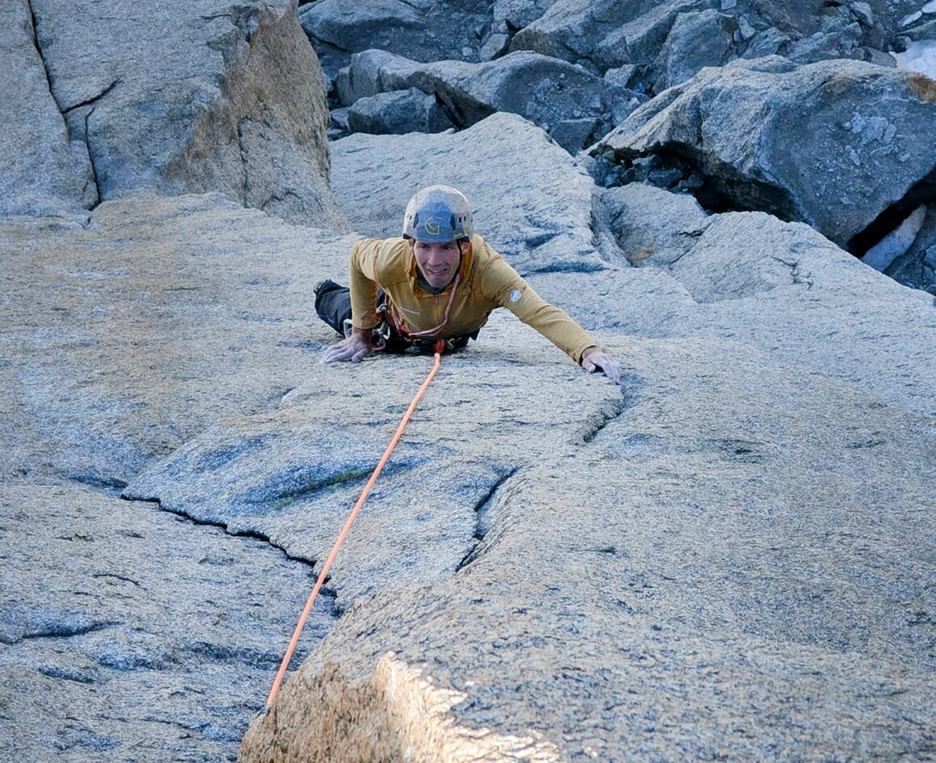
Wall of shadows
The climb is a positive ending to a tragic story. Billon was asked to climb the Bonington route (very close to the new line) in November 2019 with good friends Max Bonniot and Pierre Labbre, but he already had other plans. Sadly, Bonniot and Labbre fell to their deaths on the route.
"Since then, this mountain face [the West Face of Aiguille du Plan] has been for me a wall of shadows and vertigo, loaded with sadness, fear, and emptiness," Billon wrote. "[Now], with Enzo, we restored a little lightness, beauty, and positivity."
Bruchez finishes
Nearby on the Grandes Jorasses, Vivian Bruchez climbed 4,065m Point Marguerite and skied down, after downclimbing the unskiable summit ridge last Friday. This was the last summit of a 15-year project: to climb and ski all 82 of the 4,000m peaks in the Alps.
"I put all my heart, all my body, all my energy into this," he wrote afterward.
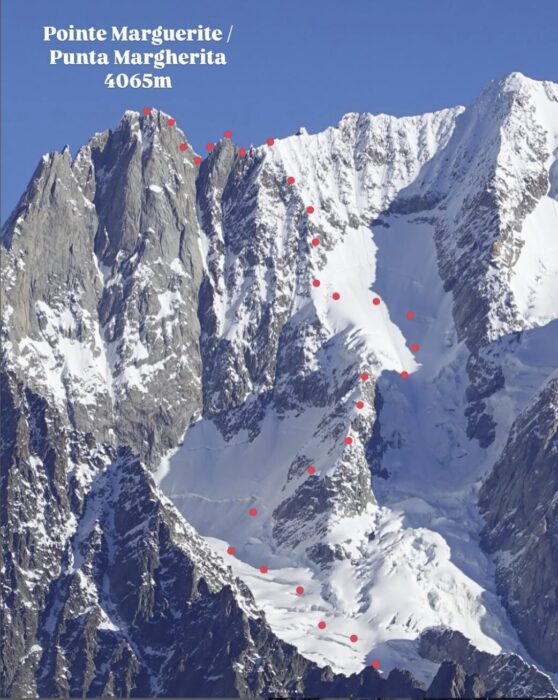
On the Grandes Jorasses, he teamed up with Mathieu Navillod.
"Given the verticality of this peak, we approached the mountain on skis and then climbed to the summit via the Italian side," he explained.
He admitted the snow conditions were far from perfect, but they used the skis as much as possible, as Bruchez has done throughout the project.

During the project's years, Bruchez has carved 22 new ski routes, including four on peaks that had never been skied before. He has also skied more than 100 lines. In June last year, he skied from Picco Luigi Amedeo on the Italian side of Mont Blanc with Gee Pierrel.
Bruchez said such a project had not been undertaken before, and admits the last two years were the hardest. He had injuries, and the remaining peaks were so difficult that he was unsure he'd succeed. For this, he credits his climbing partners. "What was once an individual project eventually became a collective one," he said.
Babicz returns
Heat wave
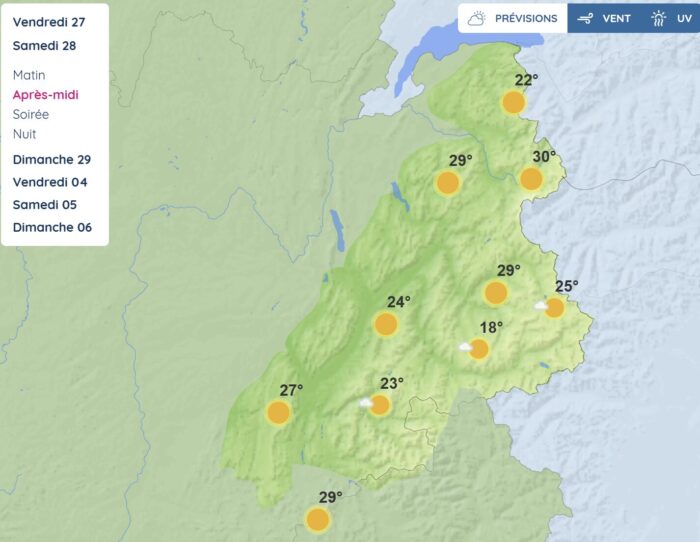
Climbers on Everest's North Side face constant winds hitting the Northeast Ridge. This makes the feat achieved by photographer Ma Chunlin of China the more remarkable. After years trying, this spring he filmed the entire route, from Advanced Base Camp (ABC) to summit, in a single, non-stop drone sequence.
Ma camped at ABC at 6,490m and waited for the right day. He needed climbers heading for the summit but also clear skies and calm winds, which were rare during the windy 2025 season. The shooting had to start precisely at sunrise, CGTN reported, and follow the exact route with no errors piloting the drone.
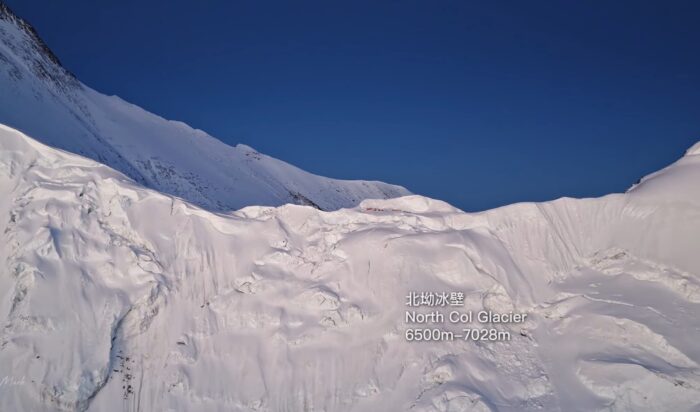
A five-year project
Ma Chunlin, born in 1995, specializes in high-altitude mountain photography and this project is the culmination of five years' work. He first filmed Everest's ascent route five years ago, but in several sequences that he later edited into one. (That was during COVID, but Chinese climbers were still on the mountain.)
Since then, he has dreamed of following the route in a single take, a feat he attempted in 2021 and 2024. On the latter occasion, his drone fell at 8,300m, but he learned an important lesson.
"I realized how important it is to have climbers in the images," Ma told People.cn. "Without them, there is no perspective, as the human scale is lost and the viewers cannot understand the difficulty and the size of the summit."
Ma and the Chinese media claim this is the first time that the entire route on Everest's North Side has been recorded in one take. In addition to the technical difficulties, the use of drones is strictly restricted on the Tibetan side of the mountain. It took a great deal of patience and effort for Ma to obtain permission.
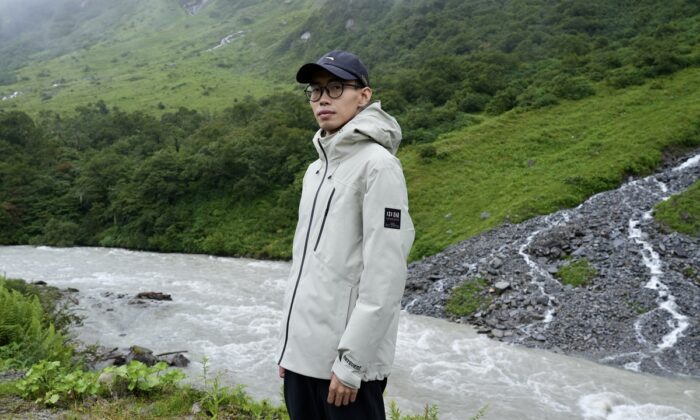
After his success, however, the Chinese authorities applauded the achievement. "Nothing is impossible," posted Mao Ning, spokesperson for China's Ministry of Foreign Affairs, on X.
The golden window
The single shot follows the normal route along the Northeast Ridge, from ABC to the North Col, Camp 2 on the ridge, and Camp 3 at the steep North Face. It continues filming the upper sections until the summit, with the three famous "steps" marked in the video.
Ma explained he had to start filming at Advance Base Camp to keep the drone in contact along the entire route. He also carefully chose the right day and time to start shooting: 6:55 am on May 19, to make the best of a 15-minute "golden window" at dawn, when the air was calm and the light was ideal.
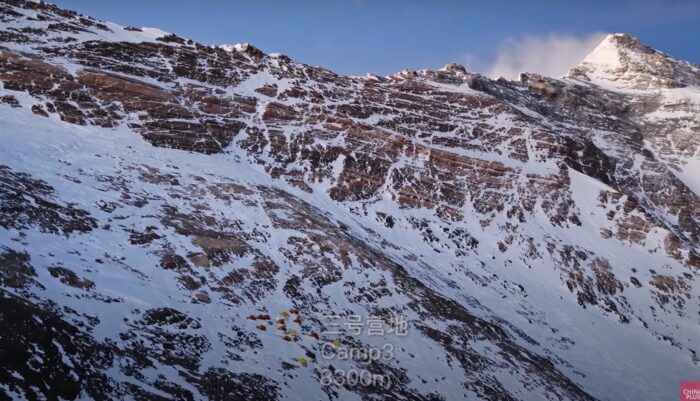
At the end of the video, a single climber can be seen standing on the summit, as small groups approach from both sides of the mountain.
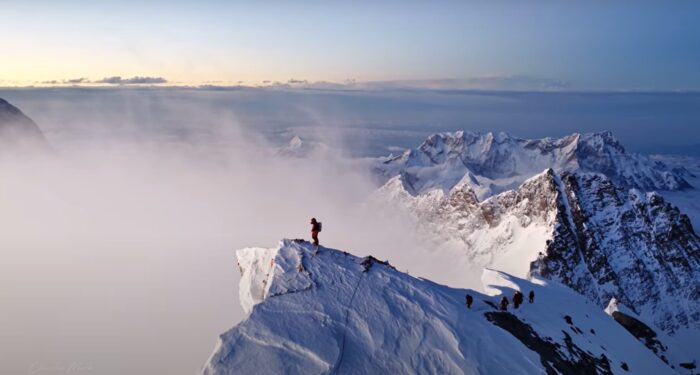
Ma chose the ideal day. May 19 saw a large number of summits, most of them from the South Side. Winds picked up later in the day, but the early-morning drone flight had finished by then.
Probably some of the climbers filmed on the summit area of the north side belonged to the Furtenbach Adventures team, whose members reported summit success at 5:40 am that day.
"The first part of the filming went on without problems, but I was holding my breath," Ma told People.cn.
At summit altitude, he lost connection with the drone and feared the worst. "Luckily, the return function on the drone activated automatically, and it made it back safely."
The result is a truly impressive video. Check it here:
There was a time when climbers revealed their plans publicly months in advance, to raise interest for fundraising or solicit beta from climbers who'd been to the area. We now live in more secretive times, where everyone worries that letting a good idea out of the bag prematurely may tempt other climbers to snatch it. So when Lucien Boucansaud of France recently detailed plans for a solo first ascent of Nepal's Khangri Shar this fall, we wondered...why.
"For me, announcing my plans and admitting how little I know about this mountain is like an open call to everyone in the climbing community to look for adventure, to try climbs we don't even know if they are possible," he told ExplorersWeb.
The soloist
We discovered Lucien Boucansaud when he soloed Pumori in the fall of 2023. Days earlier, Boucansaud had done an alpine-style ascent of the west face of Cho Polu with David Goettler and Guillaume Pierrel. He then used some free time in Nepal to hike up the Khumbu Valley and try Pumori. The aesthetic yet difficult peak rises immediately opposite Everest.
Boucansaud had no idea how far up he would get. But despite difficulties and exposed sections, he summited alone on Oct. 28.
While climbing Pumori, Boucansaud looked westward and noticed a peak nestled between Nepal and Tibet. It usually went unnoticed because Pumori cast a long shadow over it.
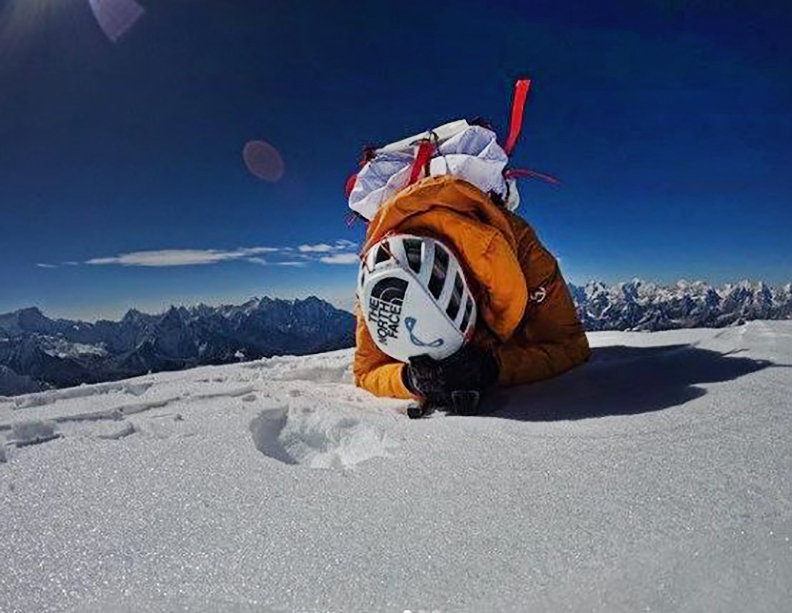
"At the end of that expedition, I met a team that had attempted the summit and told me about it," he said. "That peak remained in my mind since then, and now the moment has come. I'll try to solo in the same style and with the same attitude I had on Pumori."
Several attempts
According to The Himalayan Database, the peak has had several attempts, including some by commercial teams. A Japanese team made the first attempt in 2003. In 2004, an Adventure Peaks group from the UK, led by Tim Blakemore, also tried. The year 2018 featured two attempts, one by the late Noel Hanna of Northern Ireland and another by Luke Smithwick of the U.S. and Frederik Strang of Sweden. Adventure 14 organized a team for Delphine Reymond of Switzerland.
Last year, a South Korean team led by An Chi-Young attempted Khangri Shar. All attempts came from the Nepal side, all were unsuccessful, and all attributed their failure to bad conditions and objective hazards.
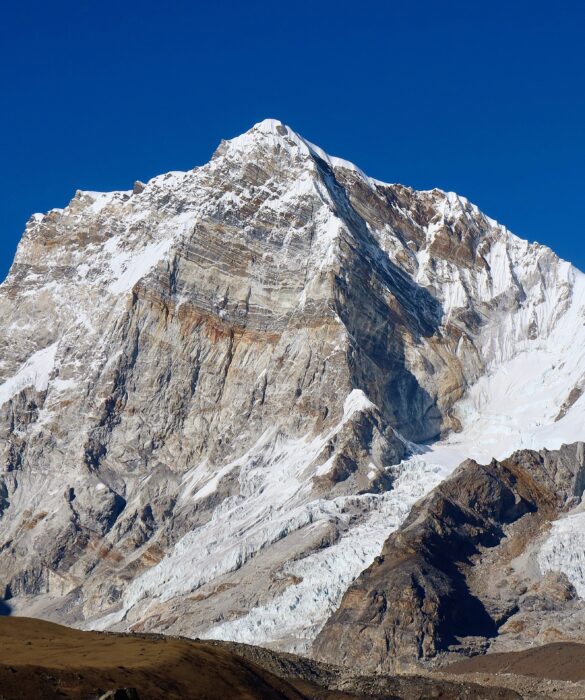
According to Nepal Himal Peak Profile, Khangri Shar is 6,811m, but The Himalayan Database identifies it as 6,792m. It also lists a 6,658m Khangri Shar West.
This fall, Boucansaud will make the first solo attempt, in pure alpine style. "To reach an untouched summit is an alpinist's dream," he said.
Asked whether he is concerned about other climbers stealing his idea, Boucansaud seemed surprised.
"I hope not," he said. "But, well, I guess that should be okay. Everyone has the right to climb the peak."
French climbers Charles Dubouloz and Symon Welfringer are teaming up again to attempt one of the most epic peaks in the Karakoram: Gasherbrum IV.
"Our primary objective is the southwest ridge, starting by climbing the Shining Wall [the West Face] and then continuing along the ridge to the summit," Dubouloz told ExplorersWeb. He noted that this is the route twice attempted by Piolet d'Or winner Jordi Corominas in 2006.
The West Face of Gasherbrum IV is called the Shining Wall because the setting sun lights it up spectacularly. It offers a formidable sight to climbers and trekkers as they reach the glacier crossroads known as Concordia, on their way to K2 Base Camp. The 2,500m-high face is one of the most aesthetic and difficult in the world. It was the scene of some epic chapters in the history of mountaineering.
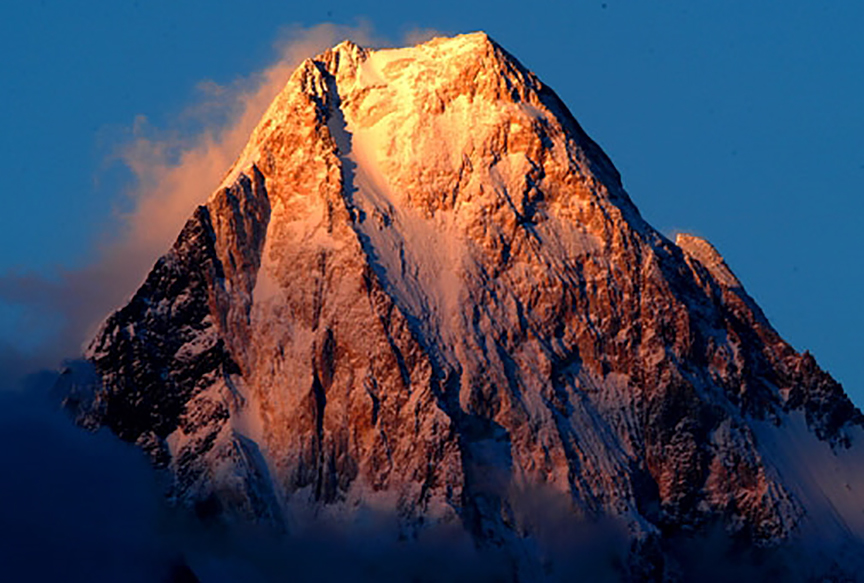
Given the changeable conditions in the Karakoram and the magnitude of the challenge, Dubouloz, 36, and Welfringer, 31, are hedging their bets. Once at the foot of the wall, they may consider other routes or, if it proves impossible, opt for an alternative goal.
"Other possibilities would be climbing Gasherbrum V [G5] or attempting a G5/G6 traverse," Dubouloz said. "Additionally, if the weather turns bad, we’re open to exploring the lesser-known 6,000m peaks around base camp."
These peaks could also serve as preparatory climbs.
Staying flexible
Adapting to conditions is one of the pair's assets. The last time they climbed together in the Himalaya was in the spring of 2024. On that occasion, they went to Nepal with 7,952m Gyachung Kang in mind. Then Welfringer got sick, and as they were running out of time, they ended up opening an excellent new alpine-style route up the vertiginous west face of neighboring 7,029m Hungchi.
“When you go on an expedition to the end of the world, things rarely happen as expected,” Dubouloz explained at the time.
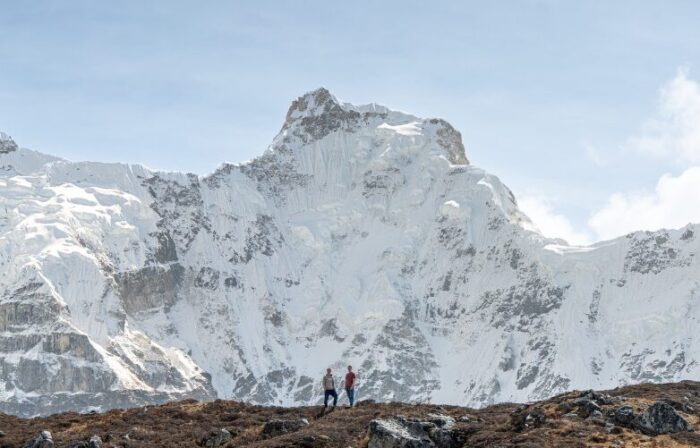
The climbers plan to keep the same flexibility this year.
A change of venue
The Gasherbrum massif will be a significant change for Welfringer after last summer, when he teamed up with Matteo Della Bordella, Silvan Schupbach, and Alex Gammeter on remote big walls in Eastern Greenland. The team achieved the first ascent of a 1,980m face.
Dubouloz is also restless after a busy winter climbing, skiing, and flying at home in the Chamonix area and across Europe and northern Africa. Year after year, his name appears linked to some of the best expeditions in the Himalaya and the Karakoram. He is a regular partner of fellow hard-core visionaries Benjamin Vedrines and Tom Livingstone -- and, of course, Symon Welfringer.
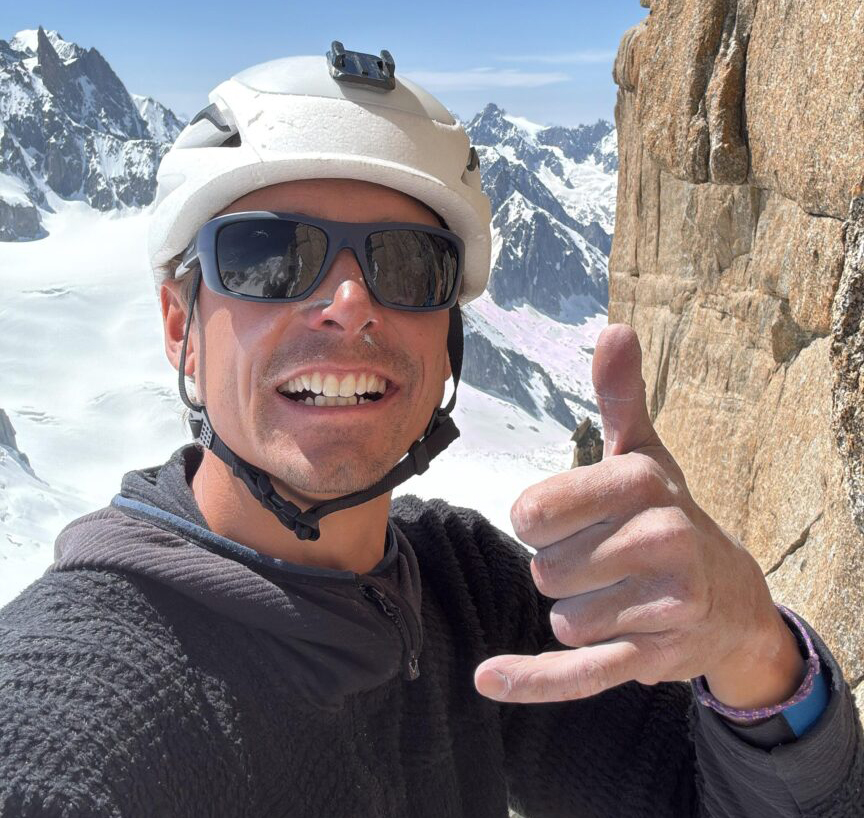
Benjamin Vedrines is setting new records in the old European Alps at a breakneck pace. Long-time partners sometimes join him on these speed projects. This time, Vedrines has climbed and skied down the four faces of Mont Blanc in 21 hours with Nicolas Jean.
With summer just around the corner and warm temperatures already impacting the snow conditions, the pair skied down steep ridges rather than slopes or valleys.
Why so remarkable
In addition to speed and endurance, their project is remarkable because of how late in the season they did it. Perennial snow may top Mont Blanc, but the surrounding valleys draining into France and Italy are already bare. Ski excursions are rare in the Alps by mid-June, and usually done only in high glacial areas, accessible by cable cars.
Needless to say, Vedrines and Jean started from the bottom of Chamonix Valley, at Les Houches, which is located at 1,010m. That is a long way from the 4,806m summit of Mont Blanc.
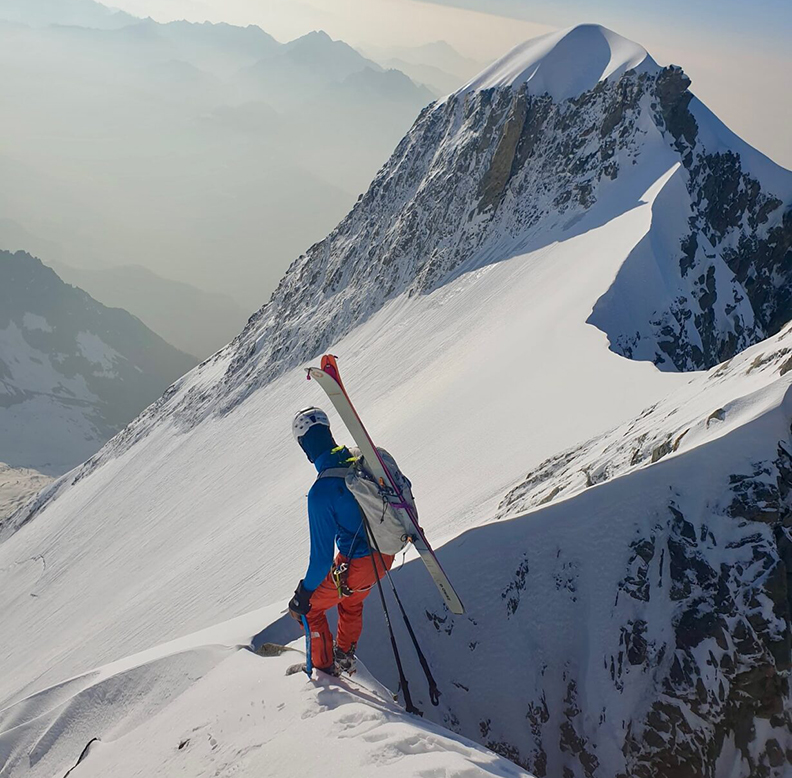
Vedrines and Jean could only skin up the last 300 vertical meters. They had to carry the skis on their backs almost all the way, which totaled nearly 8,000 vertical meters.
Moreover, in the summer temperatures, the snow conditions change so rapidly, whether skinning up or skiing down. As Nicolas Jean pointed out, they passed from hard-rock snow to total slush.
Dangerous seracs
One hazard was how unstable the seracs were in the heat of the day. The basic rule of summer alpinism says to begin very early, when temperatures are coolest, and stay away from glaciers during the day. But this pair had to spend the entire day among broken glaciers. Vedrines admits they had some scary moments while passing below the water-dripping seracs on Mont Blanc's East Face -- the Himalayan-like Brenva face on the Italian side. He mentions a "close call" but adds no further details. East faces are particularly tricky because they get the sun's rays beginning in the early morning.

Interestingly, the Brenva face of Mont Blanc saw some ski descents around this time last year, but 2024 featured a rather dry winter followed by loads of spring snow. This created exceptional conditions that lasted until summer. This year, that part of the Alps has had a slightly lower than average amount of snow.
Itinerary and routes
While the climbers have not yet released a complete report, they left from Les Houches at 10:30 pm and reached the fourth and last summit of Mont Blanc at 7:30 pm on the following day.
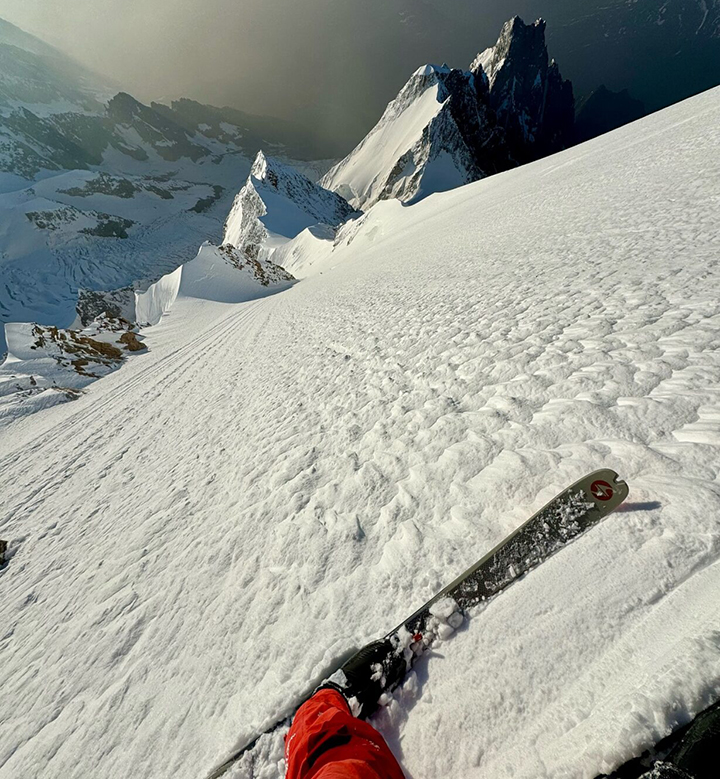
After the first summit, they skied down the highly technical Peuterey Ridge, combining it with the north face of the Aiguille Blanche de Peuterey, AlpineMag reported. They made their following ski descents down the Brenva spur (NE) and the west face by De Benedetti Peak. Finally, after their last summit of the day at 7:30 pm, the pair descended northwest down the Bosses Ridge (on the peak's normal route) and the north side of the Dome du Gouter, on their way back to Chamonix.
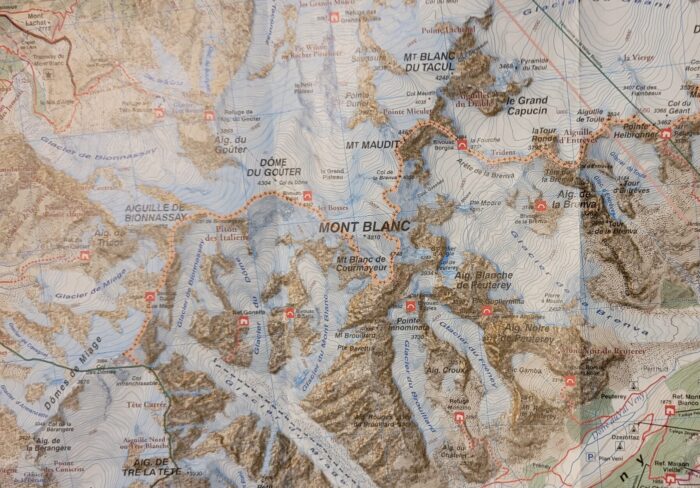
Nicolas Jean admits this was Vedrine's idea, and the out-of-season proposal was unexpected.
"After [Vedrine's] Mont Blanc record -- 4 hours, 54 minutes from Chamonix to the top and back -- he seemed ready to ease off a little," Jean explained. "[But] when the weather window opened, he asked me to join. I was thrilled, probably because my memory conveniently forgot how wrecked these projects leave me!"
Himalaya next?
Last year, Vedrines and Jean completed some similarly impressive activities in the Ecrins massif, skiing up and down the five faces of Les Agneaux. A week later, they chain-climbed and skied down the Ailefroide, the Pic Sans Nom, and Mont Pelvoux. At that time, Vedrines said he was training to climb K2 -- which he did, without oxygen or Sherpa support, in 11 hours -- the FKT. He then paraglided from the summit.
In fall, Vedrines, Jean, and their third regular partner, Leo Billon, attempted the north face of Jannu East.
This year, the French pair has not revealed their plans for summer and fall. However, with this kind of training, we can't wait to see what Vedrines and his friends will do next in the Himalaya.
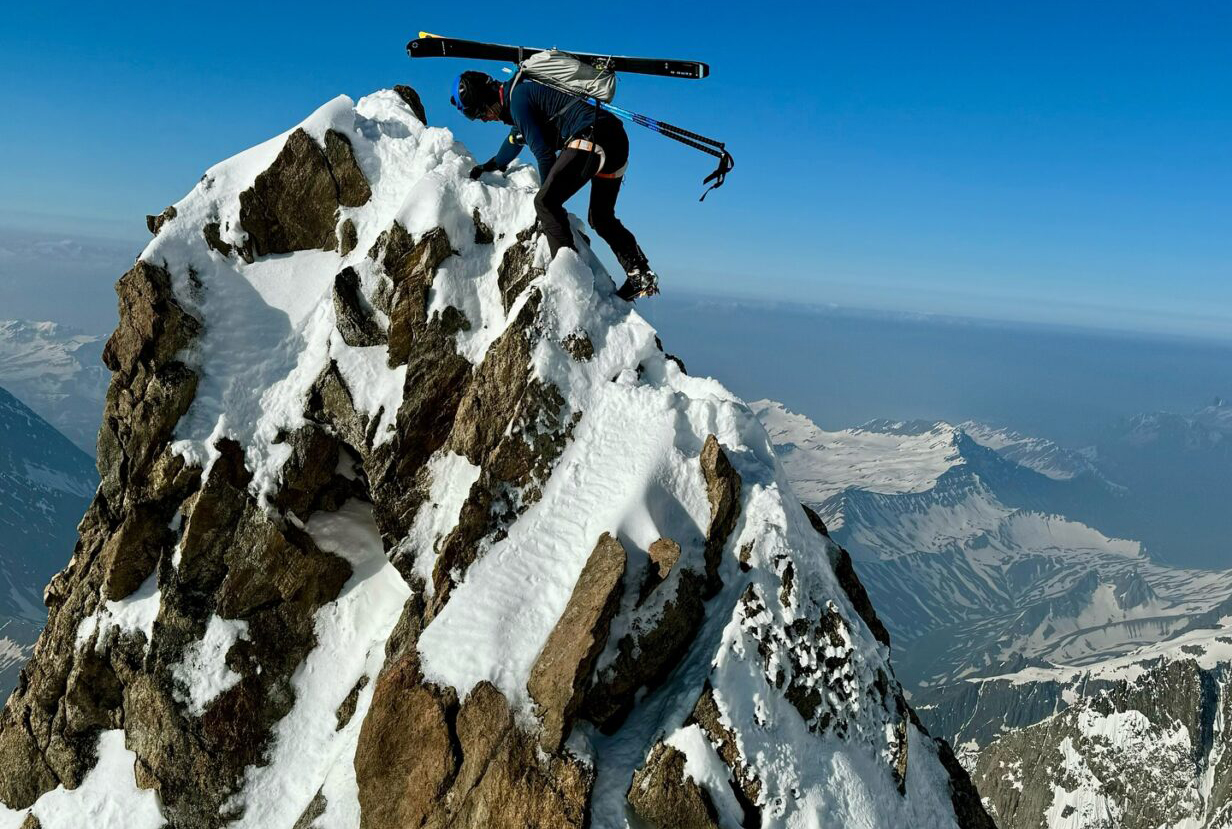
Pakistan climbs this year will range from attempts at a bold new route and the first ski descent of the Rupal Face of Nanga Parbat to ultra-commercial approaches. The climbing styles seem worlds apart, yet they reflect both how much the high-altitude scene has changed and how some climbers continue to tackle big mountains in the spirit of classical adventure.
Denis Urubko and Maria Cardell climbed their last acclimatization peak near Skardu today, June 11. They summited a 4,560m peak and climbed 4,000 vertical meters in a day. Now, they're moving to Nanga Parbat for their main goal: a new route up the Diamir Face.
The last climbers to attempt a new route on an 8,000m peak in Pakistan were Kazuya Hiraide and Kenro Nakajima. The Japanese pair targeted a new line on the West Face of K2 last summer, after years of preparation. The veteran pair had previously opened routes on Rakaposhi, Shispare, and Tirich Mir, winning Piolets d'Or for each of them.
In the end, they perished on K2. Before them, the last person to attempt a new route on one of Pakistan's five 8,000'ers was none other than Denis Urubko, when he tried Broad Peak in winter. The last success? None other than Urubko again, on Gasherbrum II.

Off the normal route
Not a first ascent but still impressive is the upcoming attempt by David Goettler, Typhaine Duperier, and Boris Langenstein to climb the 4,600m-high Rupal Face of Nanga Parbat. This is Goettler's fifth attempt on the Rupal Face, as he explained to ExplorersWeb earlier this week. If possible, he will paraglide from the summit, while Duperier and Langenstein want to ski down. The team flew to Skardu today.

Independent climbers
Horia Colibasanu of Romania is trying to carve out some independent space on the increasingly commercialized mountains, as he pursues the 14x8,000'ers in his own style. He uses the Base Camp logistics of the big commercial teams and sticks to the normal routes fixed by Sherpa and Balti climbers. However, he uses no supplementary oxygen, carries his own gear, and climbs on his own and at his own pace.
Today, Colibasanu is on the road to Base Camp and sharing the bus ride with Jorge Egocheaga of Spain. Although he has not shared his plans for Nanga Parbat, he always climbs in a similar style. They should reach Base Camp this week.
Inaki's path
Colibasanu and Egocheaga won't be exploring new ways to climb an 8,000m peak. Both have been climbing this way since they first set foot in the Himalaya 20 years ago. Early in the 21st century, independent climbers from all over the world shared a collective climbing permit. Once in Base Camp, they coordinated informally with other climbers to work on the mountains, fix ropes when needed, and break trail to the summit.
At the time, Sherpa staff were rare beyond Base Camp, and oxygen was mostly used only in emergencies. One of the best-known climbers of that age was the charismatic Inaki Ochoa de Olza of Spain, a regular partner of both Colibasanu and Egocheaga until his death on Annapurna in 2008.

There were a few commercial expeditions in the Karakoram even then. They offered Base Camp crews and guides, but the help in these wild mountains of Pakistan was minimal compared to the fully serviced ventures of recent years.
Nanga's first commercial team
Ralf Dujmovits of Germany led the first commercial expedition to Nanga Parbat in 2001 with his former company, Amical Alpin. It had 13 clients, Hajo Netzer as a second guide, and high-altitude porters Qudrat Ali and Emrodin from Shimshal.
"Qudrat and Emrodin carried part of the group equipment, and the clients and guides carried some...Each carried his own personal equipment...Several of the clients helped to fix ropes and break trail," Dujmovits said in a recent post on social media.
"None of us used oxygen...There was a single bottle of oxygen at each camp for emergencies only," Dujmovits recalled. Nine clients, the two porters, and the two guides summited together during the seven-week expedition.
2025: Purja and Harila's way
Seven weeks for one expedition. Meanwhile, nine weeks is the time that Kathmandu-based 14 Peaks Expeditions considers necessary for clients to summit all five of Pakistan's 8,000m peaks.
The outfitter's plan is to follow the style of Nirmal Purja and Kristin Harila -- use large, oxygen-loaded Sherpa crews to fix the routes well in advance, even in tough conditions. Then the clients use helicopters to hurry from one peak to the next, assisted by further Sherpa guides every step of the way.
In this fashion, Purja and Harila completed the 14 8,000m peaks in record time. In 2023-24, 14 Peaks CEO Tashi Sherpa used this approach with his own son, 18-year-old Nima Rinji Sherpa, who was trying to become the youngest to summit the 8,000m peaks. He succeeded.
It remains to be seen whether any client can keep that crazy pace, and whether the Karakoram's typically unstable weather will cooperate. In addition, helicopters are not as easy to hire in Pakistan as they are in Nepal. The service is extremely pricey -- about $20,000 per flight last year -- and is exclusively managed by the military.
Finally, it remains to be seen how far the expedition leaders will stretch the threshold of risk for both their clients and their staff in order to meet such ambitious deadlines.
David Goettler is on his way to Nanga Parbat with French skiers Tiphaine Duperier and Boris Langenstein. The 43-year-old German is tackling Nanga Parbat for the third spring-summer in a row and his fifth time overall. This week, he spoke to ExplorersWeb about his plans and the changing world of Himalayan climbing.
Last year, Goettler teamed up with Mike Arnold of the U.S., but Arnold decided to abort his attempt. Goettler spontaneously joined with Duperier and Langenstein, who were attempting to ski the mighty Rupal Face. The three launched a single, alpine-style push but didn't succeed.

Twelve months later, Goettler, Duperier, and Langenstein are back to attempt the hardest side of the mountain again. Duperier and Langenstein are world-class alpinists and skiers who are familiar with Nanga Parbat. In 2019, Duperier reached 7,800m while Langenstein summited. He then started skiing down from 50m below the top, the first point at which skiing was possible.
Duperier joined him at 7,800m as he descended, and they skied down the rest of the way together. The pair also skied Laila Peak in 2018 and Gasherbrum II's South Spur in 2021.
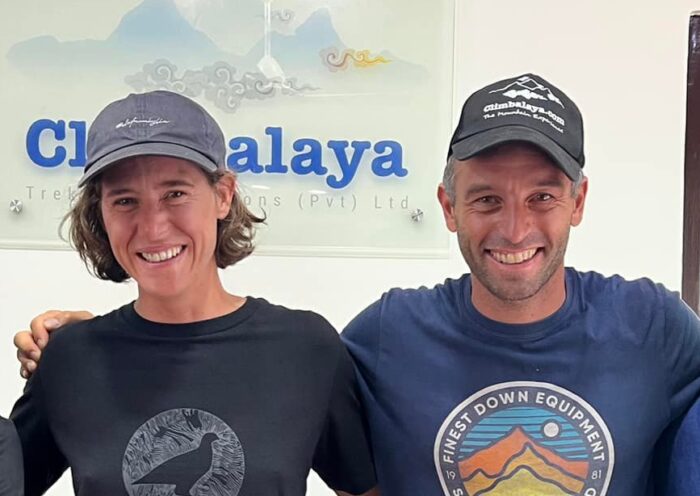
Baruntse
The three climbers began their preparations in late spring in Nepal, climbing in Langtang, then on Island Peak. Their prep culminated last week with an after-season ascent of Baruntse in the Khumbu.
"We were just days after the Everest climbers had finished, and the Khumbu was completely empty," said Goettler. "We had such a good time. Climbers complain about the crowding but then insist on climbing only in April and May. We need to spread out the season differently."
Goettler also praised winter as an interesting time to climb lesser peaks in Nepal. "Trekking peaks can be climbed all winter long with good equipment," he said. "During the day, it's often sunny and nice, and you'll have the mountains to yourself."
On Baruntse, they indeed had the peak to themselves, and in fact, theirs were the only summits this year. Conditions were good in base camp, but as the trio set off toward the top from their high camp at 6,400m, they were enveloped in a whiteout. They had to use their GPS devices to ascertain the highest point on the ridge.
The thick fog also thwarted Duperier and Langenstein's plan to ski down, while Goettler had hoped to paraglide down to Base Camp the fast way. On the positive side, the wind was not too strong, unlike most of this climbing season.

Changing conditions
The German noted how the mountain is becoming harder to climb because of climate change.
"The ice is getting more and more tricky, there are two big crevasses that are opening up and getting more difficult to navigate around," he said.
He explained that at a certain point, they had to rappel down and then climb up the other side of a crevasse. They had a 60m rope with them, but commercial teams would need to install ladders across it.
"The conditions on 6,000'ers and 7,000'ers are changing fast because of global warming," said Goettler. "Island Peak, for instance, is now bare of ice on the upper sections, and rockfall is frequent. It can still be done, but climbers need to know that in advance and not underestimate the climb."
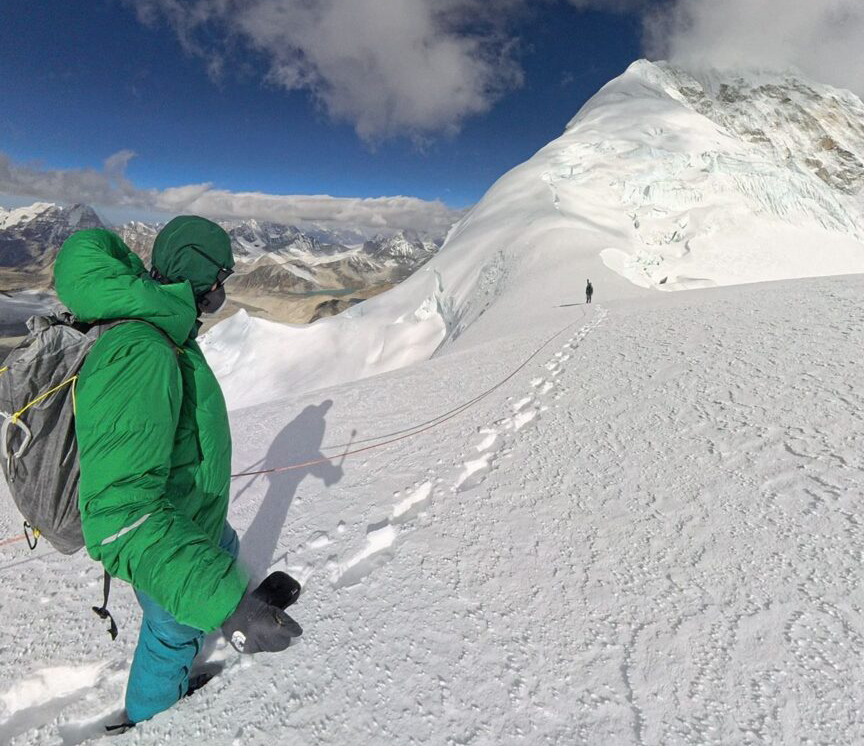
Different times
David Goettler visited Nepal for the first time in 2003 and has returned at least once a year ever since. He has seen both the country and the climbing scene change during that time.

Goettler climbed with some of the best-known high-altitude climbers of the early 21st century, from Gerlinde Kaltenbrunner and Ralf Dujmovits to Ueli Steck and Simone Moro. He has seen the evolution from small teams to the crowds on Everest. And yet, he climbed Everest without oxygen or Sherpa support in 2022.
"The commercial side of the 8,000'ers has exploded in the last decade, but this is a development that we saw in the Alps years ago and now we see in the Himalaya," he said.
Oxygen is not alpinism
"The issue is that we -- meaning both wide audiences and seasoned climbers -- still confuse the concepts of alpinism and commercial ascents. They are completely separate activities."

Goettler adds:
I have no problem with people climbing Everest in five days with all the help they can get, but their motivations to climb that mountain are totally different from mine. What these express teams are doing cannot be considered an evolution of alpinism but an evolution of a touristic activity that takes place in the mountains.
They have a right to be there, as long as they respect the environment, the local communities, and the safety criteria. People also climb Mont Blanc in the Alps [with a boost from] cable cars, which are even more invasive than helicopters. In some aspects, we should learn from the mistakes we made at home.
The German climber has a similar view about the Xenon therapy used by the British team that climbed Everest in five days.
"For me, Xenon wouldn't be an option because I consider it an external aid, like oxygen, and I do not use oxygen when I climb at altitude. However, there is no big difference between using Xenon and using oxygen, which can be set to flow at up to eight liters per minute," said Goettler. "I don't understand why some are outraged about Xenon but consider using oxygen the most natural thing."
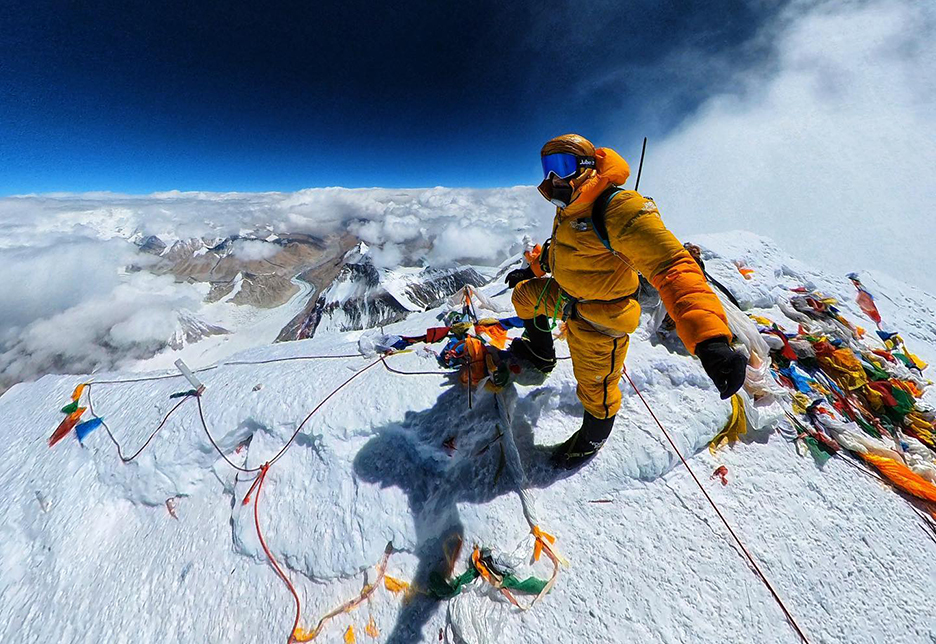
Longing for freedom
In recent times, alpine-style teams seem to focus on lonely peaks less than 8,000m high but which offer isolated locations and options for new routes. Meanwhile, on the 8,000'ers, almost everyone sticks to the normal route. Can guided teams and alpinists coexist on these highest peaks?
Goettler believes they can, but he is concerned about an excess of regulations, such as the ones in Nepal that begin this fall, which practically ban independent climbers.
The concern is we might end up with hyper-regulated expeditions as in Tibet, when you can't just obtain a permit to climb anywhere beyond the normal route or to climb Everest without oxygen. I wish so much to go to Cho Oyu, where there are options to climb new routes from Tibet, or Shisha Pangma, where I retreated some meters below the summit on the South Face! I hope Nepal will not go the same way.
I am happy I had the chance to experience the Himalaya when there were not so many regulations and not so many people.
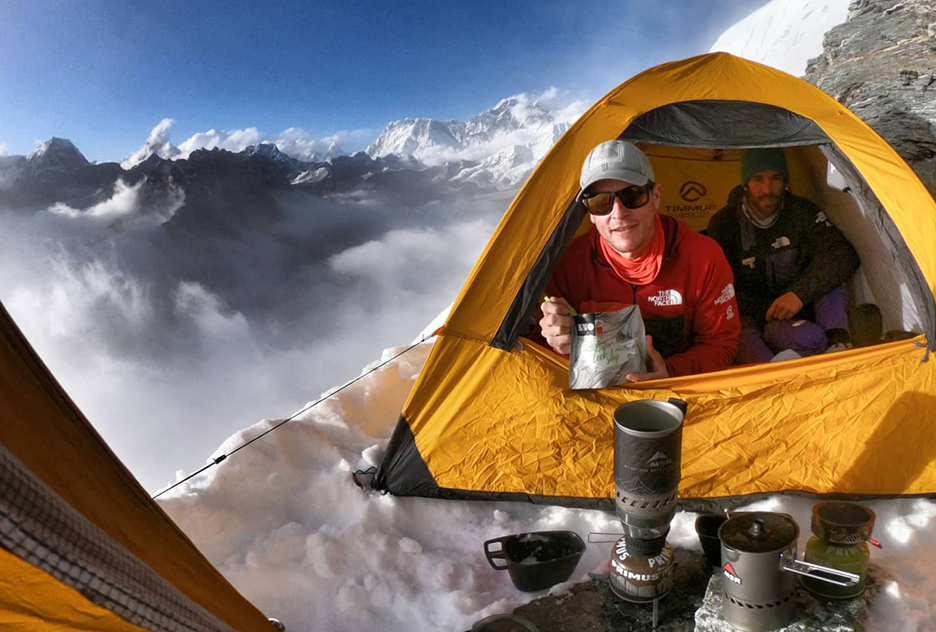
Goettler also believes that there is potential for new routes on the 8,000'ers, but that sometimes, bureaucracy stands in the way. "As I said, Cho Oyu offers options, but getting a permit now would be much more difficult than the climb itself."
He adds that other 8,000'ers still offer "some crazy-difficult faces that I would never attempt."
The risk debate
In this modern era, Himalayan alpinists are not unanimously admired for their purity of spirit. They sometimes receive criticism for the risk their activity involves. Guide and outfitter Lukas Furtenbach recently compared alpinists to modern gladiators ready to die, and who “eschew safety margins and embrace high personal risk.”
Responds Goettler, a professional mountain guide who has climbed since he was seven years old: "I assure you, I consider what I do very far from suicidal, especially if you bear in mind the huge number of times I have turned around on expeditions. Of course, commercial expeditions must prioritize safety, which is exactly what I do when I am guiding clients, but also when I climb on my own. My own climbing projects might look risky from the outside, but I am very conscious of conditions during every moment of the climb, the equipment I use, my skills, and how to keep within acceptable margins of safety."

Goettler says he has acquired experience and skills in small steps over the years.
"This may not be the norm now, when fewer people are ready to invest time to learn and evolve as climbers," he says. "Instead, they take shortcuts to the summit, by taking oxygen, a guide, etc. Again, I don't judge such choices, and it works for some people, who climb the 14x8,000'ers during their first two years in the mountains. But that does not mean they are capable of making any decision on their own up there. That only comes through knowledge and experience."
Climb up, fly down
Goettler tries to paraglide from his summits. He points out that while ascents are regulated, flights in Nepal are allowed on nearly every mountain. This makes it possible to avoid dangerous descents and even makes new routes safer.
"If conditions permit, flying down from the summit is the safest way I can think of descending a mountain," he said.
Paragliding from summits after fast and light climbs has become a trend among elite climbers, especially in Europe. Last year, Benjamin Vedrines sped up K2, then paraglided down from the summit, doing the round trip in 11 hours. Others on his team also flew from the top that day.
Back to Nanga Parbat
Goettler considers Nanga Parbat a special peak, quite different from Everest on the 8,000m spectrum.
This will be Goettler's fifth attempt on Nanga Parbat via the Schell route on the sheer Rupal Face. He has tried twice in winter, first in 2013-14 and then in 2021-22 with Herve Barmasse and Mike Arnold. He attempted it again with Benjamin Vedrines in 2023 and with Mike Arnold last year.
In addition to being one of the biggest mountain faces in the world (it's nearly 4,600m from base to summit), the Rupal Face of Nanga Parbat can be especially dangerous in mild temperatures. That is one of the reasons Goettler attempted it in winter. However, he believes conditions may remain good for a few more weeks.
"The route is risky in summer since a lot of rocks are falling on the lower part, but the last two years, I went there in June, and conditions were okay."
Their plan is to climb the mountain alpine style. If all goes well, he will fly back down to Base Camp, although he admits that the chances for that will be "very slim." His partners will ski.
Goettler, Duperier, and Langenstein move to Nanga Parbat this week, and we may not hear from them in a while. We will update when we do.
Those climbers who didn't cancel their plans when the hostilities erupted between India and Pakistan, or those who made their minds at the last minute, are on their way to Nanga Parbat. Many are seeking to complete their 14x8,000m lists. Others have already done so but are returning to the so-called Killer Mountain.
No-oxygen climbers
Less crowds in key sections as the Kinshoffer Wall will be positive for those attempting the mountain independently, such as Horia Colibasanu of Romania. As usual, he will climb without porters or supplemental oxygen.
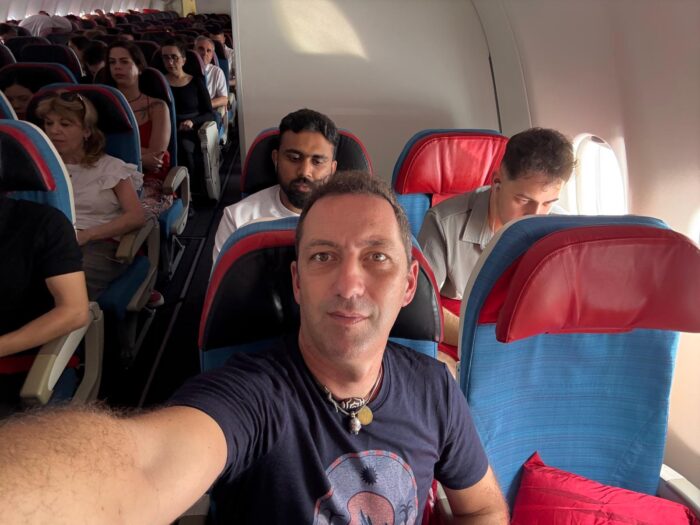
Ashraf Sadpara of Pakistan also plans to climb Nanga Parbat without supplementary oxygen, as he previously did on K2, Broad Peak, and the two Gasherbrums. He is the son of Ali Raza, one of the best-known and admired climbers in Pakistan. As one of the country's first climbing instructors, Ali Raza became the mentor for a whole generation. He perished in a rock-climbing accident in 2022.
Alpymon blog reports that Marie Saame of Estonia is on her way to Nanga Parbat as well. She intends to climb the 14x8,000'ers without oxygen, porters, or personal guides. She has previously climbed Gasherbrum II, Broad Peak, and Manaslu. Saame also attempted Annapurna this spring but couldn't summit for health reasons. She is also a professional violinist specializing in the music of the Middle Ages and the Renaissance.
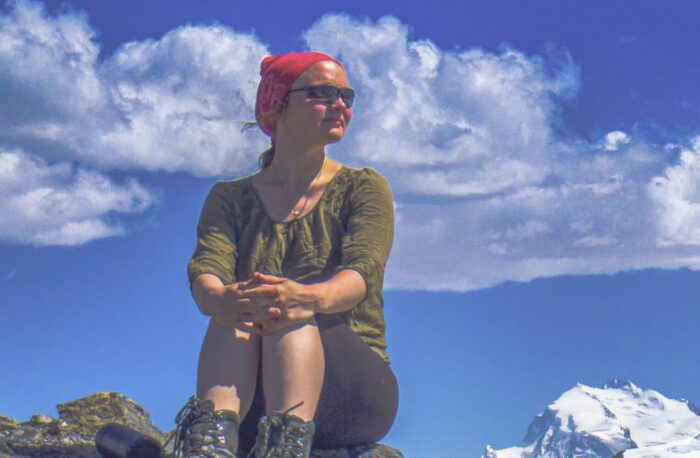
One more time on Nanga
Also in place is 14x8,000'ers summiter Jorge Egocheaga of Spain. Egocheaga claimed to have summited the 14x8,000'ers without supplemental O2 years ago, but his K2 climb was disputed and not accepted by 8,000ers.com. The site also concluded that Egocheaga had not reached the true summits of Manaslu and Annapurna.
Usually quiet about his plans, Egocheaga returned to the Himalaya a couple of years ago to "correct" his resumé, climbing all three peaks. The last of these was Annapurna, which he summited on May 17 this year. Nowadays, he climbs with Seven Summit Treks. As a medical doctor by profession, he often attends to sick climbers in Base Camp.
Dorota Rasinska-Samocko is also about to reach the Base Camp of Nanga Parbat. Last year on Shisha Pangma, she became the first Polish woman to complete the 14x8,000'ers.
Jay Whiting of the UK and Dawa Tenji Sherpa completed this Triple Crown this spring. It made Whiting only the second Briton to complete it in one season, after guide Kenton Cool, and the fourth person overall. At 33, he is also the youngest. But most remarkably, the guy in front of him, Dawa Tenji Sherpa, has now done it twice.
PART I: CONTEXT
Sharp and technical
Nuptse is sharp, technical, unforgiving, and dangerous if conditions are not right. At 7,861m, it is an almost-8,000'er. Consider: Until the end of 2024, a total of 12,884 people had summited Everest, including 9,156 from the Nepalese side. Only 38 had summited Nuptse, according to The Himalayan Database.
Since Denis Davis and Tashi Sherpa first stood on Nuptse's summit in 1961, it has attracted some of the best high-altitude climbers in the world. There have been epic, alpine-style ascents on new routes, from Doug Scott and Al Rouse's on the North Face in 1979 -- only the second ascent -- to Ueli Steck's ill-fated last solo in 2017.
Then, there are the Piolet d'Or-winning lines: the South Face by France's Helias Millerioux, Frederic Degoulet, and Ben Guigonnet in 2017, or Valery Babanov and Yuri Koshelenko's climb via the Southwest Buttress to the slightly lower East summit in 2004.
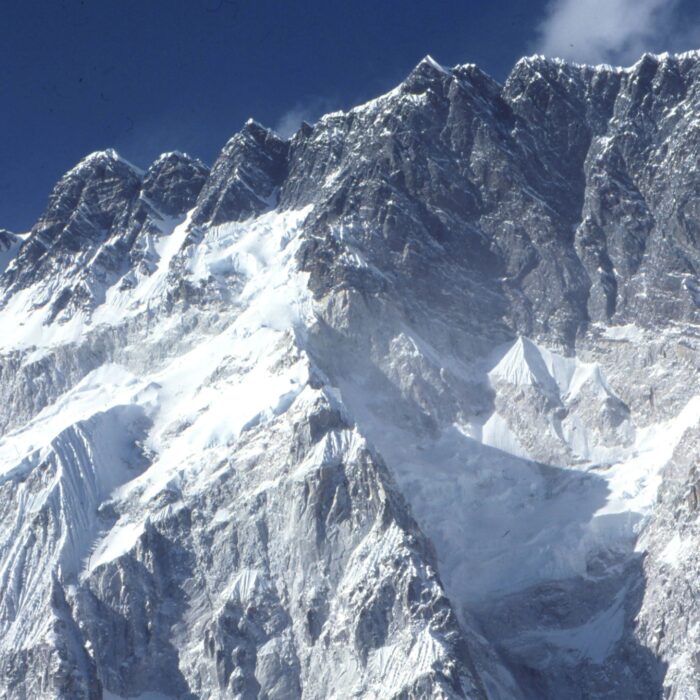
Other meritable climbs ended unsuccessfully. The mountain defeated Tomaz Humar (whose partner, Janez Jeglic, was blown off the mountain to his death), and the strong team of Steve House, Barry Blanchard, Steven Koch, and Marko Prezelj.
Until recently, the peak was climbed without supplemental oxygen. The North Ridge, accessed from the Camp 2 common to Everest and Lhotse, was hardly a typical "normal" route. Success only seemed within reach of such excellent climbers as David Goettler, Gerlinde Kaltenbrunner, the Benegas Brothers, Alex Txikon, Ralf Dujmovits, Kenton Cool, and Pete Athans.
Outfitters ignore Nuptse
Since the beginning of commercial expeditions in the 1990s, outfitters usually ignored Nuptse for practical reasons. It was too hard, and it lacked the commercial appeal of an 8,000m peak.
The idea of a Triple Crown was unknown. Climbing Everest, Lhotse, and Nuptse was a lifetime goal, not a seasonal one. The first to climb all three was Ralf Dujmovits of Germany, who summited Everest in 1992, Nuptse in 1996, and Lhotse in 2009.
In the spring of 2013, guide Kenton Cool climbed all three in the same season for the first time. His Nuptse summit was controversial for a while because Alex Txikon of Spain, who was with him, initially believed that they had not reached the highest point.
While others on the team stopped at a point they thought was the top, Cool and Txikon continued along the knife-edged summit ridge. Txikon thought they went up as far as possible, but that there remained some 150m to go.
However, Txikon changed his mind years later, as he told ExplorersWeb in 2022. After we posted that story, Txikon discussed the matter with Cool and with Billi Bierling of The Himalayan Database, and cleared up the facts. Both Cool and Txikon now appear in The Himalayan Database as Nuptse summiters. Both did their climb without oxygen.
The final ridge
When asked about it, Jay Whiting explained that the true summit of Nuptse can be confusing but can be identified if enough summit pictures are provided. He supports the validity of Alex Txikon and Kenton Cool's summit.
Whiting explained that some people may stop at a small shoulder on the summit ridge, photo below, but the true summit is well beyond.

"The final traverse is on a knife-edged, corniced ridge," he explained. Whiting was able to record part of the (terrifying!) traverse while holding the ropes and using his cell phone on a selfie stick at the same time:
Whiting believes that despite the 38 official ascents, only a handful of climbers have reached the true summit of Nuptse. Many others, he believes, stopped a little short.
Fixed ropes and oxygen
After a few failed attempts, the first fully guided team to succeed on Nuptse was led by Garrett Madison of the U.S. just two years ago. All clients used bottled oxygen, and a Sherpa team fixed the route. Madison and two clients, supported by five Sherpas, reached the top on May 8, 2023. Garrett Madison and one of the rope-fixers, Dawa Tenji Sherpa, also summited Everest and Lhotse that same spring, thus completing the Triple Crown.
At the beginning of 2025, only Madison, Dawa Tenji Sherpa, and Kenton Cool had completed this Triple Crown. Then came Jay Whiting, a 33-year-old British solicitor. He was not a professional climber or an athlete. Coincidentally, Kenton Cool was at Everest Base Camp and discussed the challenge with Whiting.
Whiting was on his second try to climb Nuptse after a failed attempt in 2022. This time, he knew the right man to rope up with: Dawa Tenji Sherpa. Together, they summited Nuptse on May 12, Lhotse on May 20, and Everest on May 23.
PART II: THE 2025 TRIPLE CROWN
Dawa Tenji's last Nuptse
That day, Whiting became the second Briton and the fourth person to complete this so-called Triple Crown. Meanwhile, Dawa Tenji Sherpa had now done it twice. He is also the only climber to have summited Nuptse three times.
"Tenji [Sherpa] is the man that everyone turns to for fixing the route on Nuptse," Whiting told ExplorersWeb. Among his other advantages, Dawa Tenji Sherpa knows exactly where the true summit is.
"Nuptse is considered one of the most technical climbs in the region, and I feel truly honored to have summited it three times," Dawa Tenji Sherpa said. It seems, however, that three is more than enough for him.
"I am thinking I won't guide on Nuptse again," Dawa Tenji Sherpa told ExplorersWeb.
He won't have problems getting other work. In the last decade, besides his three Nuptse summits, Dawa Tenji has summited Everest four times and Lhotse three times. He has also reached the top of K2, Cho Oyu (twice), Dhaulagiri, and Ama Dablam. He has formal training in advanced mountaineering, high-mountain rescue and first aid, helicopter marshaling, and rock climbing. And he is just 30 years old.
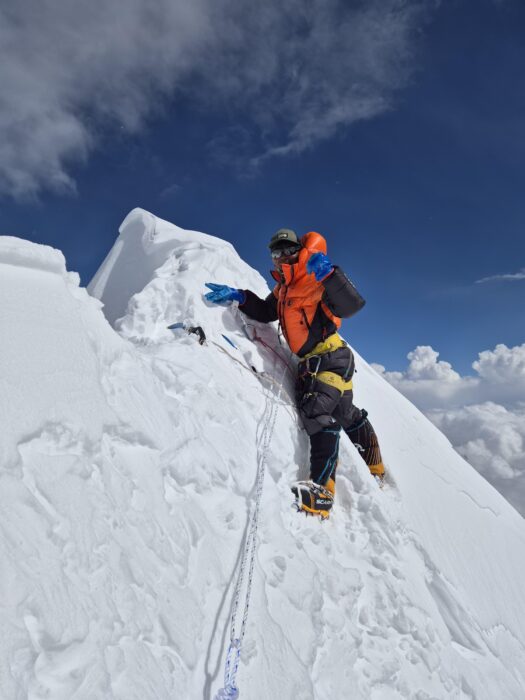
Dawa Tenji Sherpa works for Himalayan Guides. We asked the Nepal-based outfitter whether Nuptse is an option for commercial teams.
"While Nuptse is a more technical peak, we are open to organizing guided ascents under suitable conditions, as long as we have a minimum of four clients," director Iswari Paudel told ExplorersWeb. "However, we prefer not to take the risk just for a single client, because a minimum of five technically experienced fixing staff is required for a safe and successful climb, unless that single client can afford the [entire] cost."
Strategy
Nuptse, Lhotse, and Everest form a single massif, but they provide very different climbing experiences. While the first two host hundreds of climbers, Nuptse is lonely and hostile.
"Nuptse, in particular, is often underestimated," said Dawa Tenji. "[It] is technically far more difficult, the route is steep, exposed, and demands precision on mixed terrain — rock, snow, and ice. The weather can be very unpredictable, and the summit ridge is sharp and dangerous."
Despite its difficulty, it is often planned as the first goal of the season. It requires a devoted Sherpa team, who can start fixing the route as soon as the passage through the Khumbu Icefall is open and Camp 2 (common to all three mountains) is established. Nuptse is climbed from that point and up the north ridge, with a high camp midway.
"If the first Nuptse attempt fails due to confusion about the true summit and/or bad weather, a second attempt is possible if weather and time allow," Dawa Tenji explained. "But once Everest and Lhotse windows open, they become the priority and Nuptse is usually dropped."
He added:
"Right after Nuptse, climbers usually summit Lhotse and Everest back-to-back from Camp 4, taking advantage of the same acclimatization and weather window."

Windy climbing
Jay Whiting teamed up with Dawa Tenji for the season, but they climbed Nuptse in a larger group that included other Sherpa staff and clients. Whiting's climbing partner from 2022, Steve Graham, was also there.
"Mainly, I led the fixing line, but there were also Sherpas working with Glacier Himalayan and Asian Trekking," said Dawa Tenji.
"We reached the true summit after about 15 hours from the high camp," Whiting told ExplorersWeb. "[Dawa] Tenji, Chheten Dorje Sherpa, and Temba Sherpa fixed the ropes."
Like everyone in the Khumbu this season, they had to deal with high winds on the upper sections.
"The weather was very bad this year, and forecasts weren't getting it right," Whiting said. "We had high winds on Nuptse on May 12 [see video above] and Lhotse was also 30-40 knots."
On Lhotse, Whiting noted that a large group ahead of them had turned around. "But we continued into the couloir and once we were there, the wind went down, and we had the summit to ourselves."
The hardest day was May 23 on Everest. That day, several groups turned around.
"I'd say 90% of people [ahead of us] turned around at the Balcony, but again we pressed on to have a look for ourselves and luckily, the winds abated," Whiting said.
So the climbers met almost no one else on the sometimes crowded summit ridge. Below, a video of the wind at Everest's Balcony:
"Climbing with Jay [Whiting] was good," Dawa Tenji said. "He’s strong, focused, and listens well on the mountain.
More Triple Crowns ahead?
Asked if the Triple Crown might appeal to other commercial climbers looking for a new goal, Whiting was not so sure, mainly because of the challenges of Nuptse.
"To date, [Dawa] Tenji is the only person who has fixed ropes to the true summit," he said. "Also, it's just under 8,000m and is very hard compared to Everest and Lhotse, so that makes Nuptse not as attractive."
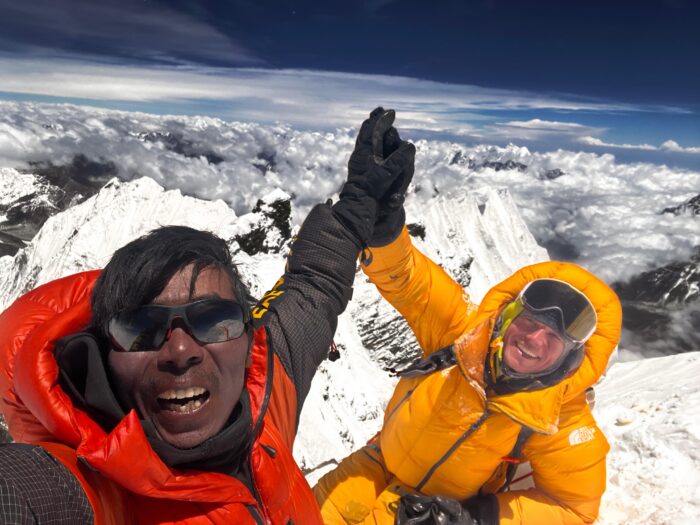
For Whiting, however, it's just the opposite.
"I would certainly choose to climb Nuptse out of the three due to the lack of crowds. It is more of a proper climb."
For the future, the British climber hopes to do more alpinistic ventures.
"I'd like to explore more remote regions and climb some smaller, less frequented peaks in alpine style on a small team, but I'm not a full-time mountain professional and have to juggle my job with these trips," he said.
Not for everyone
For those reading this story and wondering about following in Jay Whiting's footsteps, they should consider the difficulties of the Triple Crown. Ropes and oxygen will help, but they can't perform miracles.
"I think the Everest-Lhotse double-header is well established, and people are used to hearing about it. However, the wild card is Nuptse," Whiting said. "A problem at the summit ridge or the summit could have serious consequences if something went wrong. There are some very technical sections on the North Ridge of Nuptse, beyond what you'd find on Everest or Lhotse. Those tackling the climb would have to be prepared and experienced."
Whiting also noted that climbing the three peaks is utterly exhausting. "I trained for two years with expert coaching," he said.

The ultimate challenge
Now, imagine trying it without supplementary oxygen. The challenge would be huge, not only because of the exhaustion, cold, and technical difficulties, but also having to remain at nearly 8,000m for an extended time during the Lhotse-Everest leg.
Yet the impossible made possible is a motto among Everest climbers. In 2021, Kilian Jornet of Spain and David Goettler of Germany showed up in Everest Base Camp but kept quiet about their plans. Rumors hinted that they might attempt something never seen before: the so-called Horseshoe Traverse, summiting Everest, Lhotse, and Nuptse, without oxygen and along the ridgeline, instead of descending to lower camps.
The climbers finally retreated from the South Col without reaching any summit. (It was the year of COVID.) But it may be only a matter of time before someone dares to tackle this ultimate challenge.
Authorities in Sikkim, India, are demanding that Kangchenjunga, the world's third highest peak, be banned to climbers out of respect for local deities.
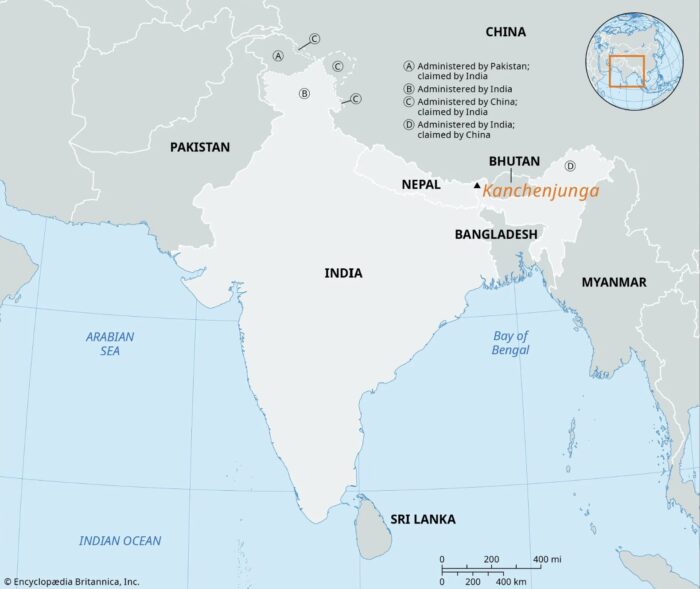
Stopped a few meters short
When British pioneers Joe Brown and George Band climbed 8,586m Kangchenjunga for the first time 70 years ago, they stopped some meters short of the highest point out of respect for the religious beliefs of the local communities in Sikkim. For them, the protective deity Dzoe-Nga, also worshipped as Pho-lha, lives on its white slopes.

For years, subsequent expeditions followed that tradition, but this sign of respect was eventually abandoned. Nowadays, climbers focus instead on ensuring that they reach the true summit of Kangchenjunga, which is easy to mistake for other points on its jagged ridge.
Sikkim route rarely climbed
Kangchenjunga lies in the northeastern corner of Nepal on the border with Sikkim (India) and is also very close to Tibet. The peak has four main climbing routes. Three are in Nepal, and only the eastern one goes up from Sikkim.
The Sikkim route has only been climbed three times. The most straightforward route, up the Southwest Face in Nepal, was the chosen line for several early attempts, and the one where the expedition led by Charles Evans succeeded for the first time in 1955. For decades, there were attempts and summits from the north side of the mountain, also in Nepalese territory, but the Southwest Face soon became the normal route and the one offered to commercial teams.
Last week, the Chief Minister of Sikkim, Prem Singh Tamang, asked India's Home Minister, Amit Shah, to ensure that the footprints of climbers no longer deface the slopes of Kangchenjunga.
Climbing Kangchenjunga from the Sikkim route has not been an option since 2000, when all ascents from Sikkim were officially banned. This is the first time that Sikkim authorities raised their voices about the matter since then. The problem is, Tamang wants the ban to extend to the entire mountain, including the routes in Nepal, not just from Sikkim. While the measure is unlikely to succeed, it does highlight the sensitivities around the mountain.
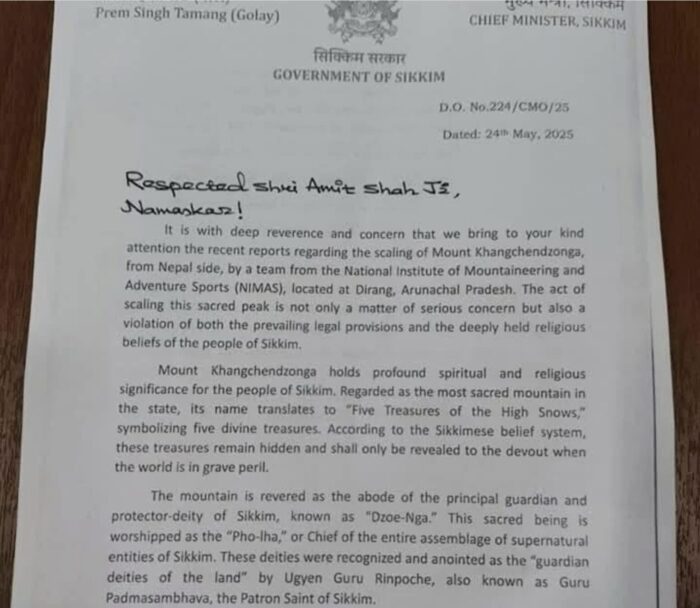
'Serious concern'
"Scaling this sacred peak is not only a matter of serious concern but also a violation of both the prevailing legal provisions and the deeply held religious beliefs of the people of Sikkim,” Tamang said.
He bases his demands on the Places of Worship (Special Provisions) Act of 1991, which prohibits expeditions to sacred sites, as well as Sikkim Government Notification No. 70/HOME/2001, which reaffirmed the state’s limited ban on summiting Kangchenjunga, Nenews.in reported.
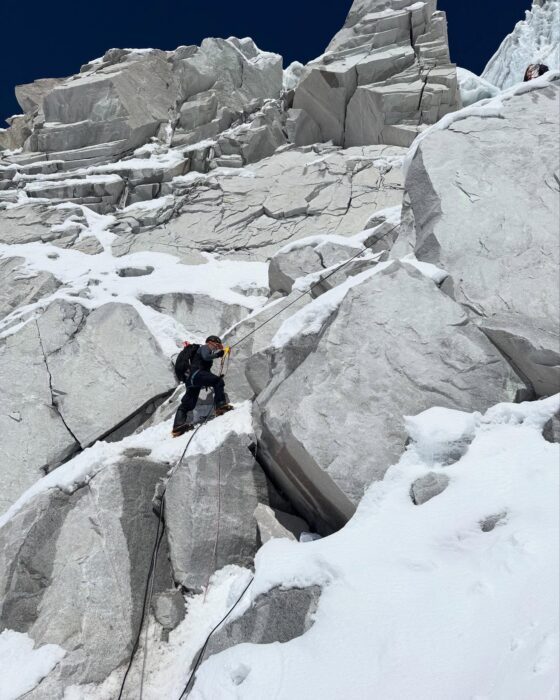
Indian summits prompted response
Ironically, the call for a ban was prompted by a climb launched by the National Institute of Mountaineering and Adventure Sports (NIMAS) of Arunachal Pradesh. On that Indian expedition, five members summited via the normal route in Nepal on May 18, together with their Nepalese guides. Other Indian climbers were also on the mountain, including those with a joint Nepali-Indian army expedition.
This year, about 30 climbers summited Kangchenjunga despite unstable weather. Others had to retreat due to harsh conditions. There were also some rescues, and one climber died while attempting to reach the top.
Nepal's Department of Tourism has no restrictions on the number of climbers on any mountain. In the case of Kangchenjunga, 78 permits were granted to foreigners this season. All climbers were supported by local guides and usually took advantage of brief periods of calm.

Kangchenjunga has become increasingly popular among commercial high-altitude climbers. Virtually all expeditions take the normal, Southwest Face route from Nepal. India cannot legislate on the part of the mountain beyond its borders, and it is unlikely that Nepal will do so.
Other banned peaks
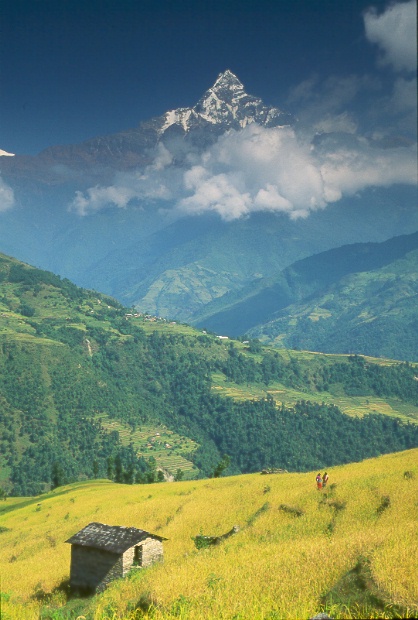
Nepal also has sacred peaks banned to expeditions. The best known is Machhapuchhre (6,993m) in the Annapurna region, considered sacred for the Gurung people and never climbed, as far as we know. Sherpas revere mountains, and while they agree to climb them, they always perform puja (offering) ceremonies to ask permission for passage from the mountain gods.
Similar cases of sacred mountains in nearby countries forbidden for climbers include Tibet's striking Mt. Kailash and Gangkhar Puensum in Bhutan. At 7,570m, the latter is the highest unclimbed peak in the world, and it should continue to remain so for many years.
According to some sources, the silhouette of Kangchenjunga's summit points resemble the shape of a sleeping Buddha, especially when seen from the southwest. In his letter, Chief Minister Tamang recalled that the name of the mountain means the Five Treasures of the High Snow. It refers to five hidden virtues that will only be revealed to devotees if the world is in serious danger.
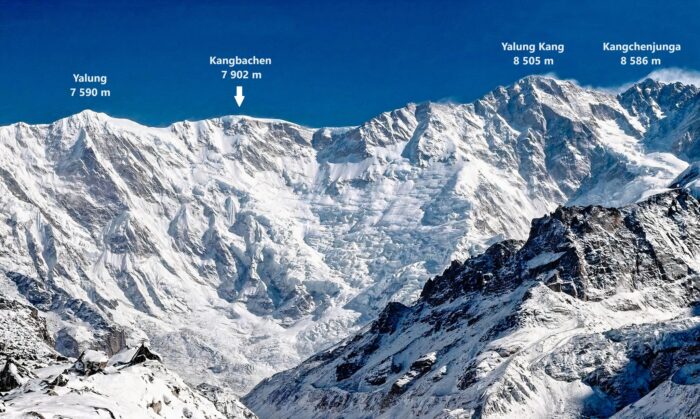
In his extensive report about the Kangchenjunga summit area for 8000ers.com, Rodolphe Popier ends up with the following words:
The magnetic attraction of Kangchenjunga will keep attracting mountain lovers from all over the world, maybe for something more than climbing and/or peak-bagging? As Doug Scott recalled it in his last book, [Kangchenjunga] is the 8,000m summit with the greatest religious significance.
A small number of alpine-style teams in Pakistan are currently acclimatizing. The Spantik team has already moved above Base Camp, while Denis Urubko and Maria Cardell are doing their rounds in the lesser ranges near Skardu before attempting a new route on 8,126m Nanga Parbat.
As a pure alpine-style ascent, it makes sense that they acclimatize on different peaks rather than on their targeted route. Urubko also believes that rotations at high altitude cause a climber to lose fitness.
"The climber gains altitude step by step but becomes weaker," he said in an interview with Mountain.ru. "On the contrary, intense hikes or ascents with a large altitude gain [in lesser ranges] allow you to keep your muscles in good shape."
Mid-altitude hikes and climbs
Skardu's new international airport is the gateway for all expeditions to the Karakoram and the Nanga Parbat region. The town lies at 2,228m and features plenty of straightforward peaks of 4,000m to 5,000m nearby. Some are close enough to summit on day trips.
After arriving last weekend, Urubko and Cardell hiked to 3,101m. The following day, they climbed a 4,560m peak.

Urubko's personal project
In a previous email shared by Mountain.ru, Urubko noted the acclimatization phase would take them a couple of weeks. Then they'll move to the northern, Diamir side of Nanga Parbat to attempt a new route the ace Russian climber has been planning for a while.
This is the first time Urubko has returned to the higher mountains after he suffered frostbite after falling in a crevasse on a winter attempt to Gasherbrum I two years ago. Urubko has made it clear that while his wife will start with him, he is also ready to climb it on his own.
"If Masha [Maria Cardell] can’t keep up, I’ll try it solo," Urubko wrote in his email.
Family issues prevented Cardell from joining until last week, but she is at least partly acclimatized, as she worked all winter as a ski patroller at a resort located between 2,200m and 3,300m in Spain's lofty Sierra Nevada. But a new line on Nanga Parbat is a major endeavor, and the Diamir face is huge, from 4,900m of the base of the wall to the summit at 8,126m. In some sections, the avalanche risk is considerable.
Spantik
Further north, in the Shigar area, a French-Pakistani team led by Mathieu Maynadier is ready to start climbing 7,027m Spantik.
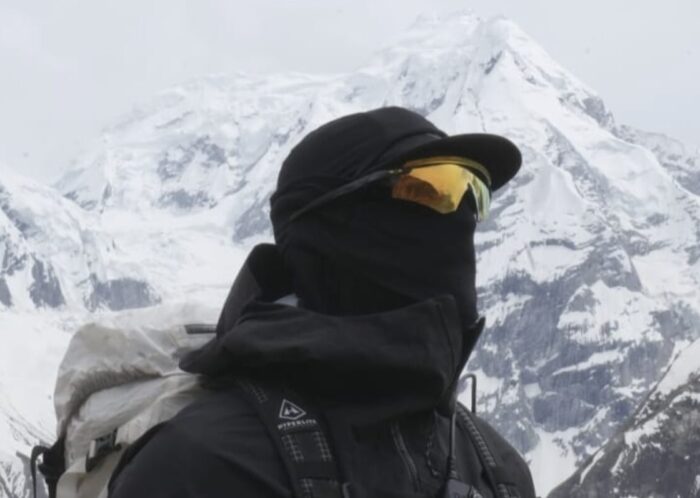
They set off from base camp at 4,200m last weekend, after a rather rough approach trek over a glacier, which included some difficult passages among crevasses. It was hard to find a safe passage for the entire convoy, which included the climbers, two cooks, 42 porters, 8 chickens, 1 goat, 17kg of rice, and all the camping and climbing equipment.
Maynadier is teaming up with local climber Muizz Ud Din, as well as fellow Frenchman Loury Lag, and videographer Nathanael Sapey-Triomphe. Drone operator Ozair Khan will film the climbers from base camp.
.
Hellias Millerioux of France has also posted some photos from his below-the-radar expedition. He is currently on an approach trek but has not shared details about the peak.
Last week, ultrarunner Tyler Andrews launched a last-ditch attempt to achieve the fastest-ever no-oxygen climb on Everest. It was his third try, just three days after a previous one, and with the mountain about to close. After hours without communication and his live tracker apparently not moving, his team shared the news: Tyler had turned around at 8,450m.
Now somewhat recovered from an exhaustion he says he has never before experienced, Andrews explained to us what many were wondering: What happened up there?
Why the second, windy attempt
Before getting into what happened on May 27 on Everest, let's first make sense of why he went up on May 23-24, despite high winds raking the mountain. Andrews, 35, said his reason was the same that prompted Karl Egloff, also pursuing an Everest FKT (Fastest Known Time), to start his own run just a couple of hours before Andrews. The Icefall Doctors wanted to close the route on May 25.
"They said the Icefall was moving too fast, there had been some collapses, and it was not safe," says Andrews. He believed his only option was to go up or go home.
Andrews left Everest Base Camp on May 23 at around 8 pm local time. For safety, he started using supplementary oxygen at Camp 2.
"Meteorologists, doctors, my expedition leader, they all told me: Do not go up without oxygen, it is too cold, too windy, you will not reach the summit, and you will lose fingers and toes."
That same day, Karl Egloff of Ecuador started his own record attempt, without supplementary oxygen. Egloff turned around shortly after Camp 3.
For Andrews, too, the wind ultimately ruled the day. Shortly after Camp 4, his expedition leader, Dawa Steven Sherpa, made the call to abort Tyler's attempt and withdraw all his team from the mountain because of the high winds on the upper sections.
Tyler descended to Base Camp during the night of May 24 and flew to Kathmandu the following day. When he hopped on the helicopter, he was sure there would be no more opportunities. But back in Kathmandu, something unexpected happened.
"We learned that the big Indian Army team had failed on their summit push on May 23, also due to high winds," explained Andrews. "Because of their influence, [the Icefall Doctors would keep] the mountain open three or four days more."

Snap decision
I didn't feel like I had left all I had on the [previous] attempt, so when I returned to Kathmandu, I had a good night of sleep and woke up the next morning to hear that the Indian team was going on the 27th in good weather. I immediately started thinking that another attempt was feasible and after a whole bunch of phone calls to Dawa, my family, and my team...we decided, well, ok, let's give it a go!
Andrews flew back to Everest Base Camp and set off that same night, May 26, on a no-oxygen run toward the summit of Everest. Unlike Andrews, Karl Egloff decided not to try again and went home.

Disaster at 8,000m
"[On the final attempt,] everything went quite well until Camp 4," Andrews explained.
He admits that his pace slowed between Camp 3 and Camp 4, because on this last-minute attempt, he had less support and had to carry a much heavier backpack containing his high-altitude equipment. Instead of crew members at all the camps, as on his previous tries, on May 27, he had a support team at Camp 4 for emergencies, but otherwise, he was alone. That slowed him down a little, but otherwise had no bearing on his final decision.
Rather, something went wrong just after leaving Camp 4 (7,950m), some twelve-and-a-half hours after departure.
"I had one of my gels and vomited it immediately, which is something that had never happened to me before. Maybe it was the altitude or exhaustion, but probably I should have returned to camp and tried to eat something else."
But Andrews chose to continue up, and soon he became unable to manage his remaining energy. "On all ultra-marathons, losing the last two hours of nutritional income means you're in big trouble," he explained.

"Honestly, when I left Camp 4, I was sure there was no way I was not making the record," Andrews said. "In the worst-case scenario, getting to the top would take me seven to eight hours, and that would still be under the record. But it was just so much slower than that."
Faces on the snow
"I ran out of gas, I was totally fried up there," he admits. "Also, at that point, I had lost communication, so it was a very lonely stretch. I was above the Balcony when I realized I was not going to reach the summit that day, and I didn't even have contact with Base Camp."
Still, he hesitated, but hallucinations finally convinced him to retreat.
What really decided me to make the call was that I started having hallucinations from fatigue. I would look at the snow and see geometrical shapes and faces, stuff like that. I knew these things were not there but I still could see them, and that was pretty alarming.
In addition, the route above the Balcony is technical and exposed. I had never been there before and I was totally on my own, with no one on the mountain. I decided I couldn't have the record safely in that state, and my priorities are getting the record AND getting back down safely; both things equally important.
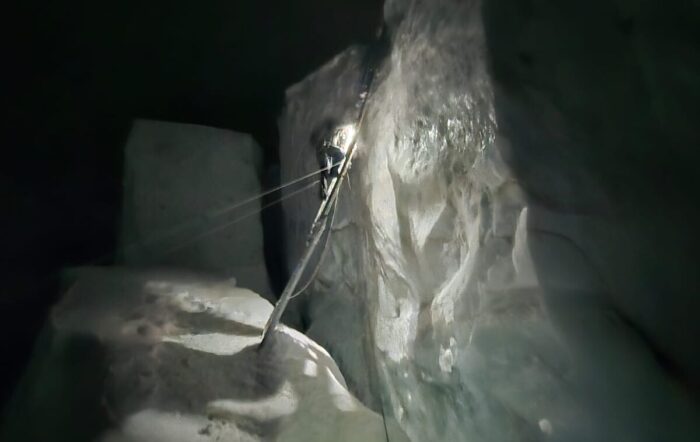
Andrews then turned around and made his long way back to Camp 4. Here, he rested and then continued down in order to cross the Icefall and reach Base Camp the following night.
No external pressure
Andrews denies he felt under any external pressure to bag the record.
"If anything, some people suggested I shouldn't do the last attempt. All the pressure came from myself. I really, really wanted to do it."
As for the physical strain of the two previous attempts, Andrews said he usually recovers quickly from intense efforts. He also felt that he had not used all his energy during the second attempt because the push was halted before he reached the summit.
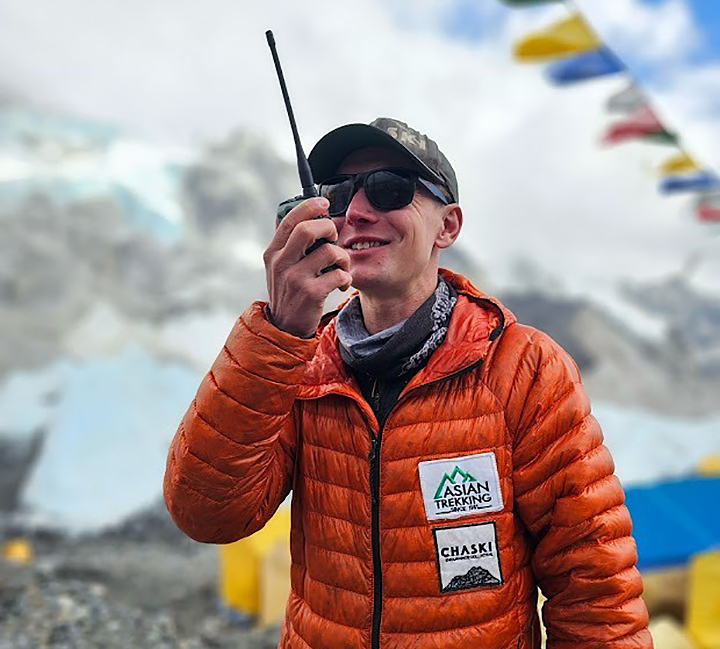
While Andrews and Karl Egloff have avoided commenting on each other, their May 23 attempt to run up Everest highlighted this as a race between two contenders. However, Andrews refuses to look at the challenge that way.
Honestly, I never saw this as a competition; I knew Karl [Egloff] was there, I knew he had his own team and was attempting a similar FKT, but I had to keep focused on myself and my team. You can't control what others do. It is not different from a marathon, in which you're obviously not the only participant, but the best way to go is just try to run your best race.
Same place next year?
After the impressive but heartbreaking effort, does Andrews want to try again in the future?
"If I can make it work financially, I will definitely be back," he replied. "It is a huge cost in terms of money, energy, and time, but it's an important project for me. I am 100% sure I am capable of it."

Indeed, Everest is far from becoming cheaper or less commercial. Yet Andrews admits it is a very special place.
"I still feel that the Khumbu Valley and these mountains, which are the tallest on Earth, are very, very special. That said, there are an awful lot of people there, some of whom show less respect to the mountain and nature than I'd like to see. But I think most are there because they want to push themselves and experience being in such a unique place. To me, watching others strive tremendously hard for something they care about is super meaningful."
Yesterday's Everest Day celebrations in Kathmandu marked both the 72nd anniversary of the peak's first ascent and the official closure of the 2025 season.
Overall, the season featured uncertain weather and often jet-stream winds on the upper slopes. Otherwise, everything went largely according to plan at a time when high-altitude climbing is increasingly commercialized and less adventurous.
Goodbye till 2026
The Sagarmatha Pollution Control Committee marked the official closure with a video and words of appreciation for the tireless Icefall Doctors.
So far, no one has announced Everest expeditions for this fall. The mountain is usually harder to climb after the monsoon. This year, it will also be significantly more expensive, as the new permit fees come into effect. Beginning in the fall, the permit for climbing Everest will increase from $11,000 to $15,000 per person. Considering that an Everest expedition costs from about $30,000 to well into six figures, it is unclear whether this permit increase will impact the number of climbers next year.
The Sagarmatha Pollution Control Committee (SPCC) is doing a great job controlling the amount of garbage that climbers leave on the mountain, especially in the upper camps. While there remains a lot of work to do, Everest is getting cleaner.
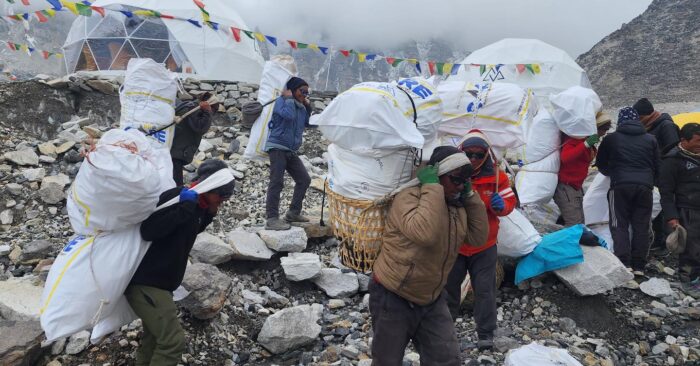
Summit figures
While the official number of summits on the South Side is not yet released, Himal Gautam, director at Nepal’s Department of Tourism (DoT), told Everest Chronicle that 694 individuals summited from the Nepali side throughout the season.
"This included 257 foreign climbers, nine Nepali nationals with climbing permits, 421 Sherpas and high-altitude guides, and seven members of the rope-fixing team," the official said.
Adding up the summits reported on the North Side, where all teams were successful, the final summit tally on the mountain should approach 800.
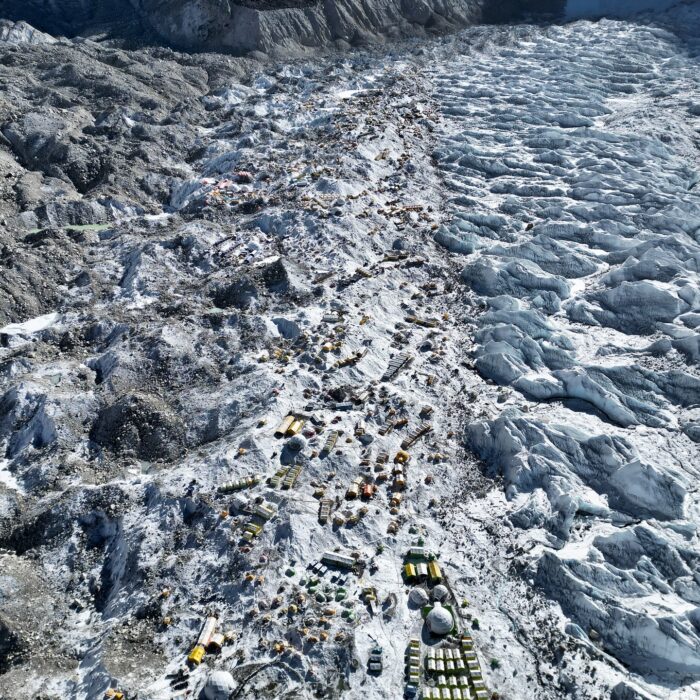
Like every year, the Everest experience has featured long lines at times, especially during the few days of predictably good conditions. Some teams chose to go on windier days or waited until the last minute when most groups had left. The biggest crowds at the summit occurred on May 18. The best summit day was May 27, with mild temperatures, no wind, and nearly no one else around.
Increasing temperatures made the route through the Khumbu Icefall more dangerous. Teams were advised to attempt the summit or at least be above Camp 2 by May 25.
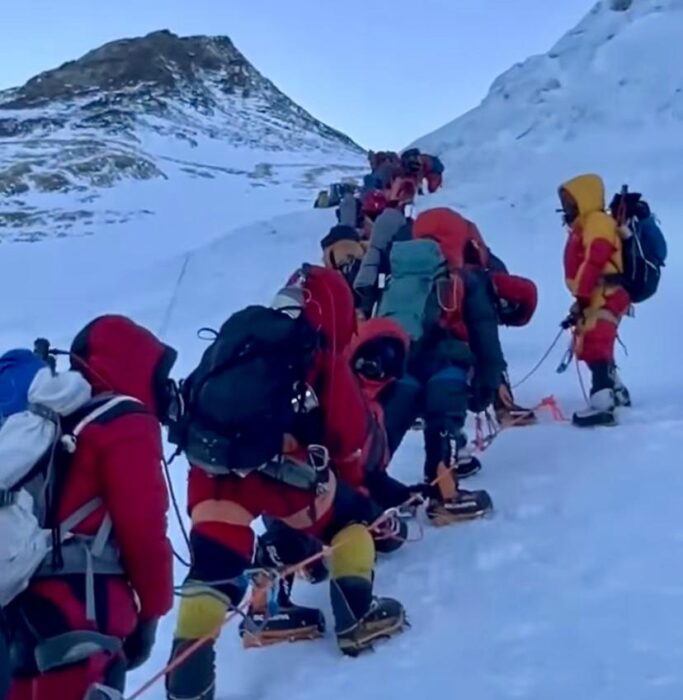
According to the Nepal Department of Tourism, 468 permits were granted to climbers from 57 countries. A similar number of climbing Sherpas assisted them.
Tranquil North Side
On the North Side, all the international groups succeeded after a Chinese team fixed the ropes to the summit. Each group followed its own pace, and the summits were distributed over several days, with no crowds to report.
Alpenglow was the last to summit, and its 11 foreign climbers and 11 Sherpas made the top on May 27, the best day on both sides of the mountain. They had Everest to themselves.
"There was not a breath of wind, and [it was] shockingly warm," leader Adrian Ballinger told ExplorersWeb. "This was my 10th summit, and I had the fun opportunity to climb from Advanced Base Camp to Camp 2 on day 1, and Camp 2 to the summit on day 2, skipping Camps 1 and 3," he said while on the road back to Lhasa today.

Casualties
Three people died on the mountain above Base Camp, and none of these deaths occurred because of climbing accidents or avalanches. Pen Chhiri Sherpa of Nepal died of a cardiac arrest at Camp 1. Subrata Gosh of India fell sick and passed shortly after starting his descent, and Philipp Santiago of the Philippines died at Camp 4 before heading up to the summit. Two other climbers died while attempting Lhotse.
We know of no deaths on the North Side.
While still tragic, this number is low compared to previous years. Superior training, better equipment, endless supplies of oxygen, increased support staff, more skilled guides, and better weather forecasting have made the mountain safer than ever. However, risks remain high, both due to external hazards and the climbers' own limitations.
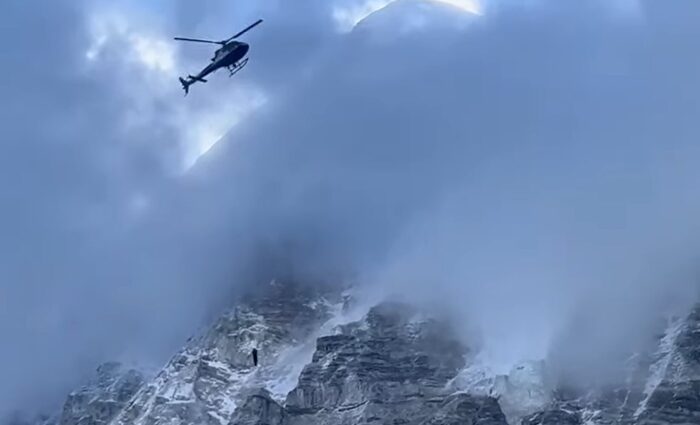
There was reportedly a significant number of aerial rescues, although agencies, rescuers, and authorities tend to keep exact numbers quiet. This omerta is too bad, because statistics on the reasons for and circumstances of rescues would help prevent such problems in the future.
Local records
In addition to a few age records, guides working on the mountain over the years reached an impressive number of Everest summits. Kami Rita Sherpa, still going strong at 55, did his 31st and Kenton Cool, 51, of the UK stood on top for the 19th time.
Some Sherpas summited several times in the same season. Tashi Gyalzen Sherpa did so four times, first as a rope fixer and then three other times with clients.
Fast expeditions were likely the story of the 2025 season. The so-called Xenon climbers team, outfitted by Lukas Furtenbach, endured early criticism for their intention to use one more artificial aid to get up poor old Mount Everest. Yet all four (who used live trackers) summited on May 21, five days after leaving London, and made it home in less than a week, as planned. Besides the Xenon therapy, the team underwent intensive hypoxic training at home, flew to Nepal when the weather and the route were ready for a single summit push, and were medically monitored during the ascent and descent.

Andrew Ushakov, a client with Elite Exped, reportedly completed his climb from NYC to the summit in four days, using supplementary oxygen from Base Camp and two Sherpa teams to support him, but without Xenon or dexamethasone. We are currently checking the facts of that climb.
No-O2
Anja Blacha of Germany summited Everest without bottled oxygen or personal Sherpa support. This was just the second no-O2 ascent this season, and her 12th 8,000'er without supplementary oxygen. She is the 15th female to summit Everest in this style. Blacha had also climbed Annapurna and Dhaulagiri this season. Local outfitters only reported her Everest climb after she had finished it.
In addition to Blacha, the only other successful ascent without bottled oxygen on Everest this season (that we know of) was Patricio Arevalo of Ecuador. Other climbers tried but eventually turned to oxygen or retreated. Among the latter was Marcelo Segovia, also from Ecuador, who had to turn around after spending two hard, oxygen-deprived nights at Camp 4 due to high winds.
Norway's Kristin Harila posted last week on Instagram that she had attempted to climb Everest without oxygen but didn't reach the summit.
Secrecy
Keeping climbing projects quiet and then sharing the news only when finished (and often, only if the result is positive) is a growing trend. Still, whether it's a record quest or a no-O2 attempt, providing sufficient details either before, during, or after is still necessary to avoid raising doubts. Unfortunately, false claims have occurred throughout Everest's climbing history, so clarity and transparency remain vital.
Live tracking, in particular, adds credibility and also inspires audiences to follow an expedition.
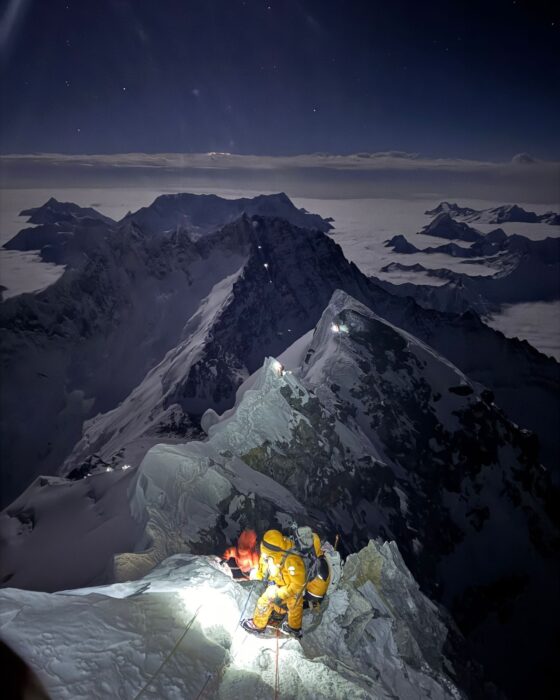
The runners
This year, with no alpine feats attempted on Everest, attention turned mainly to alternative challenges, most of them based on speed.
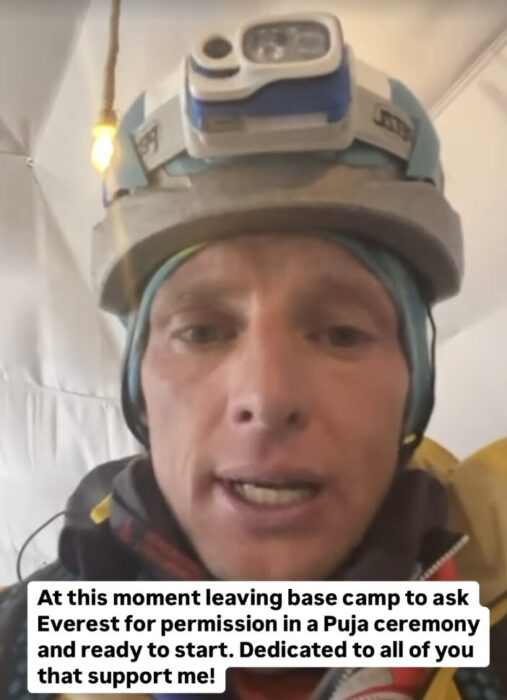
Professional trail runners Tyler Andrews of the U.S. and Karl Egloff of Ecuador each tried to achieve a Fastest Known Time on Everest. Bad conditions thwarted both athletes. Egloff tried on May 23, and Andrews tried three times unsuccessfully.
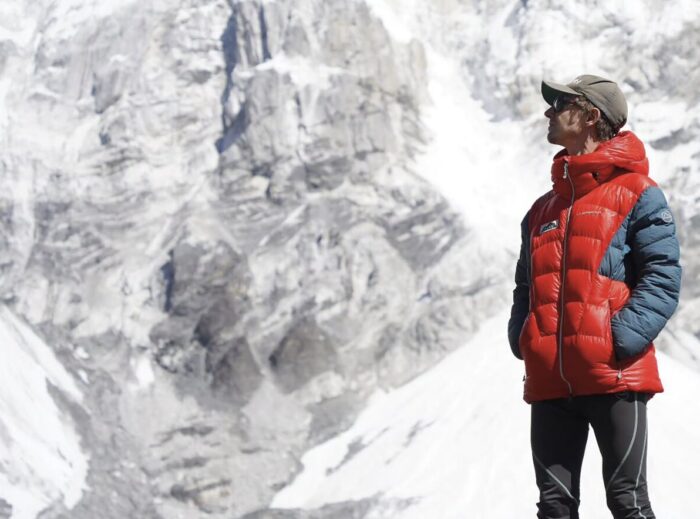
On his latest attempt, Tyler Andrews reached 8,300m before retreating. He is still recovering from the effort.
"I have never been that exhausted in my life," he told Explorersweb today. We will post further details on his climb soon.
The wingsuit flight attempt
Tim Howell of the UK attempted the highest-ever wingsuit exit, from 8,300m on the Lhotse ridge and down the sheer South Face of Lhotse toward Chukhung village. The May 21 attempt failed because of relentless winds on the ridge, but it involved some epic moments and a truly alpine approach.
Guides Jon Gupta and Tom Seccombe fixed an alternative route to the chosen point and then waited for the right conditions. Hoping for the wind to abate in the afternoon of May 21, the team left their high camp at 7,700m in the early hours and went to the end of the fixed ropes. Gupta and Seccombe then fixed the last three pitches to the exit point by crossing to the South Face of Lhotse and reaching the top of a pillar at 8,300m.
Tim Howell, cameramen Brodie Hood and Jake Holland, and four Sherpa climbers, waited patiently at a ledge some 50m below. Unfortunately, the clouds never parted, and the team eventually retreated.
Denis Urubko of Russia has confirmed he and his wife Maria Cardell will attempt Nanga Parbat (8,126m) via a new route in the next few weeks.
Yesterday, we wrote about how the improving situation in Pakistan could prompt climbers to visit this season, especially smaller, alpine-style teams.

Urubko has not yet revealed details about the route, but he made his priorities clear when he spoke about his plans during a lecture in Italy in March: “No route has ever been opened without oxygen and in authentic alpine style." At that moment, he said his goal was to open a new route on the mountain's Diamir Face.
Two years badly frostbiting his fingers while trying to open a new route on winter Gasherbrum, Urubko is back to high-altitude mountaineering. He is also the first climber attempting a new route on an 8,000m peak this year.
Urubko announced the expedition on his 52nd birthday.
Mountain master
Denis Urubko has summited all the 8,000m peaks without supplementary oxygen or Sherpa support. He also has two first winter ascents, on Makalu (with Simone Moro) and Gasherbrum II (with Moro and Cory Richards).
Urubko has opened new routes on the highly difficult south side of Cho Oyu, Manaslu, Broad Peak, and Gasherbrum II (solo). He has also made a name for himself — and friends around the world — for the many rescues he has performed in the Himalaya.
One of them made him an international hero and earned him France’s Legion of Honor. In 2018, he and Adam Bielecki of Poland abandoned their own attempt on winter K2 and hurried to Nanga Parbat to launch the nearly impossible rescue of Tomasz Mackiewicz and Elisabeth Revol. They couldn’t reach Mackiewicz but saved Revol’s life.
Tensions between India and Pakistan have abated after the flare-up in early May, and some alpine-style teams are already tackling difficult routes in Pakistan. At the same time, outfitters have confirmed their commercial expeditions to K2 and Broad Peak and reached a compromise with local authorities on the new price of climbing permits.
At least three teams are currently working on alpine-style routes on 6,000m and 7,000m peaks in the Karakoram.
The first team to reach Pakistan was the American expedition to 7,388m Ultar Shar in the Batura Muztagh range. Ethan Berman, Maarten van Haeren, and Sebastian Pelletti had their original flight cancelled during the political turmoil but boarded the first available plane once the situation calmed down. The team has been in Pakistan for the last two weeks.

French alpinists
Piolet d'Or winner Elias Millerioux has not revealed his goal or his team, but he is currently setting up Base Camp on the Momhil Glacier in Shimshal. This is where the late Kazuya Hiraide and Kenjo Nakajima achieved two of their most applauded first ascents, on Karun Koh and Shispare. Last year, Millerioux and fellow Chamonix guide Yannick Graziani attempted a new route up the southeast ridge of Trivor Peak in the nearby Batura range.
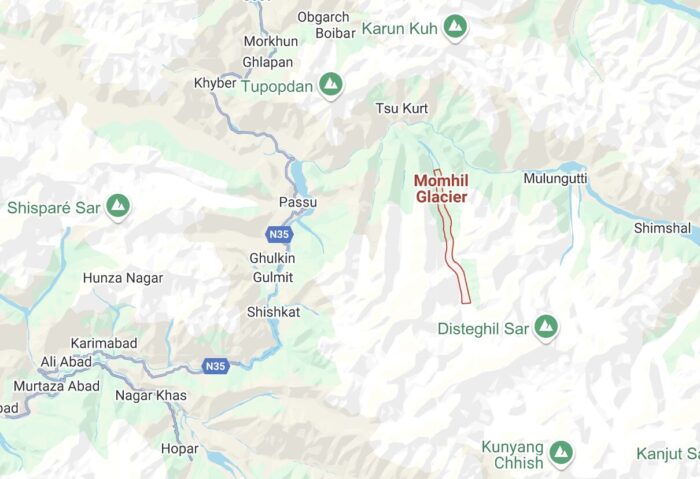
French guide Mathieu Maynadier is attempting a new route on Spantik via the Chogho Lungma Glacier. He has again teamed up with local climber Mueez Ud Din.
"At one point, the expedition was on the verge of cancellation due to recent Pakistan-India tensions, which led to many teams pulling out, but against the odds, we’re here," Ud Din wrote on social media.
Ud Din recognizes that this kind of alpine-style expedition is "the beginning of something bigger for Pakistan’s mountaineering community."
They started the 35km approach trek three days ago from the village of Arandu and set up their Base Camp yesterday at the foot of Spantik.
"We’re the first team to break trail this season," Maynadier wrote. "The route wasn’t always easy, with many crevasses to navigate, but the whole team and the porters arrived safely."
Climbing fees confirmed
Several local outfitters have told us about the compromise reached over climbing permit fees. An official announcement that tripled the cost of 2025 fees discouraged many climbers and concerned local outfitters.
Outfitters and the authorities have now agreed to split the difference, so the final figure falls midway between the authorities' original proposal and the current low rate. As we announced earlier, the permit fee for K2 is $3,500 per climber, and the rest of the country's 8,000'ers cost $2,500 each.
Below, an updated list of prices for climbers and trekkers, with the fee initially proposed by the authorities and, on the right, the agreed-upon final price for this season:

While several outfitters in Pakistan confirm that they are running climbs to K2 and Broad Peak, there is no news yet about any Gasherbrum climbs. As for Nanga Parbat, where the season starts in June, the situation is uncertain. Several teams canceled their trips when the political conflict escalated in early May. The mountain will likely be pretty lonely, but a few teams may still apply for permits at the last minute and enjoy the peak without the usual crowds.
One potential entrant is Denis Urubko. He has not yet confirmed this, but he recently said that he intends to open a new route on the peak's Diamir Face, probably with his wife Maria Jose Cardell. For the time being, Urubko is training hard to get as fit as possible, "just in case."
The fact that the only team with serious plans for Nanga Parbat is a pair of alpinists could signal a limited return of old-fashioned expedition climbing on at least one 8,000m peak.
It's already dark on Everest, but Tyler Andrews is still descending. He intends to reach Base Camp tonight after retreating just shy of the summit on his no-oxygen speed record attempt.
At the time of posting this story, he was nearing Camp 2. Details about why he turned around above 8,400m will have to wait until Andrews and his team make it safely down and get some rest.
Climbers are being advised to abandon the mountain as soon as possible, as the Khumbu Icefall is deteriorating and has become increasingly dangerous. Most will try to cross it tonight, during the coldest hours.
Meanwhile, Andrews' progress down can be tracked live here.
No-O2 female ascent
Anja Blancha of Germany summited without bottled oxygen today, according to outfitter Pioneer Adventure. She was part of the team that left Camp 4 yesterday, but there are no further details on Pioneer Adventures' or the climber's website.
Blacha keeps a low profile but has an impressive resumé. She had previously summited Everest from both sides, but with supplementary oxygen. Now, Everest has become her 12th 8,000'er without bottled O2. She has only Lhotse and Shishapangma to go to become the third woman ever to climb all 14 without bottled oxygen, after Gerlinde Kaltenbrunner of Austria and Nives Meroi of Italy.
Blacha has stepped up the pace and notched several 8,000'ers in the last two years. In 2024, she summited Makalu, Kangchenjunga, Manaslu, and Cho Oyu. This spring, she did Annapurna, Dhaulagiri, and now Everest. However, she said nothing about her planned no-O2 climb on social media.
Something has prompted Tyler Andrews of the U.S. to turn around when he was nearly touching the summit of Everest. After a 17-hour, non-stop run without supplementary oxygen from Base Camp to above the Balcony (8,400m), he has decided to go down.
'All well in the mountains'
Andrews, 35, left Base Camp yesterday at 9:08 pm Nepal time. Chris Fisher supported him until Camp 2. There were also support teams in the higher camps. Around noon today, he was above 8,000m. At 8,200m, Andrews sent a text message over his InReach reading: "All well in the mountains." This suggests that Andrews would finally succeed on his third attempt this season to speed climb 8,849m Everest.
Concern began among the thousands of followers checking the climber's location on his tracker during the afternoon in Nepal, when his InReach device stopped sending a signal. Andrews' team also had problems connecting with him over the radio, but were aware that he was moving. They noted that 16 hours into his effort, the runner was approaching the Balcony. Shortly afterward, the team finally connected with him and learned -- and shared -- the bad news:
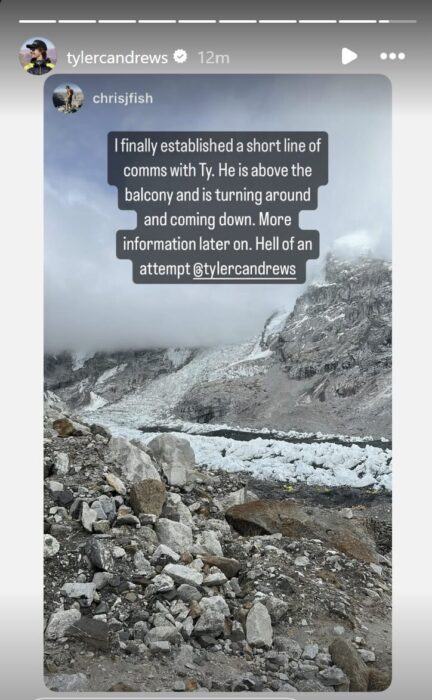
Some 20 hours after departure, Andrews' tracker shows him on his way down. But if his team's information is accurate, the signal does not show the highest point he reached:
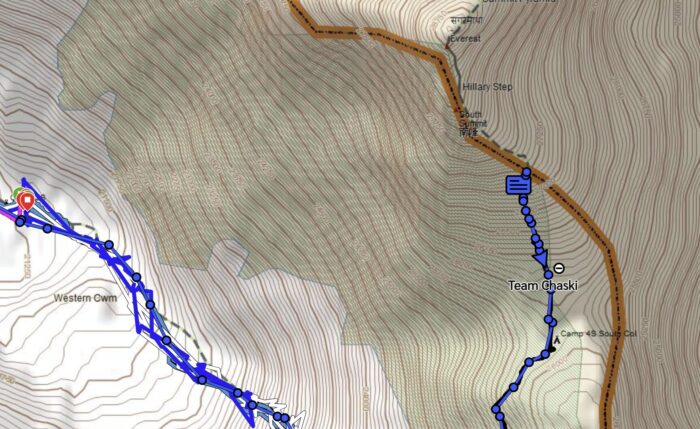
Third attempt
Andrews was on his third attempt to speed climb Everest.
On the first attempt, on May 10-11, Andrews turned around slightly above Camp 3, due to problems with his equipment.
Last Friday, he tried with supplementary oxygen, but the high winds at the summit proved too strong to let him finish. That day, Karl Egloff of Ecuador also attempted to bag the Everest FKT (Fastest Known Time) without oxygen. Egloff aborted shortly after Camp 3.
Both climbers officially called their expeditions off, but Andrews changed his mind unexpectedly yesterday. Weather forecasts promised good conditions today. He decided at the last minute to give Everest a last try and set off that same evening.
Andrews was trying to beat the previous mark set by Kaji Sherpa, who climbed from Base Camp to the summit in 20 hours and 24 minutes in 1998. Kaji's ascent was controversial since the climber used oxygen on his way down. However, Andrews believes that how a climber performs on descent is not significant if the planned record run ends at the summit.
"In my opinion, if you get to the top, you get to the top," he told ExplorersWeb. "I don’t mind how you go down. However, I understand people may have different criteria."
Andrews still has a long way to go to Base Camp, but there are support staff at several points of the route. Other climbers are also still on the mountain. We will update you when we learn what caused him to turn around.